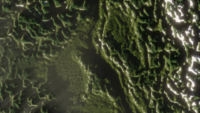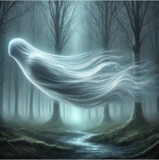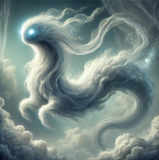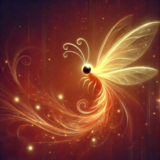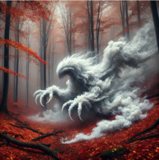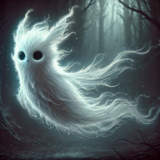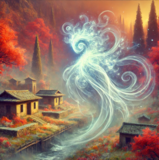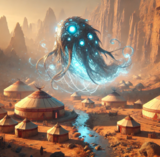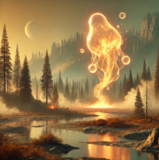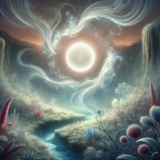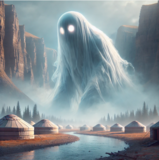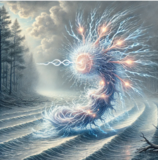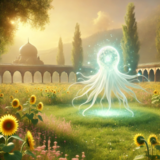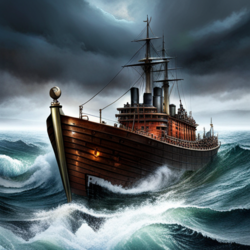Strait of Haifa: Difference between revisions
Newzimiagov (talk | contribs) No edit summary |
NewZimiaGov (talk | contribs) |
||
| (314 intermediate revisions by 6 users not shown) | |||
| Line 1: | Line 1: | ||
[[ | {| class="infobox vcard geography" style="width:300px; font-size:83%;" | ||
[[ | | colspan="2" style="text-align:center;" | <big>'''The Strait of Haifa'''</big><br><br>'''''The Eastern Vine / The Great Vine''' | ||
The '''Strait of Haifa''' is the narrow, elongated sea which separates central and | |- | ||
| colspan="2" | | |||
|- | |||
|colspan=2 align=center | [[Image:Strait.png|125px|Location of Adarma|frameless]] | |||
|-class="mergedtoprow" | |||
|align=left |'''Location''' ||align=left | Eastern [[Keltia]] | |||
|-class="mergedrow" | |||
|align=left |'''Coordinates''' ||align=left | | |||
|-class="mergedtoprow" | |||
|align=left |'''Type''' ||align=left | Rift Valley | |||
|-class="mergedrow" | |||
|align=left | '''Native Name''' ||align=left | Misc. | |||
|-class="mergedtoprow" | |||
|align=left |'''Basin Countries''' ||align=left | [[Alperkin]], [[Bassarids]], [[Natopia]], [[Jezeraah]], [[Imperial Federation]] | |||
|-class="mergedtoprow" | |||
|align=left |'''Minimum Width''' ||align=left | 43.2 km | |||
|-class="mergedrow" | |||
|align=left |'''Maximum Width''' ||align=left | 384 km (Lake Morovia) | |||
|-class="mergedtoprow" | |||
|align=left | '''Islands''' ||align=left | | |||
|-class="mergedrow" | |||
|align=left |'''Settlements''' ||align=left | | |||
|-class="mergedtoprow" | |||
|align=left |'''Abbreviation''' ||align=left | SoH | |||
|} | |||
The '''Strait of Haifa, '''otherwise known as the '''Vine of Keltia''' or the '''Eastern Vine,''' is the narrow, elongated, shallow sea which separates central and eastern [[Keltia]]. The Strait is situated between longitudes 100E and 130E, and latitudes 20N and 70N. | |||
Today the Strait of Haifa is dominated by commerce between the states which constitute the [[Maritime Markets of the Strait of Haifa]]. With that said, piracy is extremely common in the region, especially in regions which lie to the south of [[Lake Morovia]]. | Today the Strait of Haifa is dominated by commerce between the states which constitute the [[Maritime Markets of the Strait of Haifa]]. With that said, piracy is extremely common in the region, especially in regions which lie to the south of [[Lake Morovia]]. | ||
Countries which | Countries which have claimed territory bordering the Sea of Storms include: the [[Haifo-Pallisican Imperial Trade Union]], [[Alperkin]] and [[Natopia]], and most recently, the [[Imperial Federation]]. | ||
: ''See also: [[History of the Strait of Haifa]]'' | |||
==Geology== | |||
[[File:StraitGreen.png|200px|thumb|left|An aerial photograph of the Lake Morovia and the central Strait of Haifa.]] | |||
The Strait of Haifa is a dormant continental rift zone in eastern Keltia which was formed when the [[East Keltian Continental Plate]] diverged from the [[Laceran Continental Plate|Laceran]] and [[Caledonian Continental Plate|Caledonian]] plates. | |||
==Southern Strait of Haifa== | ==Southern Strait of Haifa== | ||
The Southern Strait of Haifa lies to the south of Lake Morovia, and connects Lake Morovia to the [[Corprian Ocean]]. In terms of climate, the Southern Strait of Haifa is hot and semi-arid or arid. To that extent, the region's southernmost reaches lie within the bitterly hot [[Eastern Mykonos Desert|Eastern Mykonos]], and the rocky [[Thalassapolis Desert|Thalassapolis]] deserts. In addition to its harsh, unforgiving climate, the Southern Strait of Haifa is home to a large number of very powerful pirate communities which operate out of the [[Port of Blore Heath]]. Most notable of these communities is the [[Port of Mylecia|Bacchian Vine Fleet]], a band of pirates who sail upon ships made from living vines, who - like most of the religious communities along the Strait of Haifa - worship the god of wine and ritual madness. | |||
Major active cities along the Southern Strait of Haifa leading to the 1700's include [[Blore Heath]], [[Mylecia]], and [[Jogi]]. Inactive, or independent city-states include [[Fort Itainen]], [[Bursesti]], [[Newstone]], [[Lewisburg]], and [[Nouvelle Geneve]]. These latter cities are especially vulnerable to attack by pirates, such as those mentioned above, as well as by the giant fishermen who inhabit the coastal shore-lines of the Thallasopois Desert, who sometimes take exception to the high commercial traffic in the region, which is known to disrupt their efforts to catch the whales, sharks, and dolphins on which they subsist. These myriad challenges resulted in a relative, protracted decline in the number of independent city-states along the Southern Strait. Eventually, the [[Imperial Federation]] took limited control of the inland portions of the Strait near [[Lake Moravia]] and the southern Keltian coastline from {{AN|1718}}. | |||
The Southern Strait is regarded as the birthplace of [[Stripping Path|Bassaridianism]]. | |||
==Navigation== | |||
==Lake Morovia== | ==Lake Morovia== | ||
[[File:Abeisarch23.jpg|200px|thumb|right|Dozens of ancient Amasebéiri del hed Amash stand tall over the Abeisan Archipelago, the group of islands which marks the eastern boundary of Lake Morovia. ]] | |||
Despite its name, and its depiction on most official maps as a lake, Lake Morovia is not a lake but a vast swampland which sits in the heart of an ancient, dormant super-volcano. With that said, Lake Morovia is a large body of fresh water which drains directly into the briny Strait of Haifa. Accessible in only certain locations to large sea-going vessels, Lake Morovia is a foreboding land of twisting waterways and wetlands which has historically served as the home of notable nations such as [[Ocia]] and [[Haifa]]. Located in the center of the temperate climate region known as the [[Valley of Haifa]], Lake Morovia is a region rife with [[Haifan]] pirates who derive inspiration from the adventures of [[Captain Ismael Hatch]]. With this said, the most savage inhabitants of the waterways of Lake Morovia are not pirates, but the vampiric [[wikipedia:Alp (folklore)|alps]] who inhabit the region, and their worshipers - known as the [[Alperkin]] - whose brutal and bizarre rituals center around the extensive consumption of the toxic, raw leaves of the wild [[Noctic-Rabrev]]. | |||
Lake Morovia is home to the [[Bassarid]] state of [[Haifa]], to the [[Maritime Markets of the Strait of Haifa|Haifan]] city of [[Vaeringheim]], to the indigenous [[Alperkin]] nation, and to the [[Greater Morovian Independence Intiative]] and its separatist allies in [[Jezeraah]]. Tension between these various stakeholders resulted, in the period following the collapse of [[Caputia]], in the outbreak of the [[Haifan Civil War]]. These conflicts were, for the most part, inherited by the [[Imperial Federation]] when it colonized so-called [[Imperial Haifa]] in the closing years of the 1710's AN, in an effort to stem piracy along the Straits and open overland trade between its northwestern holdings and [[Normark]]. | |||
===Fauna and Flora of Lake Morovia=== | |||
Lake Morovia and surrounding regions are home to a range of highly unique and diverse range of plants and animals found nowhere else on Micras. Examples of the region's unique species can be seen in the tables below. | |||
====Aquatic Fauna==== | |||
{| class="wikitable sortable collapsible" border="1" style="width:1100px; font-size:100%;" | |||
|- | |||
! scope="col" | Picture | |||
! scope="col" | Species Name | |||
! scope="col" | Height/Length | |||
! scope="col" | Weight | |||
! scope="col" | Range | |||
! scope="col" | Description | |||
|- | |||
|- | |||
| [[Image:SwampNettle.png|160x160px]] || [[Atterian Sea Nettle]] || 1.2 meters (3 feet 11 inches) || 15 kilograms (33 pounds) || Coastal waters of Vaeringheim, Symphonara, and Delphica. || The Atterian Sea Nettle is a captivating and graceful jellyfish known for its stunning, bioluminescent appearance. Residing in the depths of Lake Morovia, it possesses unique characteristics that set it apart from the region's other jellyfish. | |||
Atterian Sea Nettles are predominantly found in the deep, dark waters of Lake Morovia, where their gentle pulsating movements and glowing tentacles create a mesmerizing spectacle. They are rarely seen in shallower waters, preferring the mysterious depths. | |||
Generally peaceful, Atterian Sea Nettles can be found drifting through the depths of the Lake, and using their bioluminescence to communicate with one another. They often form small colonies, creating stunning displays of underwater light shows. They are primarily carnivorous, hunting smaller aquatic organisms with their poisonous tentacles. | |||
In the rare instances when Atterian Sea Nettles encounter threats, they can release a cloud of toxic mucus as a defense mechanism. This mucus not only deters potential predators but also creates a temporary smokescreen to escape from danger. | |||
|- | |||
| [[Image:SwampSquid.png|160x160px]] || Ocian Swamp Squid || 0.6 meters (2 feet) || 7 kilograms (15.4 pounds) || Marshy coastal waters of Somniumpolis, Saluria, and the surrounding wetlands. || The Ocian Swamp Squid is a mysterious and elusive squid that inhabits the dark, murky waters of swamps and wetlands of Lake Morovia. This unusual creature is known for its unassuming appearance, and its fascinating abilities. | |||
Ocian Swamp Squid are primarily found in the shadowy depths of swampy environments of Lake Morovia. They are known to thrive in stagnant and brackish waters, using the concealment of the murky, sediment-filled surroundings to their advantage. | |||
Mostly solitary and reclusive, the Ocian Swamp Squid prefers to remain hidden within the murky waters of their swampy homes. They are expert ambush predators, using their camouflage to remain undetected until an unsuspecting prey item comes within reach. Their docile appearance can be misleading, as they become highly defensive when threatened. | |||
Ocian Swamp Squid are Known for their complex and strange courtship rituals, which often involve intricate color displays and synchronized movements. Breeding occurs in the deeper parts of their swamp habitats, and the newly hatched larvae go through several stages of development before reaching maturity. | |||
|- | |||
| [[Image:Morovianshrimp.png|160x160px]] || Odiferan Marsh Shrimp || 0.3 meters (1 foot) || 2 kilograms (4.4 pounds) || Swamps and marshes near Myrene and Symphonara. || The Odiferan Marsh Shrimp is a unique and mysterious shrimp found in the Odiferan Marsh. This small, elusive creature boasts a captivating array of features and abilities that distinguish it from the region's other shrimp. | |||
Odiferan Marsh Shrimp thrive in the murky and nutrient-rich waters of the Odiferan Marsh, a region filled with dense vegetation and unique flora. They are often found in shallow, slow-moving streams and pools within the marsh. | |||
Odiferan Marsh Shrimp are primarily nocturnal creatures, emerging from their hiding spots at night to forage for food. They use their bioluminescent lure to attract insects and small aquatic invertebrates, which they capture using their agile swimming and precision strikes. Although they are generally peaceful, these creatures can become more aggressive when competing for resources or territory in the marsh. | |||
During the breeding season, male Odiferan Marsh Shrimp engage in intricate dance-like courtship displays, showcasing their bioluminescent lures to attract potential mates. Once courtship is successful, females lay their eggs among the aquatic plants in the marsh. | |||
|- | |||
| [[Image:HatchsRay.png|160x160px]] || Hatch's Ray || 2.5 meters (8 feet 2 inches) || 200 kilograms (440 pounds) ||Coastal marshes and swamps around Pyralis, Saluria, and Somniumpolis. || Hatch's Ray is an extraordinary and unusual creature known for its unique adaptation to swampy environments, which has evolved to thrive in the murky waters of swamps and marshes of Lake Morovia. | |||
Hatch's Rays are predominantly found in the heart of swampy regions, where dense vegetation and shallow, brackish waters provide the ideal habitat for these extraordinary creatures. They are most commonly sighted in slow-moving streams, sloughs, and muddy ponds. | |||
Hatch's Rays are known for their solitary and reclusive nature, preferring the serenity of the swamp's quieter corners. They are expert ambush predators, often remaining partially buried in the swamp's mud and vegetation, awaiting unsuspecting prey to come within striking distance. | |||
These creatures are territorial by nature, and disputes over prime hunting grounds are not uncommon. Hatch's Rays communicate through a series of infrasound vocalizations that are imperceptible to humans, but can be heard by other Rays | |||
Mating rituals among Hatch's Rays involve elegant and synchronized swimming displays, where potential mates perform a mesmerizing dance that often culminates in courtship and, eventually, egg-laying among the reeds and aquatic plants of the swamp. | |||
|- | |||
| [[Image:SwampShark.png|160x160px]] || Atteran River Shark || 2.5 meters (8 feet 2 inches) || 350 kilograms (771 pounds) || Waters of the Strait of Haifa, near Aegirheim, Skýrophos, and Norsolyra. || The Atteran River Shark is a formidable, large shark, aptly named for its imposing presence and its preference for the turbulent waters of the Strait of Haifa. This apex predator is a master of its domain. | |||
Atteran River Sharks are primarily found in the fast-flowing and murky waters of the Strait of Haifa, especially in the waters surrounding the Abeisan Archipelago. They are often sighted in the deeper, churning sections of the region's waterways. | |||
Atteran River Sharks are solitary predators, with each individual claiming its own territory along a stretch of the Atteran River. This shark is highly territorial and fiercely defend their hunting grounds from other predators. While formidable in battle, they tend to be patient hunters, lying in wait for fish and aquatic creatures to venture into their domain. | |||
During the breeding season, male Atteran River Sharks engage in fierce territorial battles to establish dominance. Once a territory is secured, the winning male performs an intricate courtship display to attract a female. The female lays her eggs in a secluded area of the river, and the male guards them diligently. | |||
|- | |||
| [[Image:ArmoredDolphin.png|160x160px]] || Haifan Armored Lake Dolphin || 1.8 meters (5 feet 11 inches) || 120 kilograms (264.5 pounds) ||Shallow waters of Lake Morovia, particularly near Vaeringheim, Luminaria, and Delphica. || The Haifan Armored Lake Dolphin is a remarkable and unique creature, which resides in the murky waters of the Haifan region, it is known for its elegant beauty and formidable defensive capabilities. | |||
Haifan Armored Lake Dolphins are most commonly found in the calm shallow waters of Lake Morovia. These tranquil environments provide the perfect sanctuary for these graceful creatures, where they can flourish and thrive. | |||
Haifan Armored Lake Dolphins are sociable creatures, often found swimming in small family groups or pods. They communicate using their sonic pulses, creating a harmonious symphony of sound that resonates throughout the waters of the Haifan region. While generally peaceful, they become fiercely protective when their habitat is threatened. | |||
These dolphins are expert hunters, using their echolocation abilities to locate prey with remarkable precision. They feed on fish, aquatic invertebrates, and occasionally aquatic plants, making them vital components of their ecosystem. | |||
During the breeding season, Haifan Armored Lake Dolphins engage in mesmerizing underwater displays, showcasing their agility and grace. Mating pairs often engage in synchronized swimming. | |||
|- | |||
| [[Image:ArmoredWhale.png|160x160px]] || Vaering's Armored Whale || 6 meters (19 feet 8 inches) || 1,200 kilograms (2,646 pounds) || Open waters of Lake Morovia, with frequent sightings between Symphonara and Vaeringheim.|| Vaering's Armored Whale is an awe-inspiring, massive whale, celebrated for its majestic presence and known for its formidable strength and unwavering endurance, this colossal creature roams the vast waters of Lake Morovia and the central Strait of Haifa. | |||
Vaering's Armored Whales are most commonly found in the open oceans of Lake Morovia, where they navigate the depths and expanse of the lake with ease. They often undertake long migrations across the lake, following elusive currents. | |||
Leading a a relatively solitary life, these whales occasionally forming small, temporary pods when encountering other individuals. They communicate through a series of deep, resonant calls, often echoing through the vast lake. Their songs are considered one of the wonders of the natural world, captivating all who hear them. | |||
These whales are expert foragers, utilizing their hydrokinetic powers to corral schools of fish and other prey. They are key figures in maintaining the ecological balance of the oceans, as they often feed on overpopulated species to prevent depletion of marine resources. | |||
During the breeding season, Vaering's Armored Whales engage in elaborate courtship displays, which involve synchronized swimming, breathtaking breaches, and intricate sonic rituals. After mating, the female typically gives birth to a single calf, which she cares for and protects diligently. | |||
|- | |||
| [[Image:Landocto.png|160x160px]] || Orange Forest Land Octopus || 1 meter (3 feet 3 inches) || 10 kilograms (22 pounds) || Coastal forests and swamp regions of Norsolyra and surrounding areas. || The Orange Forest Land Octopus is an extraordinary and enigmatic terrestrial octopus, which inhabits the Gloom Forest of Perpetual Autumn, this creature has evolved to thrive in the eerie and mystical environment of the forest, where it feeds on the parasitic will-o-wisps that illuminate the dark woods. | |||
The Orange Forest Land Octopus calls the mysterious Gloom Forest its home, a place shrouded in legends and mystery. This haunted forest is known for its luminous will-o-wisps, which serve as both the primary food source and an integral part of the Octopus's ecosystem. | |||
A solitary creature, the Land Octopus is often seen prowling the dark depths of the Orange Forest in search of will-o-wisps. It moves stealthily through the underbrush, its ghostly camouflage concealing it from potential predators and prey. | |||
The Orange Forest Land Octopus is seldom observed by humans, as it is a master of remaining hidden within the mystical forest. Its presence in the Orange Forest has contributed to the numerous legends and tales that surround this eerie woodland. | |||
|- | |||
| [[Image:AbeisanWalrus.png|160x160px]] || Abeisan Walrus || 2.5 meters (8 feet 2 inches) || 1,000 kilograms (2,204 pounds) || Coastal marshes around the Abeisan Archipelago, extending to Somniumpolis. || The Abeisan Walrus is a remarkable and resilient creature, celebrated for its commanding presence and unique adaptation to the swampy coastal regions of the Abeisan Archipelago. | |||
Abeisan Walruses are primarily found in the Abeisan Archipelago, where they inhabit the brackish waters, coastal marshes, and frigid beaches. They are known to rest on ice floes during colder months and venture into the coastal swamps when the weather is warmer. | |||
Abeisan Walruses are sociable creatures, often congregating in small herds along the frigid coastlines of the Abeisan Archipelago. They are expert foragers, diving deep into the cold waters to hunt for fish, crustaceans, and other aquatic prey. | |||
These Walruses are known for their distinctive, eerie calls, which can be heard echoing across the coast. Their vocalizations serve as a means of communication within their herds and, during the breeding season, as courtship songs. | |||
During breeding season, male Abeisan Walruses engage in powerful, tusk-clashing displays to establish dominance and attract potential mates. Females typically give birth to a single calf, which they protect and nurture in the safety of their swampy coastal habitats. | |||
|- | |||
| [[Image:Tortoise.png|160x160px]] || Greater Morovian Giant Turtle || 2.2 meters (7 feet 2 inches) || 1,125 kilograms (2,480 pounds) || Coastal waters and hidden bays around Delphica and Luminaria. || The Greater Morovian Giant Turtle is a majestic and venerable beast, renowned for its colossal size and serene presence. Inhabiting the waters of the Morovian region, this ancient creature is a symbol of wisdom and endurance. | |||
Greater Morovian Giant Turtles are most commonly found in the brackish coastal waters of Lake Morovia. They prefer secluded coves and peaceful bays, where they find refuge and sustenance. | |||
The Greater Morovian Giant Turtle is a gentle and solitary creature, often observed drifting gracefully through the the Lake's coastal waters. These ancient creatures are known to live for centuries, displaying a deep connection with the ebb and flow of the lake. | |||
Their colossal shells serve as a haven for smaller aquatic species, including algae, and fish. This symbiotic relationship benefits both the Greater Morovian Giant Turtle and the species that take refuge on its back, creating a thriving ecosystem. | |||
During the breeding season, male Greater Morovian Giant Turtles engage in elaborate courtship rituals, involving synchronized swimming and the generation of seismic vibrations to attract potential mates. Once a pair is established, the female lays her eggs on the sandy shores of the Morovian coastline. | |||
|- | |||
| [[Image:Jkt6qxp5.png|160x160px]] || Tar Worm || 2 meters (6 feet 7 inches) || 200 kilograms (440 pounds) ||Tar-pits and geothermal regions surrounding Erythros and its neighboring settlements. || The Tar Worm is a formidable and highly unusual creature, known for its tenacious existence in the treacherous tar-pits of its native region. This creature, has evolved to thrive in the hazardous and unforgiving environment of the tar-pits of the Gloom Forest of Perpetual Autumn. | |||
Tar Worms are primarily found in the vast, gloomy tar-pits of their native region, where they navigate the viscous, oil-like substance with surprising ease. They can also be encountered in the surrounding areas, which often feature geothermal activity. | |||
Tar Worms are solitary and relentless hunters, making the tar-pits their home and feeding on smaller creatures that become trapped in the tar. Their venomous bites and powerful strikes are essential for subduing prey, and they are known for their patience in waiting for an opportunity to strike. Tar Worms are also infamous for feeding on human remains deposited in the tar-pits as part of Alperkin funerary customs. | |||
Despite their formidable appearance and territorial nature, Tar Worms play a vital role in the ecosystem of their native region. Their presence helps control the population of smaller creatures and maintains the balance within the tar-pits' delicate environment. | |||
The Tar Worms' adaptation to the harsh tar-pits has made them an central part of local folklore and legend, often symbolizing resilience and determination in the face of adversity. | |||
|- | |||
| [[Image:Crocodile.png|160x160px]] || Rift Valley Crocodile || 4 meters (13 feet) || 500 kilograms (1,102 pounds) || Swamps and river valleys around Lake Morovia and the central Strait of Haifa. ||The Rift Valley Crocodile is a formidable creature, known for its powerful presence in the vast waters of the Haifan Rift Valley. This ancient creature, is known for its resilience and survival instincts in its unique habitat. | |||
Rift Valley Crocodiles primarily inhabit the expansive Haifan Rift Valley, where they make their homes in the numerous lakes and rivers found within this geographic wonder. They are frequently encountered along the muddy banks and calm, freshwater bodies of the central Strait of Haifa and its tributaries. | |||
Rift Valley Crocodiles are solitary and territorial creatures, often seen basking in the sun along riverbanks or floating stealthily in the calm waters of the Strait of Haifa and Lake Morovia. They are patient hunters, relying on their camouflage to ambush unsuspecting prey that ventures too close. | |||
Their nests are hidden within the riverbanks, where females lay their eggs and protect them diligently. Once hatched, the young crocodiles are highly vulnerable and require their mother's care and protection until they are old enough to fend for themselves. | |||
The large presence of Rift Valley Crocodiles in the Strait has led to their inclusion in local mythology and tales, symbolizing both the danger and the enduring beauty of the region. | |||
|- | |||
| [[Image:Pufferfish.png|160x160px]] || Atterian Armored Pufferfish || 0.5 meters (1 foot 7 inches) || 5 kilograms (11 pounds) || Coastal reefs and sandy seabeds around Lake Morovia and the northern Strait of Haifa.||The Atterian Armored Pufferfish is a unique and extraordinary fish which inhabits the coastal waters of Lake Morovia. This resilient creature is known for its intricate armored plating and its formidable defenses. | |||
Atterian Armored Pufferfish are most commonly found among Lake Morovia's coral reefs and shallow, sandy seabeds where they can find both protection and sustenance. | |||
Atterian Armored Pufferfish are known for their gentle disposition and their preference for a peaceful coexistence with other organisms in the reef ecosystem. They are skilled hunters, using their water manipulation abilities to corral small fish and invertebrates into the confines of the coral reefs. | |||
When confronted by threats, they employ their unique defensive strategy of inflating their steel-plated bodies, rendering them nearly impervious to attack. This behavior is often sufficient to deter predators, and they generally prefer to avoid confrontations whenever possible. | |||
Mating rituals among Atterian Armored Pufferfish involve intricate displays of coordinated swimming and water manipulation. Once a mating pair is established, the female will lay her eggs in a secluded crevice within the reef, and both parents will diligently guard the nest. | |||
|- | |||
| [[Image:AminaCrab.png|160x160px]] || Amina Crab || .85 meters (2 foot 9 inches || 30 kilograms (66 pounds) || Rocky coastlines and clear, temperate waters around Lake Morovia, especially near Symphonara and Myrene. | |||
|| The Amina Crab is a massive and formidable crab which inhabits the coastal waters of the Lake Morovia. | |||
Amina Crabs are most commonly found along the rocky coastlines and in the clear, temperate waters of Lake Morovia. They favor areas with abundant underwater caves and crevices, where they seek shelter and protection. | |||
Amina Crabs are solitary and territorial creatures, often found lurking in underwater caves or patrolling the rocky Lake bed. They are expert hunters, capturing fish, crustaceans, and other marine life with their mighty claws. | |||
Their territorial nature often leads to disputes with other Amina Crabs over prime hunting grounds. These battles are fierce and can result in significant changes in territory ownership. | |||
During the breeding season, male Amina Crabs engage in elaborate displays of strength and agility to impress potential mates. After mating, the female lays her eggs in a secluded underwater crevice, where she guards them diligently. | |||
|- | |||
| [[Image:Swamproach2.png|160x160px]] || Low Valley Swamp Roach || 0.6 meters (2 feet) || 20 kilograms (44 pounds) ||Swamps and marshes around the lower valleys near the Morovian Lake region. || The Low Valley Swamp Roach is a formidable trilobite, known for its distinctive appearance and predatory nature, which inhabits the murky waters of the Morovian swamps. | |||
Low Valley Swamp Roaches are primarily found in the dark, swampy waters of the Lake Morovia region. They make their homes in the muck and sediment, where they prowl for prey among the aquatic plants and detritus. | |||
Low Valley Swamp Roaches are solitary and territorial, often claiming specific hunting grounds within the swamp. They are patient and stealthy hunters, relying on their camouflage and ambush tactics to capture small aquatic creatures and insects. | |||
These creatures are known for their mysterious behavior, often lurking in the darkness of the swamp for hours before striking at their prey. They are also known to scavenge on decaying matter and plant material, serving as integral components of the swamp's ecosystem. They are also known to pose a danger to humans, and have been observed hunting people. | |||
Mating rituals among Low Valley Swamp Roaches involve intricate displays of underwater acrobatics, with males competing to impress potential mates. After mating, the female lays her eggs among the submerged vegetation, and both parents diligently guard the nest. | |||
|- | |||
| [[Image:Koi.png|160x160px]] || Fái's Koi || 1.5 meters (4 feet 11 inches) || 25 kilograms (55 pounds) || Sacred lakes and ponds near Erythros and throughout the Gloom Forest. || Fái's Koi is a mystical and revered fish, which embodies the ancient tales of the skies and seas. This extraordinary creature appears as a majestic, ancient koi fish adorned with shimmering scales that catch the light like stardust. Fái's Koi possesses a unique ability to traverse both the depths of the region's waterways and the vast expanse of the heavens. | |||
Fái's Koi is said to dwell in the waters surrounding [[List of cities in Bassaridia Vaeringheim#Erythros|Erythros]], where the boundaries between the earthly and the ethereal blur. Legends speak of its presence in tranquil lakes and sacred ponds, where it rises to the surface to bask in the light of [[Tarsica]] before taking flight into the starlit sky. | |||
Fái's Koi is a symbol of tranquility and enlightenment, revered by the people of the Erythros as a guardian of harmony and wisdom. It is said to possess ancient knowledge of the cosmos, which it expresses through a haunting song which can be heard echoing through the forests of Erythros as it flies through the night sky, and those who encounter it are said to be blessed with insight and clarity. | |||
The fish is often depicted in artwork and folklore, its celestial form inspiring poets, artists, and seekers of truth. Legends tell of pilgrimages made to sacred lakes in search of Fái's Koi, where devotees hope to catch a glimpse of its celestial flight and receive its divine blessings. | |||
|- | |||
| [[File:Saucereel.png|160x160px]] || Morovian Saucer-Eyed Giant Eel || 3 meters (9 feet 10 inches) || 90 kilograms (198 pounds) ||Deep waters of the Gloom Forest of Perpetual Autumn, near Erythros and surrounding marshes. || The Morovian Saucer-Eyed Giant Eel is a fearsome and ancient predator, known for its distinctive saucer-like eyes and formidable presence in the waters of the Gloom Forest of Perpetual Autumn. This eel, with its elongated body and dark, camouflaged skin, is a master of stealth and ambush, making it one of the most feared inhabitants of its murky domain. | |||
Morovian Saucer-Eyed Giant Eels inhabit the deep, shadowy waters of the Gloom Forest's lakes and rivers. The perpetual autumn foliage that falls into the water provides perfect cover for these eels, allowing them to blend seamlessly with their surroundings and strike with lethal precision. | |||
Morovian Saucer-Eyed Giant Eels are solitary and highly territorial creatures. They are apex predators in their domain, preying on a variety of smaller aquatic animals and even other predators that venture too close. Despite their fearsome reputation, these eels play a crucial role in maintaining the balance of the aquatic ecosystem by controlling the populations of their prey. | |||
Their elusive nature and the remote, dark waters they inhabit make encounters with the Morovian Saucer-Eyed Giant Eel rare and often unnerving. Local legends and folklore often depict these eels as guardians of the deep, their glowing eyes a haunting presence in the murky depths. | |||
|- | |||
| [[Image:Leviathan.png|160x160px]] || Glinos Leviathan || 8 meters (26 feet 3 inches) || 1,500 kilograms (3,307 pounds) || Frigid depths of Lake Morovia, with occasional sightings near Vaeringheim.|| The Glinos Leviathan is a massive and fearsome predator, revered and feared in equal measure. Named after the god of ice and winter, this imposing creature rules the cold depths of its aquatic realm with unmatched ferocity and power. With its ice-blue scales and piercing eyes, the Glinos Leviathan embodies the harsh and unyielding nature of the depths of Lake Morovia. | |||
Glinos Leviathans are found in the frigid, depths of Lake Morovia. They thrive in the deepest, coldest parts of these waters. These leviathans are also known to migrate to icy rivers during the winter months. | |||
Glinos Leviathans are solitary and highly territorial creatures, known for their aggressive nature and dominance over their territories. They are apex predators, preying on a wide range of aquatic life, including other large predators. Despite their fearsome reputation, they are also revered in local folklore as the embodiment of the lake's power and the guardians of the Strait. | |||
These leviathans are rarely seen by humans due to their preference for deep, cold waters, but when they do surface, their presence is both awe-inspiring and terrifying. Legends tell of their immense strength and the chilling roar that can be heard for miles when they breach the surface. | |||
|- | |||
| [[File:Seacow.png|160x160px]] || Bulhanu's Sea Cow || 4 meters (13 feet 1 inch) || 2,000 kilograms (4,409 pounds) ||Coastal waters of Somniumpolis and surrounding nutrient-rich areas.|| The Bulhanu's Sea Cow is a massive and docile aquatic bovine, highly valued in the coastal city of Somniumpolis for its tender beef and gentle nature. With its large, robust body adapted for life in both shallow and deep waters, this creature is a cornerstone of the region's agricultural economy. | |||
Bulhanu's Sea Cows are predominantly found in the calm, nutrient-rich waters surrounding Somniumpolis. They thrive in both freshwater and marine environments, often seen grazing on underwater vegetation in coastal lagoons, rivers, and estuaries. | |||
Bulhanu's Sea Cows are social animals, often found in large herds that graze together in the lush underwater meadows. They communicate through low-frequency sounds that can travel long distances underwater, keeping the herd coordinated and safe. | |||
These sea cows are highly valued for their meat, which is known for its rich flavor and tender texture. The people of Somniumpolis have developed sustainable farming practices to ensure the well-being of these creatures, balancing the needs of the local ecosystem with agricultural demands. | |||
|- | |||
| [[File:Leafmonster.png|160x160px]] || Gloom Forest Moss Hog || 1.2 meters (3 feet 11 inches) || 35 kg (77 lbs) || Swamps and wetlands along the shores of the Gloom Forest of Perpetual Autumn.|| The Moss Hog is a remarkable creature native to the northern latitudes of Micras, where it thrives in the swampy regions amidst autumnal foliage. This semi-aquatic reptile has evolved extraordinary camouflage abilities, allowing it to blend seamlessly with its environment. Its body is covered in leaf-like appendages that mimic the vibrant orange, yellow, and red colors of the Gloom Forest. | |||
The Moss Hog is most commonly found along the shores of swamps and wetlands of the Gloom Forest of Perpetual Autumn. It prefers areas with abundant vegetation where it can use its camouflage to its advantage. It is a peaceful creature that spends much of its time foraging for aquatic plants and small insects. It is known to be quite elusive, often hiding among the foliage to avoid detection. When threatened, it uses its Leaf-like appendages to vanish from sight, leaving its pursuers baffled. | |||
|- | |||
|- | |||
| [[File:Mantis2.png|160x160px]] || Minervial Mantis || 1.8 meters (5 feet 11 inches) || 60 kilograms (132 pounds) ||Dense swamp regions surrounding Aurelia and Sylvapolis.|| The Minervial Mantis is a unique, giant aquatic mantis which is capable of complex forms of camouflage, allowing it to blend seamlessly with the murky swamp environments around Aurelia. Despite its fearsome appearance, the Minervial Mantis is not aggressive toward humans unless provoked, especially during its territorial mating season. | |||
Inhabiting the dense, shadowy swamps in the region surrounding Lake Morovia, the Minervial Mantis thrives in waterlogged environments that support its diet and provide ample cover. These habitats are crucial during its mating season when the Minervial Mantis becomes particularly territorial. The Minervial Mantis leads a mostly solitary life, becoming highly territorial and visibly aggressive towards other males during the mating season as it competes for mates. It communicates through low-frequency vibrations in the water, which are also used to deter rivals and attract females. Outside of mating season, it is a patient and efficient predator, using its camouflage to ambush prey. | |||
While the Minervial Mantis may appear daunting, its focus on maintaining ecological balance in its habitat and its complex behaviors during mating season make it a fascinating subject for study. Observers are advised to respect its space during the breeding season to avoid triggering its territorial instincts. | |||
|- | |||
|- | |||
| [[File:Vaalshrin.png|160x160px]] || Vaalshrin Deep-Stalker || 2 meters (6 feet 7 inches) || 12 kilograms (26 pounds) || Abyssal depths of Lake Morovia, near Somniumpolis and Vaeringheim || The Vaalshrin Deep-Stalker is a blind, eel-like predator named after Vaalshrin, the mythical guardian of the Abyssal Gateways in Reformed Stripping Path lore. With no eyes, it navigates using a network of highly sensitive lateral lines that detect minute vibrations in the water. The Deep-Stalker’s body is covered in iridescent scales that shimmer faintly, creating an eerie, ghost-like silhouette in the dark. It preys on crustaceans and deep-dwelling creatures, using a retractable proboscis to strike prey at lightning speeds. Breeding occurs around volcanic vents, with synchronized bioluminescent displays to attract mates. | |||
|- | |||
| [[File:Bass.png|160x160px]] || Atosi Hellfire Bass || 1 meter (3 feet 3 inches) || 22 kilograms (48 pounds) || Thermal vents of the Strait of Haifa, near Aegirheim and Skýrophos || The Atosi Hellfire Bass is a fierce, territorial fish that uses extreme heat to ward off intruders. Its scales glow with fiery intensity, reflecting its connection to Atos, the Bassaridian divine figure of volcanic wrath. The Hellfire Bass preys on thermal-dwelling invertebrates, using its powerful jaws to crush shells. During mating, males construct nests in the hottest parts of the vents, and the resulting glowing nests become a beacon for females. The Hellfire Bass is feared and respected for its ferocity and its ability to thrive in extreme conditions. | |||
|- | |||
| [[File:Ahzraal.png|160x160px]] || Ahzraal Wyrdling || 0.8 meters (2 feet 7 inches) || 5 kilograms (11 pounds) || Kelp forests of Lake Morovia, around the coasts of Vaeringheim and Symphonara || The Ahzraal Wyrdling is a small, semi-transparent fish found in the dense kelp forests of Lake Morovia. Its body is covered in intricate tendrils that resemble delicate woven cloth, allowing it to blend seamlessly into its surroundings. The Wyrdling uses these tendrils to trap plankton and small fish, secreting a mild toxin to paralyze its prey. During mating season, Wyrdlings weave large communal nests from kelp strands, which resemble the woven tapestries dedicated to Ahzraal in local shrines. These nests pulse and undulate like a living tapestry, creating an enchanting spectacle. | |||
|- | |||
| [[File:Cantor.png|160x160px]] || Tarsican Cantor || 2.5 meters (8 feet 2 inches) || 30 kilograms (66 pounds) || Deep trenches of the Strait of Haifa, near Skýrophos || The Tarsican Cantor is a large, ethereal cephalopod known for its haunting, resonant calls, which echo through the underwater canyons of Skýrophos. This species is named after Tarsica, the Lady Divine of Illumination, and is believed to sing hymns in the depths to honor her presence. The Cantor’s body is adorned with glowing patterns that it uses to communicate and lure prey. Mating among Cantors involves elaborate duets, with males and females harmonizing their calls. The female releases thousands of glowing eggs that illuminate the trench waters, creating a breathtaking display. | |||
|- | |||
| [[File:Razorfin.png|160x160px]] || Norsolyrian Razorfin || 0.7 meters (2 feet 4 inches) || 4 kilograms (8.8 pounds) || Shallow bays along the coast of Norsolyra || The Norsolyrian Razorfin is a sleek, fast-moving fish known for its distinctive sharp dorsal fin and streamlined body. Found primarily in the shallow coastal bays around Norsolyra, this fish uses its razor-like fins to defend against predators and slice through underwater vegetation. The Razorfin’s scales are a shimmering silver-blue, making it difficult to spot in the sunlight. During the breeding season, Razorfin males engage in underwater dances, using their sharp fins to carve intricate patterns in the sand to attract mates. Once paired, the female lays her eggs in hidden nests, guarded fiercely by the male. | |||
|- | |||
| [[File:Vaeringheim_Shadowfin.png|160x160px]] || Vaeringheim Shadowfin || 1.5 meters (4 feet 11 inches) || 10 kilograms (22 pounds) || Shallow reefs near the coast of Vaeringheim || The Vaeringheim Shadowfin is an elusive, dark-scaled fish that camouflages itself among the rocky outcroppings and coral reefs near the coast of Vaeringheim. With its mottled black and green coloration, it blends almost perfectly with underwater shadows, making it nearly invisible to both predators and prey. Shadowfins are highly territorial and often found patrolling the waters around sunken ruins and shipwrecks, which they fiercely defend. They feed on small fish and crustaceans, using their powerful tails to dart out of hiding and snatch up prey. During breeding, Shadowfins gather under the full moon, displaying bioluminescent markings to attract mates. | |||
|- | |||
| [[File:Skýrophian.png|160x160px]] || Skýrophian Serpent Eel || 1.5 meters (4 feet 11 inches) || 15 kilograms (33 pounds) || Canyons and underwater cliffs near Skýrophos || A long, sinuous eel known for its powerful bite and distinctive, glowing yellow eyes. The Serpent Eel is highly aggressive and lurks in crevices along the cliffs near Skýrophos, where it ambushes its prey. It is considered one of the most dangerous predators in the area and is respected and feared by local fishermen. Mating involves intense territorial battles between males, with the victor securing the best crevices to attract a mate. | |||
|- | |||
| [[File:Goliathfish.png|160x160px]] || Aegirheim Tidal Goliath || 5 meters (16 feet 5 inches) || 1,000 kilograms (2,205 pounds) || Coastal waters near Aegirheim || The Aegirheim Tidal Goliath is a massive, slow-moving fish that roams the deep waters off Aegirheim’s coast. Known for its immense size, it creates strong currents as it moves, which can disrupt smaller boats. The Tidal Goliath is a filter feeder, consuming large quantities of plankton and small fish. It is considered a keystone species in its environment, as its feeding patterns help regulate plankton populations and maintain the health of the coastal ecosystem. | |||
|- | |||
| [[File:Somnian_Mossback_Eel.png|160x160px]] || Somnian Mossback Eel || 2 meters (6 feet 7 inches) || 25 kilograms (55 pounds) || Marshy coastal waters near Somniumpolis || The Somnian Mossback Eel is a thick-skinned eel covered in moss-like growths, blending perfectly with the swampy terrain of Somniumpolis. It can survive both in and out of water, using its powerful tail to navigate the muck of the coastal marshes. The Mossback Eel is known to ambush prey from its mud-lined burrows, relying on its camouflage to remain hidden until the last moment. During mating season, Mossback Eels congregate in the darkest parts of the marsh, where males compete in wrestling matches to secure territory and attract mates. | |||
|- | |||
| [[File:Harpooner.png|160x160px]] || Delphican Harpooner || 1.3 meters (4 feet 3 inches) || 20 kilograms (44 pounds) || Rocky coastal areas of Delphica || The Delphican Harpooner is a sharp-beaked fish known for its powerful jaws, which it uses to crack open shellfish and even small crabs. It is highly aggressive, and its sharp beak is capable of puncturing the shells of larger predators. Found primarily in rocky coastal areas, it often challenges even larger predators for territory. During the breeding season, Harpooners gather in large schools, where males engage in fierce duels to establish dominance. | |||
|- | |||
| [[File:Tidehowler.png|160x160px]] || Bjornian Tidehowler || 4 meters (13 feet 1 inch) || 500 kilograms (1,102 pounds) || Deep coastal waters near Bjornopolis || The Bjornian Tidehowler is a large, whale-like creature that sings haunting, resonant songs. The Tidehowler’s songs are believed to predict changes in the tides and weather, and its presence is considered an omen by local sailors. The Tidehowler’s deep, rhythmic calls can be heard for miles underwater, and are used to communicate with others of its kind during mating season. Mating rituals are marked by coordinated song duets that resonate through the deep waters of Bjornopolis. | |||
|- | |||
| [[File:Broodingray.png|160x160px]] || Bulhanu Brooding Ray || 3 meters (9 feet 10 inches) || 200 kilograms (440 pounds) || Coastal swamps and marshes near Somniumpolis || The Bulhanu Brooding Ray is a large, flat-bodied fish found in the coastal swamps and marshes of Somniumpolis. It is known for its unique brooding behavior, in which the female carries her eggs in specialized pouches along her underside until they hatch. The Brooding Ray is highly protective of its young, fending off predators with powerful tail slaps. During the mating season, males perform complex displays by using their fins to create waves in the shallow waters, attracting females to their territories. | |||
|- | |||
| [[File:Crystalminnow.png|160x160px]] || Symphonaran Crystal Minnow || 0.1 meters (4 inches) || 0.1 kilograms (0.2 pounds) || Coral reefs around Symphonara || The Symphonaran Crystal Minnow is a tiny, translucent fish that glows with a soft, rainbow-colored light. Found in the vibrant coral reefs of Symphonara, its shimmering body serves to attract mates and ward off predators. Highly sought for ornamental purposes, the Crystal Minnow is a symbol of beauty and grace in local lore. Its presence is believed to bring tranquility to the reefs, making it a popular choice for decorative ponds. | |||
|- | |||
| [[File:Seaphoenix.png|160x160px]] || Delphic Sea Phoenix || 1.5 meters (4 feet 11 inches) || 15 kilograms (33 pounds) || Open waters off the coast of Delphica || The Delphic Sea Phoenix is a vibrant fish with long, flowing fins that resemble flames. It is said to appear only once every few years, making sightings extremely rare and auspicious. Locals believe that encountering the Sea Phoenix brings good luck and is a sign of forthcoming prosperity. The Sea Phoenix's fiery colors and elegant movements have made it a symbol of beauty and resilience, often appearing in Delphican folklore as a guardian of the deep. | |||
|- | |||
| [[File:Dreamshark.png|160x160px]] || Myrene Dreamshark || 1.8 meters (5 feet 11 inches) || 60 kilograms (132 pounds) || Coastal caves of Myrene || The Myrene Dreamshark is a majestic, nocturnal predator known for its shimmering, opalescent scales that glow softly in the dark. Found along the coastal caves near Myrene, the Dreamshark is often associated with dreams and mysticism in local folklore, and its ghostly glow is said to guide the souls of the lost back to the surface. With its long, slender body and graceful movements, it glides silently through the water, striking fear into its prey. Mating rituals involve complex light displays that resemble the movement of stars, believed to bring good fortune to those who witness them. | |||
|- | |||
| [[File:Luminaria_Sky_Salmon.png|160x160px]] || Luminarian Sky Salmon || 1 meter (3 feet 3 inches) || 18 kilograms (40 pounds) || Coastal skies and shores of Luminaria || The Luminaria Sky Salmon is a unique aerial fish that spends much of its life gliding through the air above the coastal waters of Luminaria. With its elongated, wing-like fins and lightweight body, it can launch itself from the water and soar for several meters. Sky Salmon feed on both aquatic plants and airborne insects, making them a symbol of harmony between land, air, and sea. During breeding season, large schools gather along the cliffs, performing aerial displays to attract mates. | |||
|- | |||
| [[File:Voidscale2.png|160x160px]] || Atosian Voidscale || 1.6 meters (5 feet 3 inches) || 45 kilograms (99 pounds) || Rocky coastal waters near Aegirheim || The Atosian Voidscale is a swift and aggressive predator, characterized by its dark, iridescent scales that reflect light in an almost void-like pattern. Found in the rocky coastal waters around Aegirheim, this fish is feared by local fishermen for its powerful, razor-sharp teeth and unpredictable nature. Atosian Voidscales are solitary hunters, using their speed to ambush prey hiding among rocks and crevices. During mating season, males become highly territorial, chasing away any intruders with violent lunges and displays of their impressive teeth. | |||
|- | |||
| [[File:Cuttle.png|160x160px]] || Haifan Glimmer Cuttle || 0.5 meters (1 foot 7 inches) || 8 kilograms (17.6 pounds) || Marshes and swamps near Somniumpolis || The Haifan Glimmer Cuttle is a small, vibrant cuttlefish known for its unique ability to emit dazzling light patterns when threatened. Found in the murky waters of the marshes near Somniumpolis, the Glimmer Cuttle uses its glowing displays to confuse predators. Its bioluminescence is also used during mating rituals, where males compete to create the most elaborate and hypnotic displays to attract females. The cuttlefish's venomous tentacles make it dangerous to handle, and locals often avoid its hunting grounds during the breeding season. | |||
|- | |||
| [[File:Kelpweaver.png|160x160px]] || Thalassian Kelpweaver || 1.2 meters (3 feet 11 inches) || 20 kilograms (44 pounds) || Kelp forests around Symphonara and Vaeringheim || The Thalassian Kelpweaver is a large, slow-moving fish with a body covered in fronds resembling kelp, allowing it to camouflage perfectly within its environment. Found in the dense kelp forests near Symphonara and Vaeringheim, this fish is an expert ambush predator, waiting motionless for unsuspecting prey to pass by. Its unique camouflage makes it almost invisible among the underwater vegetation. During mating season, Thalassian Kelpweavers gather in small groups, swaying in rhythm with the kelp fronds to communicate through subtle movements. | |||
|- | |||
| [[File:Glasswing.png|160x160px]] || Amari Glasswing || 0.7 meters (2 feet 4 inches) || 12 kilograms (26 pounds) || Shallow coastal waters near Symphonara || The Amari Glasswing is a delicate and brightly colored fish known for its translucent fins that shimmer like glass when caught in the sunlight. Found in the shallow coastal waters near Symphonara, it uses its beautiful but fragile fins to attract mates and confuse predators. Amari Glasswings are known to gather in large shoals during the breeding season, creating stunning underwater displays. However, the fragility of its fins makes it vulnerable to sudden changes in the environment and requires a stable habitat to thrive. | |||
|- | |||
| [[File:Spineweaver.png|160x160px]] || Haifan Spineweaver || 0.6 meters (2 feet) || 8 kilograms (17.6 pounds) || Deep waters of Lake Morovia and the Strait of Haifa, near Vaeringheim and Delphica || The Haifan Spineweaver is an alien-like creature with a body structure that combines features of both a sea urchin and a fish, making it one of the most bizarre and unearthly inhabitants of Lake Morovia and the Strait of Haifa. Its central body is covered in long, translucent spines that resemble anemone tendrils, each tipped with tiny bioluminescent bulbs that glow in eerie, shifting patterns. | |||
The creature's iridescent, gelatinous body pulses faintly as it glides through the water using delicate, fin-like appendages hidden among its spines. These fins, along with its subtle undulating movements, allow it to hover silently in the dark depths, giving it an almost ethereal presence. Despite its gentle appearance, the Haifan Spineweaver is a highly specialized ambush predator. When prey ventures too close, it uses its flexible spines to quickly ensnare and immobilize them, injecting a paralyzing toxin through its needle-like tips. | |||
Local fishermen and divers near Vaeringheim and Delphica speak of rare sightings of the Haifan Spineweaver, describing its ghostly light as a haunting beacon in the deep, dark waters. Many believe that the creature’s presence is a bad omen, tied to mysterious disappearances in the region. Scientists continue to study this enigmatic species, fascinated by its strange biology and the potential applications of its unique bioluminescent and toxic properties. | |||
|} | |||
====Terrestrial Fauna==== | |||
{| class="wikitable sortable collapsible" border="1" style="width:1100px; font-size:100%;" | |||
|- | |||
! scope="col" | Picture | |||
! scope="col" | Species Name | |||
! scope="col" | Height/Length | |||
! scope="col" | Weight | |||
! scope="col" | Range | |||
! scope="col" | Description | |||
|- | |||
|- | |||
| [[Image:LowlandGiraffe.png|160x160px]] || Naked Lowland Giraffe || 3.5 meters (11 feet 6 inches) || 700 kilograms (1,543 pounds) ||Found in the damp lowland swamp forests of Somniumpolis and surrounding marshes of Luminaria and Bjornopolis || The Naked Lowland Giraffe is a peculiar and rare creature, characterized by its unique appearance. Unlike its furry relatives, this subspecies of Giraffe has evolved to adapt to the damp lowland swamp forests of Lake Morovia. It is known for its distinct lack of fur, giving it a sleek, naked appearance. Instead, its skin is equipped with specialized pores that secrete a protective layer of mucus, helping it to regulate body temperature and to keep it free of parasites. | |||
Naked Lowland Giraffes are typically found in the wet lowland forests of Lake Morovia. They are known to roam in small herds, peacefully grazing on the abundant vegetation the forest provides | |||
The Naked Lowland Giraffe's neck is exceptionally long, allowing it to reach high into the treetops to feed on leaves and vegetation. It has a prehensile tongue, which can extend up to 6 feet, making it a masterful forager. This creature is also known for its graceful and agile movements, enabling it to navigate the open savannas with ease. | |||
While generally peaceful and herbivorous, the Naked Lowland Giraffe possesses powerful, whip-like tails that it can use to defend itself against predators. Its calm demeanor and serene gaze have made it a symbol of patience and tranquility in many local cultures. | |||
It is said that those who encounter a Naked Lowland Giraffe in the wild are truly fortunate, as it represents a harmonious balance between nature and adaptation. | |||
|- | |||
| [[Image:MorovianSquatch2.png|160x160px]] || Morovian Sasquatch || 2.5 meters (8 feet 2 inches) || 350 kilograms (772 pounds) || Found in the deep, ancient forests near Ephyra, Symphonara, and Catonis Atrium..|| The Morovian Sasquatch, a legendary and elusive creature, is renowned for its towering presence within the deep, ancient forests of the Lake Morovia. This gentle giant possesses an exceptional ability to thrive in the harshest of environments. | |||
The Morovian Sasquatch is exclusively found within the deepest and most ancient of the region's forests, where it maintains the delicate ecological balance of its lush, mystical surroundings. | |||
Covered in a thick coat of moss and lichen, the Morovian Sasquatch is a master of camouflage, allowing it to blend seamlessly into the lush undergrowth of the forest. Its large, sturdy feet, adapted for snowy terrain, enable it to traverse the wintry landscapes of the Morovian wilderness with ease. | |||
Despite its imposing appearance, the Morovian Sasquatch is a docile and reclusive creature. It is known to be a guardian of the forest, protecting the delicate balance of its habitat and the creatures that reside within it. | |||
Sightings of the Morovian Sasquatch are exceedingly rare, often regarded as a sign of great fortune. In local folklore, it is said that those who encounter this mystical creature will find themselves blessed with the ability to communicate with the spirits of the forest. | |||
|- | |||
| [[Image:MorovianWaterBuffalo.png|160x160px]] || Morovian Water Buffalo || 1.8 meters (5 feet 11 inches) || 900 kilograms (1,984 pounds) ||Wetlands, marshes, and riverbanks of Vaeringheim, Symphonara, and the surrounding lowland areas of Lake Morovia. || The Morovian Water Buffalo is a remarkable and gentle giant of the aquatic world, renowned for its adaptability and harmonious presence in the wetlands of Lake Morovia. | |||
Morovian Water Buffaloes are commonly found in the wetlands, marshes, and riverbanks of Lake Morovia, where they thrive in the rich and diverse aquatic ecosystem. | |||
With its imposing size and powerful build, the Morovian Water Buffalo is an impressive sight. Its sleek, water-resistant coat helps it navigate through swampy marshes and riverbanks with ease. This creature's broad, flattened hooves allow it to traverse muddy terrain without getting stuck. Its horns, while large, are used primarily for breaking through thick aquatic vegetation and are not generally used as weapons. | |||
Morovian Water Buffaloes are known for their strong sense of community and cooperation. They often move in herds, working together to forage for aquatic plants and graze on the rich vegetation along riverbanks. Their presence is a vital part of the Morovian wetlands' ecosystem, as they help control plant growth and maintain the health of their aquatic environment. | |||
In local culture, the Water Buffalo is a symbol of resilience and the importance of maintaining the balance of nature. Local folklore speaks of their ability to bring life and prosperity to the lands they inhabit. | |||
|- | |||
| [[Image:Chamois.png|160x160px]] || Alp Chamois || 0.9 meters (2 feet 11 inches) || 30 kilograms (66 pounds) || Steep, rocky, and mountainous terrain in the Alperkin regions surrounding Luminaria, Bjornopolis, and the highlands of Skyrophos.|| The Alp Chamois is a remarkable and nimble creature native to the rugged mountainous regions of the region surrounding Lake Morovia. | |||
Alp Chamois inhabit the steep, rocky, and mountainous terrain of the Alperkin region. They are often found in altitudes that challenge most other species. | |||
With its sleek and agile physique, the Alp Chamois is an expert climber and jumper. Its powerful legs, designed for scaling steep cliffs and bounding across rocky landscapes, grant it the ability to move with grace and precision at high altitudes. Its distinctive curved horns are not just for show; they assist with balance and are used for agile maneuvers and defending against predators. | |||
Alp Chamois are known for their spirited and independent nature. They tend to live in small herds and are constantly on the move in search of fresh vegetation. Their uncanny ability to navigate the treacherous mountain terrain and locate patches of nourishing flora is a testament to their adaptability. The Alp Chamois is famously one of the region's only species which is entirely immune to the toxic effects of Noctic-Rabrev. | |||
In the Alperkin region's folklore, the Alp Chamois is revered as a symbol of determination and tenacity. It is said that encountering one of these elusive creatures is a sign of impending success and a reminder to persevere in the face of challenges. | |||
|- | |||
| [[Image:HornedHippo.png|160x160px]] || Morovian Horned Hippo || 1.8 meters (5 feet 11 inches) || 1,200 kilograms (2,645 pounds) || Riverbanks and waterways around Symphonara, Vaeringheim, and Lake Morovia.|| The Morovian Horned Hippo is a majestic and imposing presence along the riverbanks and waterways of the region surrounding Lake Morovia. | |||
Morovian Horned Hippos are commonly found near the riverbanks, lakes, and other water bodies of the Morovian region, where they are integral to the aquatic ecosystems. | |||
With its hulking, barrel-shaped body and sturdy legs, the Morovian Horned Hippo is a true embodiment of strength and resilience. Its imposing presence is only matched by the pair of long, curved horns that sprout from its forehead, which are used for both defense and territorial displays. Its tough, water-resistant hide acts as armor against the rigors of its environment. | |||
These remarkable creatures are often found in groups along riverbanks, where they graze on aquatic vegetation and bask in the sun. Despite their formidable appearance, they are known for their calm and communal nature. They play a vital role in maintaining the health of the Morovian waterways, helping to control vegetation growth and shaping the landscape with their movements. | |||
In Morovian culture, the Horned Hippo is seen as a symbol of protection and stability. Folklore tells of their ability to guard the waterways and bless those who live near them with prosperity and abundance. | |||
|- | |||
| [[Image:HaifanCamel.png|160x160px]] || South Haifan Camel || 2.0 meters (6 feet 7 inches) || 700 kilograms (1,543 pounds) || Open, marshy wetlands around Lake Morovia, particularly near Somniumpolis, Skyrophos, and the plains surrounding Symphonara. || The South Haifan Camel is a resilient and indispensable creature of the Haifan wetlands. | |||
South Haifan Camels are typically found in the open, marshy wetlands of Lake Morovia and the Strait of Haifa, where they play a vital role in assisting swamp-dwelling communities. | |||
With its distinctive humpbacked silhouette and long, sturdy legs, the South Haifan Camel is perfectly adapted for traversing vast stretches of marshy wetlands | |||
Known for their strong sense of direction and survival instincts, South Haifan Camels are often relied upon by swamp nomads and travelers as trusted companions. These creatures are renowned for their ability to cover great distances without tiring, and their resistance to extreme temperatures. | |||
In the culture of the South Haifan region, the Camel is a symbol of endurance and reliability. Local stories suggest that encountering a South Haifan Camel in the swamp is a sign of hope and guidance, leading travelers to safety and sustenance. | |||
|- | |||
| [[Image:HornedBear.png|160x160px]] || Morovian Highland Horned Bear || 3.5 meters (11 feet 6 inches) || 600 kilograms (1,322 pounds) || Found in the rugged mountainous regions of the Upper Morovian Highlands surrounding Bjornopolis, Luminaria, and Norsolyra. || The Morovian Highland Horned Bear is a majestic and awe-inspiring creature, native to the rugged mountainous regions of the Upper Morovian Highlands. | |||
Morovian Highland Horned Bears inhabit the lofty mountainous regions and highland terrains of the Upper Morovian Highlands, where their adaptability to high altitudes is unmatched. | |||
With its formidable size and powerful build, the Morovian Highland Horned Bear is a true mountain monarch. Its shaggy fur, colored in shades of brown and gray, acts as insulation against the frigid highland temperatures. However, what truly sets this bear apart are the impressive curved horns that adorn its head, serving both as weapons and symbols of its dominance. | |||
These bears are known for their solitary and territorial nature, often establishing their domains at high altitudes where few other species dare to venture. They are experts in traversing the steep, rocky slopes and surviving in the harshest of conditions. Despite their imposing presence, they are not aggressive unless provoked, and are often seen as guardians of the highlands. | |||
In local culture, the Highland Horned Bear is revered as a symbol of strength and resilience. Folklore tells of their ability to guide lost travelers through the treacherous mountain paths and protect the highlands from threats. | |||
|- | |||
| [[Image:WoolyLion.png|160x160px]] || Upper Haifan Woolly Lion || 2.3 meters (7 feet 7 inches) || 250 kilograms (551 pounds) ||Mountainous regions to the north of Vaeringheim, extending into the highlands surrounding Skyrophos and Norsolyra.|| The Upper Haifan Woolly Lion is a regal and imposing creature, native to the highland landscapes of regions north of Lake Morovia. | |||
Upper Haifan Woolly Lions are primarily found in the mountainous regions to the north of Lake Morovia, where they reign as the dominant predator. | |||
With its majestic mane of thick, woolly fur and powerful physique, the Upper Haifan Woolly Lion is the undisputed monarch of the mountains. Its thick fur not only provides insulation against the mountainous cold but also acts as a striking display of its beauty and authority. This creature's piercing blue eyes are both captivating and chilling, a reflection of the wilderness in which it dwells. | |||
Woolly Lions are known for their solitary and majestic nature, often roaming the vast, rocky expanses in search of prey. They are experts in navigating the mountainous terrain and are incredibly stealthy hunters, despite their size. These creatures are often seen as symbols of the raw power of nature and are revered by those who call the mountains their home. | |||
In Upper Haifan folklore, the Woolly Lion is believed to be a guardian of the mountains and a harbinger of impending storms. Encounters with this magnificent creature are seen as both a blessing and a reminder of the awe-inspiring power of the Upper Morovian Highlands. | |||
|- | |||
| [[Image:Wetlandsloth.png|160x160px]] || Wetland Ground Sloth || 2.5 meters (8 feet 2 inches) || 700 kilograms (1,543 pounds) ||Marshy wetlands and boggy landscapes near Vaeringheim, Somniumpolis, and the lowland areas of Symphonara. || The Wetland Ground Sloth is a unique and fascinating creature, native to the marshy wetlands and boggy landscapes of the region. | |||
Wetland Ground Sloths are primarily found in the marshy wetlands and boggy regions of Lake Morovia, where they navigate the muddy waters and aquatic vegetation with ease. | |||
With its impressive size powerful limbs, the Wetland Ground Sloth is a distinctive presence in the marshes. Its shaggy fur is designed to repel water and mud, ensuring that it remains dry and comfortable in its boggy environment. This sloth's sharp, curved claws are well-suited for digging and foraging for submerged vegetation and prey. | |||
These sloths are known for their calm and solitary nature, often residing in the dense, murky swamps, where they are seldom seen by humans. Despite their slow, deliberate movements, they are remarkably efficient hunters and foragers, capturing fish and aquatic plants with stealth and precision. | |||
In regional folklore, the Wetland Ground Sloth is seen as a symbol of patience and adaptation to challenging environments. Encounters with this elusive creature are considered a stroke of luck and a reminder of the quiet but resolute strength of nature. | |||
|- | |||
| [[Image:OnceanicRhino.png|160x160px]] || Oceanic Shelled Rhino || 3.5 meters (11 feet 6 inches) || 1,800 kilograms (3,968 pounds) || Coastal areas and rocky shores around Lake Morovia, as well as select inland locations around Pyralis and Luminaria.|| The Oceanic Shelled Rhino is a remarkable and imposing creature known for its unparalleled defensive capabilities. | |||
Oceanic Shelled Rhinos can be found in a variety of habitats around Lake Morovia, but they are often called upon to protect valuable locations, resources, and areas that require a guardian's watchful eye. | |||
With its massive frame and solid, armored-plated shell, the Oceanic Shelled Rhino is an imposing sight. Its horn is not only a formidable weapon but also a symbol of its resilience. | |||
Oceanic Shelled Rhinos are known for their solitary and steadfast nature, often seen patrolling their territories with unwavering determination. Despite their imposing presence, they are not aggressive unless provoked. Their remarkable defensive capabilities make them nearly impervious to harm, and they are often called upon to protect precious locations and rare resources. | |||
In folklore and local legend, the Oceanic Shelled Rhino is revered as a symbol of unyielding strength and protection. Encounters with these mighty creatures are seen as a sign of safeguarding against adversity and a reminder of the power of unwavering resolve. | |||
|- | |||
| [[Image:Bassaridasporky.png|160x160px]] || Bassaria's Porcupine || 0.6 meters (2 feet) || 10 kilograms (22 pounds) ||Dense, ancient forests of the Lake Morovia region, especially near the lush woodlands of Saluria and Catonis Atrium. || Bassaria's Porcupine is a unique and fascinating creature, native to the lush forests of the region surrounding Lake Morovia. | |||
Bassaria's Porcupines are primarily found in the dense and ancient forests of the Lake Morovia region, where they thrive in the rich and diverse woodland ecosystems. | |||
With its small yet distinctive form, the Bassaria's Porcupine is covered in a coat of sharp, needle-like quills, which provide excellent protection against potential threats. Its large, round eyes and keen sense of smell allow it to navigate through the dense undergrowth of the forest with ease. This animal's quills serve both as a means of defense and as a deterrent to predators. | |||
Porcupines are known for their solitary and independent nature, often dwelling in the treetops of the ancient Morovian forests. Despite their prickly exterior, they are gentle creatures, living in harmony with the other creatures of the forest. | |||
In Bassarian folklore, the Porcupine is revered as a symbol of protection and respect for the natural world. Encounters with these intriguing creatures are seen as a sign of the forest's benevolence and a reminder of the importance of coexistence with the environment. | |||
|- | |||
| [[Image:GiantLandOtter.png|160x160px]] || Harpy's Giant Land Otter || 1.5 meters (4 feet 11 inches) || 30 kilograms (66 pounds) ||Wetlands, riverbanks, and marshy areas of the Lake Morovia region, found in the lush aquatic zones around Somniumpolis and Erythros. || The Harpy's Giant Land Otter is a unique and captivating creature native to the wetlands and riverbanks of the region surrounding Lake Morovia. | |||
The Harpy's Giant Land Otter is primarily found in the lush wetlands, riverbanks, and marshy areas of the region, where it plays a vital role in maintaining the health of the aquatic ecosystems. | |||
With its sleek, semi-aquatic form, the Harpy's Giant Land Otter is an enchanting presence along riverbanks and marshes. Its webbed paws make it an agile swimmer. This creature's keen eyesight and sense of smell help it catch fish and other aquatic prey with incredible precision. | |||
These otters are known for their communal nature, often forming tight-knit family groups that work together to hunt and protect their territory. Despite their imposing appearance, they are gentle and intelligent creatures, known for their vocal communication and intricate social behaviors. | |||
In the Harpy region's folklore, the Giant Land Otter is revered as a symbol of harmony and cooperation. Encounters with these remarkable creatures are seen as a sign of unity and a reminder of the value of working together to protect their delicate wetland homes. | |||
|- | |||
| [[Image:99afad17-a589-432d-8ea0-6923b3b55169.png|160x160px]] || Alpert's Lemur || 0.4 meters (1 foot 4 inches) || 0.3 kilograms (0.7 pounds) ||Dark forests and dense canopies of the Alperkin region, frequently seen in the moonlit forests of the Alperkin range. || The Alpert's Lemur is a mysterious and unique creature native to the dense, moonlit forests of the Alperkin region. | |||
Vampiric Alpert's Lemurs primarily inhabit the dark forests and forest canopies of the Alperkin region, where they maintain the balance of the nocturnal ecosystem. | |||
With its small, nimble form and large, expressive eyes, the Alpert's Lemur is an enigmatic presence in the moonlit forest canopies. Its wing-like membranes stretch between elongated fingers, allowing it to glide through the night with eerie grace. This creatures's distinctive fangs are used for piercing its prey's skin, drawing sustenance from their life force. | |||
These nocturnal creatures are known for their solitary and secretive nature, often dwelling high in the treetops of the Alperkin region's forests. They are masterful hunters and have an uncanny ability to disappear into the shadows. Despite their ominous reputation, they are essential for controlling the population of nocturnal pests in the region. | |||
In Alperkin folklore, the Alpert's Lemur is revered as a symbol of balance in the forest, as it keeps the nocturnal ecosystem in check. Encounters with these mysterious creatures are seen as a sign of protection against the dangers of the night and a reminder of the intricate web of life in the forest. | |||
|- | |||
| [[Image:GarganRam.png|160x160px]] || Garganram || 8 meters (26 feet 3 inches) || 12,000 kilograms (26,455 pounds) ||Remote and rugged landscapes around the northern reaches of Lake Morovia, especially in isolated mountain valleys near the Upper Morovian Highlands. || The Garganram is a colossal and awe-inspiring creature, known for its incredible size and unparalleled strength. | |||
Garganram are typically found in the most remote and rugged landscapes, where their colossal forms shape and define the environment. | |||
With its immense form and solid rock-like body, the Garganram is a sight to behold. Its tough, fur-covered exterior is adorned with ancient, weathered carvings, giving it a sense of grandeur and history. This creature's massive, stone-like limbs are capable of causing earthquakes with each step it takes. | |||
Garganram are known for their solitary and elusive nature, often residing deep within the most remote and rugged landscapes. They are believed to be ancient protectors of the land, with the power to shape and reshape the very earth itself. Encounters with these colossal creatures are extremely rare and considered a testament to the vastness and power of the natural world. | |||
In local legends and folklore, the Garganram is revered as a symbol of Micras' might and endurance. Their presence is believed to be a sign of the land's resilience and the lasting legacy of nature's strength. | |||
|- | |||
| [[Image:HaifanPouchRabbit.png|160x160px]] || Haifan Wooly Pouch Rabbit || 0.6 meters (2 feet) || 5 kilograms (11 pounds) || Open plains and rolling hills of the region surrounding Lake Morovia, particularly near the serene meadows of Luminaria and Pyralis.|| The Haifan Wooly Pouch Rabbit is a charming and delightful creature, native to the plains regions surrounding Lake Morovia. | |||
With its fluffy, snow-white fur and distinct, floppy ears, the Haifan Wooly Pouch Rabbit is an endearing presence amidst the region's open landscapes. Its rounded, pudgy body exudes an aura of warmth and comfort. This creature's small, round pouch, nestled beneath its belly, is not just for appearance; it acts as a cozy nest for its young, keeping them warm and protected. | |||
Wooly Pouch Rabbits are known for their sociable and family-oriented nature, often seen in groups, where they forage together for vegetation. These adorable creatures are gentle and inquisitive, making them a beloved sight for those who venture into the region's plains. | |||
In Haifan culture, the Wooly Pouch Rabbit is revered as a symbol of family and community. Encounters with these lovable creatures are seen as a sign of unity and the enduring bonds. | |||
|- | |||
| [[Image:DeepwoodGloomWolf.png|160x160px]] || Deepwood Gloom Wolf || 1.2 meters (3 feet 11 inches) || 40 kilograms (88 pounds) ||Dark, remote sections of the region surrounding Lake Morovia, particularly deep within the dense forests near Luminaria and Delphica. || The Deepwood Gloom Wolf is a mysterious and elusive creature, native to the darkest and most remote corners of the Lake Morovia region. | |||
Deepwood Gloom Wolves are primarily found in the darkest and most remote sections of the region surrounding Lake Morovia, where their shadowy existence is integral to the ancient forest's balance. | |||
With its sleek, shadowy form and piercing yellow eyes, the Deepwood Gloom Wolf is a haunting presence within the undergrowth of the forest. Its fur seems to absorb the surrounding darkness, making it nearly invisible to the naked eye. This wolf's sharp claws and teeth are as formidable as they are deadly, ensuring it remains a feared and revered entity within the hidden depths. | |||
Gloom Wolves are known for their solitary and enigmatic nature, rarely seen by humans. They are masterful hunters, often emerging under the cover of night to stalk their prey. Despite their ominous reputation, they play an essential role in maintaining the delicate balance of the forest ecosystem. | |||
In the legends and folklore of the region, the Gloom Wolf is revered as a symbol of the forest's mystery and resilience. Encounters with this elusive creature are seen as a sign of the forest's enduring spirit and a reminder of the delicate equilibrium within the ancient woods. | |||
|- | |||
| [[Image:Adlet2024.png|160x160px]] || Haifa's Adlet || 2.5 meters (8 feet 2 inches) || 200 kilograms (440 pounds) || Shadowy wetlands and shores of Lake Morovia, especially near the moonlit shores around Erythros and Myrene.|| Haifa's Adlet is a fascinating and enigmatic wolf-like creature native to the shadowy wetlands surrounding Lake Morovia. | |||
Haifa's Adlet is a nocturnal and solitary creature, exhibiting a keen sense of independence and territoriality. During the day, it rests near the shores of Lake Morovia, its fur retaining the moonlit glow from its nighttime adventures. Legends suggest that Haifa's Adlet plays a role as a guardian of the wetlands, ensuring the delicate balance between the mystical forces of the moon and the aquatic ecosystem. | |||
Foreign Travelers who encounter Haifa's Adlet are believed to be granted great misfortune, while those native to the region are said to be enjoy the creature's protection. | |||
|- | |||
| [[Image:46a084c4-f853-4d2f-8c32-41462403dff0.png|160x160px]] || Gloom Forest Monk Ape || 1.8 meters (5 feet 11 inches) || 80 kilograms (176 pounds) ||Dense, shadowy depths of the Gloom Forest of Perpetual Autumn, particularly around Luminaria and Delphica. || The Gloom Forest Monk Ape is a mysterious and revered predator, known for its powerful psychic abilities and its unique connection to the ancient giant mushrooms of the Gloom Forest. This unusual creature appears as a formidable ape, adorned with the caps of the region's towering fungi. | |||
Gloom Forest Monk Apes inhabit the dense and shadowy depths of the Gloom Forest, where the towering mushrooms cast a perpetual twilight over the forest floor. Among the gnarled roots and twisted vines, these psychic beings hold sway, using their abilities to navigate the labyrinthine terrain and commune with the forest's fungal inhabitants. | |||
Gloom Forest Monk Apes are solitary and reclusive creatures, preferring the solitude of the deep forest to the company of others. They are deeply attuned to the natural rhythms of the Gloom Forest, and their presence is regarded with reverence by the other inhabitants of the forest. | |||
Despite their formidable appearance and psychic abilities, Gloom Forest Monk Apes are peaceful beings, only resorting to aggression when their territory is threatened or when they sense imbalance in the forest's ecosystem. They serve as guardians of the ancient fungi and stewards of the forest's mystical energies. | |||
|- | |||
|- | |||
| [[Image:3ec622e3-9d26-43cc-af17-760fb90996bd.png|160x160px]] || Bijarian Ring-Tailed Leopard || 1.5 meters (4 feet 11 inches) || 80 kilograms (176 pounds) ||Eerie depths of the Gloom Forest of Perpetual Autumn, where they roam the shadowy undergrowth around Luminaria. || The Bijarian Ring-Tailed Leopard is a formidable and elusive predator, native to the eerie depths of the Gloom Forest of Perpetual Autumn. This majestic feline, with its striking coat adorned with vibrant autumnal hues, roams the shadowy undergrowth, embodying the mysterious allure of the forest. | |||
Bijarian Ring-Tailed Leopards are solitary and territorial creatures, preferring the solitude of the dense forest to the company of others. They are skilled hunters, capable of taking down prey much larger than themselves with stealth and precision. | |||
Despite their fierce reputation, Bijarian Ring-Tailed Leopards play a crucial role in maintaining the balance of the Gloom Forest ecosystem, controlling populations of smaller creatures and ensuring the health of the forest's vegetation. Encounters with these majestic creatures are rare and fleeting, their presence a reminder of the untamed wilderness of the Gloom Forest. | |||
|- | |||
| [[Image:8ffd312b-0a85-4b3b-a776-a0886c66ecb3.png|160x160px]] || Gloom Forest Feathered Chameleon || 1 meter (3 feet 3 inches) || 45 kilograms (99 pounds) || Dense, shadowy Gloom Forest of Perpetual Autumn, commonly found in the upper canopies of the forest around Luminaria.|| The Gloom Forest Feathered Chameleon is a remarkable creature native to the dense and shadowy Gloom Forest of Perpetual Autumn. Known for its vibrant, feather-like structures running along its back, this large chameleon is a master of camouflage and a protector of the forest. | |||
The Gloom Forest Feathered Chameleon thrives in the perpetual twilight of the Gloom Forest, where the canopy is thick with autumn leaves and the forest floor is carpeted in fallen foliage. This environment provides ample cover for the chameleon to blend in and protect its territory. | |||
The Gloom Forest Feathered Chameleon is a solitary and highly territorial creature. It spends much of its time high in the trees, where it uses its feathers and camouflage to observe its surroundings. Known for its keen eyesight and patience, it can wait for hours, perfectly still, before striking at unsuspecting prey. | |||
Though primarily an insectivore, it also feeds on small mammals and birds, using its long, sticky tongue to capture them with precision. Despite its predatory nature, the chameleon plays a crucial role in maintaining the balance of its ecosystem, controlling the populations of various forest-dwelling creatures. | |||
The Gloom Forest Feathered Chameleon communicates through a series of low growls and color changes in its feathers, which it uses to signal other chameleons or to warn intruders. Its feathers are also used in mating displays, where males will show off their most vibrant colors to attract a mate. | |||
|- | |||
| [[Image:SomnianPlatypus.png|160x160px]] || Somnomian Platypus || 0.6 meters (2 feet) || 15 kilograms (33 pounds) ||Sandstone cliffs and wetlands surrounding Somniumpolis, where it thrives in the intricate waterways and hidden caves of the region. || The Somnomian Platypus is a unique and mystical animal that inhabits the sandstone cliffs and wetlands surrounding [[List of cities in Bassaridia Vaeringheim#Somniumpolis|Somniumpolis]]. This very peculiar platypus is known for its connection to the dream world and its extraordinary psychic abilities, which it uses to navigate and thrive in its diverse habitat. | |||
The Somnomian Platypus is native to the sandstone cliffs and wetlands of Somniumpolis. These areas, with their intricate waterways and hidden caves, provide the perfect environment for this creature to forage, nest, and practice its psychic abilities. The wetlands offer abundant food sources, while the cliffs provide safe nesting sites. | |||
The Somnomian Platypus is a solitary and nocturnal creature, most active during the night when it hunts for fish, amphibians, and insects. It uses its psychic abilities to detect prey and navigate the complex waterways and cliffs of its habitat. Despite its solitary nature, it is known to be highly intelligent and curious, often exploring new areas and interacting with other animals. | |||
The platypus communicates through a series of soft, melodious whistles and psychic signals, which it uses to convey emotions and warnings. It is also known for its playful nature, often seen engaging in elaborate displays of its psychic abilities, such as creating intricate water patterns or moving small objects in the air. | |||
During the day, the Somnomian Platypus rests in hidden burrows within the sandstone cliffs, where it remains safe from predators and the harsh daytime heat. Its nest is lined with soft vegetation and is often located near water sources, ensuring a cool and comfortable environment. | |||
|- | |||
| [[Image:5aeee483-ab02-4345-8da7-ed25fa774e4e.png|160x160px]] || Swarm Mudwalker || 0.8 meters (2 feet 7 inches) || 30 kilograms (66 pounds) ||Murky, marshy areas of the Gloom Forest of Perpetual Autumn, thriving in the muddy ground around Luminaria and the surrounding wetlands. || The Swarm Mudwalker is an extraordinary and highly adaptive predator, native to the dense, muddy wetlands of the Gloom Forest. This unusual six-legged mammal possesses a unique ability to morph its feet into the shapes of various regional animals, using this talent to lure predators and create opportunities for its swarm to attack and feed upon prey. It is considered a serious threat to humans due to its cunning hunting strategies and aggressive behavior. | |||
Swarm Mudwalkers thrive in the murky, marshy areas of the Gloom Forest, where the soft, muddy ground provides the perfect medium for their mimicking abilities. These wetlands are rich with diverse wildlife, offering abundant opportunities for the Mudwalkers to employ their unique hunting strategy. However, the presence of humans in these areas has led to numerous dangerous encounters. | |||
The Swarm Mudwalker is able to change the shape and appearance of its feet to mimic those of any regional animal. Its 6 legs, each set of different lengths, allows it to furthermore mimic the stride of the potential prey which it has identified. This ability is used to create false tracks and signals, attracting larger predators and unsuspecting humans to prey animals and setting the stage for a coordinated swarm attack. When prey is identified, the Swarm Mudwalkers work together in groups of dozens, coordinating their attacks to overwhelm and bring down their targets efficiently. This ability highlights their highly social and cooperative nature, making them particularly dangerous in numbers. | |||
Despite their fearsome hunting tactics, Swarm Mudwalkers display strong familial bonds within their groups, caring for their young and working together to protect their territory. They construct intricate burrows in the muddy ground, which serve as both nesting sites and strategic points for launching their hunts. | |||
|- | |||
| [[Image:00a304fq.png|160x160px]] || Vegetable Lamb of Tartary || 1.0 meter (3 feet 3 inches) || 40 kilograms (88 pounds) ||Verdant meadows surrounding Catonis Atrium, as well as open fields and rural areas near Myrene and Delphica. || The Vegetable Lamb of Tartary is a unique sheep, with its body covered not in wool, but in lush, green foliage and small flowers. Traditionally raised by the satyr populations surrounding Catonis Atrium, this animal is deeply rooted in the cultural heritage of the region. While it was once on the brink of extinction, concerted conservation efforts and restorative ranching practices have led to a gradual increase in its population. | |||
Found primarily in the verdant meadows surrounding Catonis Atrium, the Vegetable Lamb thrives in peaceful, pastoral settings. Its natural camouflage allows it to blend seamlessly with the surrounding flora, making it a challenge to spot in the wild. The Vegetable Lamb is gentle and docile, spending most of its day grazing and basking in sunny patches. It is a solitary creature but is often watched over by the local satyr communities who have a symbiotic relationship with these sheep. The satyrs protect the Vegetable Lamb from predators and in return, harvest its renewable foliage for various uses without harming the creature. | |||
Thanks to successful conservation initiatives and the dedication of the local satyr communities, the Vegetable Lamb of Tartary is slowly recovering from the brink of extinction. Ongoing efforts focus on habitat restoration and the promotion of sustainable ranching practices to ensure the survival and prosperity of this valuable livestock. | |||
|- | |||
| [[File:AntlerRam.png|160x160px]] || Antler Ram || 2 meters (6 feet 7 inches) || 300 kilograms (661 pounds) || Found in the rocky hills and valleys near Pyralis and Saluria || The Bassaridian Antler Ram is a four-legged herbivore with striking scales and a muscular frame adapted to navigate the rugged terrain of the region. Its spiral antlers are adorned with bioluminescent patterns, believed to ward off predators and guide lost travelers. It is revered in local Bassaridian myths as a symbol of perseverance and vigilance, often featured in carvings and totems. | |||
|- | |||
| [[File:HaifanPanther.png|160x160px]] || Haifan Panther || 1.8 meters (5 feet 11 inches) || 180 kilograms (397 pounds) || Deep within the Gloom Forest of Perpetual Autumn || The Haifan Shadow Cat is a nocturnal predator with large, glowing claws and fangs that emit a soft, eerie light. Known for its stealth and agility, it is considered a guardian spirit in Reformed Stripping Path folklore, representing the boundary between the mortal realm and the afterlife. The Shadow Cat’s ghostly silhouette and chilling howl are frequently invoked in Haifan rituals. | |||
|- | |||
| [[File:BrassLizard.png|160x160px]] || Morovian Brass Lizard || 0.7 meters (2 feet 3 inches) || 25 kilograms (55 pounds) || Found along the warm, sunlit banks of Lake Morovia || The Morovian Brass Lizard is a small, armored lizard with metallic scales that shimmer like polished brass in the sunlight. It is known for its dexterity and intelligence, often observed navigating both water and land with ease. The Brass Lizard is a sacred animal in the Bassarid faith, representing resilience and adaptability. Its scales are frequently used in ceremonial headdresses and protective charms. | |||
|- | |||
| [[File:Sabertusk.png|160x160px]] || Haifan Sabertusk || 1.5 meters (4 feet 11 inches) || 90 kilograms (198 pounds) || Found roaming the plains and open forests of northern Vaeringheim || The Haifan Sabertusk is a large, muscular canine with sleek black fur and elongated, saber-like fangs. It is revered as a guardian creature in Haifan lore, believed to channel the wrath of the god Atos. Known for its unwavering loyalty and fierce territorial instincts, the Sabertusk is a protector of sacred sites and Haifan shrines, often seen alongside Haifan hunters. | |||
|- | |||
| [[File:DesertMole.png|160x160px]] || Erythros Desert Mole || 0.5 meters (1 foot 8 inches) || 15 kilograms (33 pounds) || Found in the rolling plains near Erythros || The Erythros Desert Mole is a small, burrowing mammal known for its intricate underground tunnel systems that create a labyrinthine network beneath the desert plains. It is seen as a symbol of hidden wisdom in the Star Cult, representing the elusive nature of fate. The Desert Mole’s burrows are believed to align with constellations, guiding lost travelers and pilgrims who wander the deserts. | |||
|- | |||
| [[File:SandOx.png|160x160px]] || Somnian Sand Buffalo || 3 meters (9 feet 10 inches) || 600 kilograms (1,322 pounds) || Found wandering the desert flats near Somniumpolis || The Somnian Sand Buffalo is a massive herbivore uniquely adapted to the desert environment of Somniumpolis. Its dense, wiry mane and tough skin provide protection against sandstorms. The Sand Buffalo is central to Haifan desert ceremonies, where its migrations are celebrated as a form of pilgrimage, symbolizing endurance and spiritual rebirth. Its movements are carefully tracked by local tribes who believe the beast’s path foretells omens. | |||
|- | |||
| [[File:HousePangolin2.png|160x160px]] || Morovian House Pangolin || 0.3 meters (12 inches) || 2 kilograms (4.4 pounds) || Native to forests and swamps around Lake Morovia, and households, especially in rural areas. || The Morovian House Pangolin is a small, domesticated species known for its glossy bronze scales and prehensile tail. Popular as a house pet, it has a gentle temperament, enjoying human interaction and slow exploration of its surroundings. With a diet of insects and fruits, these pangolins are bred to have an iridescent sheen and are considered symbols of tranquility and harmony in the Lake Morovia region. | |||
|- | |||
|} | |||
====Avian Fauna==== | |||
{| class="wikitable sortable collapsible" border="1" style="width:1100px; font-size:100%;" | |||
|- | |||
! scope="col" | Picture | |||
! scope="col" | Species Name | |||
! scope="col" | Height/Length | |||
! scope="col" | Weight | |||
! scope="col" | Range | |||
! scope="col" | Description | |||
|- | |||
|- | |||
| [[Image:0f34eb5a-9a6f-4a49-84a1-de34edbef95d.png|160x160px]] || Morovian Rainbow Bird || 1.2 meters (3 feet 11 inches) || 6.8 kilograms (15 pounds) || Found exclusively around Lake Morovia, near Vaeringheim, Lunalis Sancta, Saluria, and the wetlands around Ephyra. || The Morovian Rainbow Bird is a captivating and enchanting reptilian bird, known for its ethereal presence near the pristine waters of Lake Morovia in the Morovian region. | |||
Morovian Rainbow Birds are exclusively found in the pristine and serene environment of Lake Morovia, where their vibrant presence and melodious songs enhance the natural beauty of the region. | |||
With its graceful, colorful plumage and long, slender wings, the Morovian Rainbow Bird of Lake Morovia is a mesmerizing sight above the serene lake's surface. Its radiant, iridescent feathers seem to shimmer with the colors of the rainbow, reflecting the vibrant beauty of Lake Morovia. This bird's lilting, melodic calls are like a gentle serenade that complements the tranquil ambiance of the lake. | |||
Rainbow Birds of Lake Morovia are known for their communal and harmonious nature, often seen in flocks that dance and sing above the lake's sparkling waters. Their songs are said to bring peace and inspiration to those who visit the area, and their vibrant presence is a cherished symbol of the natural beauty of the Morovian region. | |||
In Morovian folklore, the Rainbow Birds of Lake Morovia are revered as masters of the lakeside, responsible for the melodies that resonate across the lake. Encounters with these magnificent creatures are seen as a sign of harmony and a reminder of the importance of preserving the natural wonders of Lake Morovia. | |||
|- | |||
| [[Image:4772f3fc-8e18-4082-9407-630b7187321f.png|160x160px]] || Thalassian Eagle || 1.5 meters (4 feet 11 inches) || 5 kilograms (11 pounds) || Inhabits the coastal regions of Thalassiopolos, Arlyon, and Aegirheim, often seen soaring over the high cliffs of Suncliff Fisheries and the Abeisan coastline. || The Thalassian Eagle is a majestic and formidable creature, native to the coastal regions of the Abeisan archipelago. | |||
Thalassian Eagles are primarily found along the coastal regions and cliffs of the Abeisan archipelago, where they rule the skies and hunt for fish. | |||
With its powerful wings, sharp talons, and striking plumage, the Thalassian Eagle is a commanding presence along the rocky cliffs and shores. This bird is a master of the skies, effortlessly soaring over the coastal waters. | |||
Thalassian Eagles are known for their solitary and territorial nature, often establishing their domains along the rugged coastlines where they hunt for fish. Their incredible diving ability allows them to plunge into the lake's depths to capture prey with remarkable precision. | |||
In local culture, the Thalassian Eagle is revered as a symbol of freedom and power over the coastal domains. Encounters with these majestic creatures are considered a sign of protection and a reminder of the boundless beauty of the Abeisan archipelago. | |||
|- | |||
| [[Image:0c7b979f-0476-4475-b647-c69add57cafd (1).png|160x160px]] || Haifa's Flamingo || 1.4 meters (4 feet 7 inches) || 3.5 kilograms (7.7 pounds) ||Found along the shores and wetlands of Lake Morovia, near Vaeringheim, Pyralis, and the reed-filled waters around Lunalis Sancta. || Haifa's Flamingo is a graceful and stunning bird, native to the tranquil shores and wetlands of the region surrounding Lake Morovia. | |||
Haifa's Flamingos are primarily found in the tranquil lakesides, reed-filled wetlands, and serene waters of the lake region, where they enhance the natural beauty of the area. | |||
With its long, slender legs and elegant neck, Haifa's Flamingo is an embodiment of natural elegance along the serene shores of Lake Morovia. Its vibrant pink feathers stand out against the backdrop of lush reeds and still waters. This bird's distinctive curved beak, shaped for filter-feeding, allows it to glide gracefully across the water's surface. | |||
Flamingos are known for their communal and sociable nature, often seen in flocks that perform synchronized dances and feed together in the shallows. Their bright plumage and graceful movements make them a beloved symbol of the region's wetlands. | |||
In Haifan culture, Haifa's Flamingos are revered as symbols of unity and the beauty of their region's waters. Encounters with these majestic creatures are considered a sign of tranquility and a reminder of the importance of preserving the delicate balance of the region's wetlands. | |||
|- | |||
| [[Image:C8235bd7-275a-4373-839f-57e3e00623f4.png|160x160px]] || Hatch's Gloom Vulture || 1.3 meters (4 feet 3 inches) || 10 kilograms (22 pounds) ||Inhabits the dark swamps and marshlands near Lake Morovia, especially around Somniumpolis, Ephyra, and the shadowy wetlands surrounding Lunalis Sancta. || Hatch's Gloom Vulture is a mysterious and enigmatic bird, known for its presence in desolate and shadowy regions of Lake Morovia's vast swamps. | |||
Hatch's Gloom Vultures can be found in dark swamps, where their scavenging abilities are integral to maintaining the balance of the ecosystem. | |||
With its dark orange plumage and menacing, piercing gaze, Hatch's Gloom Vulture is a shadowy figure that soars through the region's skies. Its wings are broad and strong, allowing it to navigate effortlessly through the darkest of territories. This vulture's sharp beak and talons are used to scavenge and feed on carrion, and its eerie, human-like calls echo through the swamps. | |||
Gloom Vultures are known for their solitary and stealthy nature.. They are expert scavengers, capable of finding sustenance in the harshest of conditions. Despite their eerie reputation, they serve a vital role in the ecosystem, cleaning up and recycling the remains of nature. | |||
In local folklore, Hatch's Gloom Vulture is revered as a symbol of adaptation and survival in the darkest corners of the world. Encounters with these shadowy creatures are seen as a sign of resilience and a reminder of the interconnectedness of life and death. | |||
|- | |||
| [[Image:4e81afdb-fc97-458f-bde1-79207d961c1e.png|160x160px]] || Uppper Morovian Swamp Ostrich || 1.7 meters (5 feet 7 inches) || 50 kilograms (110 pounds) ||Found in the inland swamp regions around Lake Morovia, primarily near Somniumpolis, Lunalis Sancta, and extending slightly into the wooded marshlands near Ephyra. || The Upper Morovian Swamp Ostrich is a remarkable and unique creature, native to the inland regions of Lake Morovia . | |||
With its tall, elegant form and striking plumage, the Upper Morovian Swamp Ostrich is a captivating presence in the swampy terrain. Its long legs are designed for wading through the murky waters, and its beak is specialized for foraging for aquatic plants and small prey beneath the surface. This bird's feathers are equipped with a natural waterproof coating, keeping it dry and buoyant in the swampy environment. | |||
Swamp Ostriches are known for their communal and social nature, often forming large flocks that work together to forage for food and protect their territory. They have a unique vocalization that resonates throughout the swamp, enhancing the mystical ambiance of the region. | |||
In Morovian culture, the Upper Morovian Swamp Ostrich is revered as a symbol of unity and the preservation of the delicate balance of the swamp. Encounters with these majestic creatures are seen as a sign of cooperation and a reminder of the importance of preserving the unique wetland ecosystems of Lake Morovia. | |||
|- | |||
| [[Image:2b7a0064-bed2-4d27-a2c9-6fd024ab0f93.png|160x160px]] || Tar's Hummingbird || 0.1 meters (4 inches) || 4 grams ||Native to the meadows and lush forests of the Alperkin region, commonly seen near Luminaria, Catonis Atrium, and the surrounding fertile lowlands. || Tar's Hummingbird is a tiny and vibrant creature, native to the colorful meadows and lush forests of the Alperkin region. | |||
With its petite, jewel-like appearance and wings that shimmer with an array of colors, Tar's Hummingbird is a striking presence amidst the lush flora of the Alperkin region. Its rapid, delicate wings allow it to hover in mid-air with unmatched precision, gathering nectar from vibrant blossoms. This hummingbird's melodious and soothing hum enhances the tranquility of the meadows it inhabits. | |||
Hummingbirds are known for their sociable and lively nature, often seen flitting from flower to flower and engaging in playful aerial acrobatics. Their presence is a treasured symbol of the region's natural beauty and biodiversity. | |||
In Alperkin culture, Tar's Hummingbirds are revered as a symbol of joy and the interconnectedness of life. Encounters with these charming creatures are seen as a sign of happiness and a reminder of the vibrant tapestry of nature in the Tar region. | |||
|- | |||
| [[Image:F65feabe-d6c2-4069-acb8-e37abd3edf05.png|160x160px]] || Rift Harpy || 1.8 meters (5 feet 11 inches) || 45 kilograms (99 pounds) || Soars through the shadowy skies and dense forests near Lake Morovia, especially around Vaeringheim, Ephyra, and the craggy cliffs of the Abyssal Rift.|| The Rift Harpy is a captivating and elusive species of Harpy, distinguished by its unique adaptation to the ethereal environment of the region surrounding Lake Morovia. This creature has famously evolved to feast upon the region's native Wisps, creating a symbiotic relationship with the mysterious parasitic light entities that permeate the region's forests. | |||
Rift Harpies are predominantly found soaring through the shadowy skies of the forests and mountains surrounding Lake Morovia. Their presence is intricately linked to the enigmatic behavior of the native Wisps, which they pursue with a mesmerizing grace and ferocity. | |||
Rift Harpies are solitary hunters, patrolling the skies in search of the elusive Wisps that dot the region. Their unique adaptation to feeding on Wisp energy has allowed them to carve a niche in this mystical ecosystem. Legends suggest that the energy extracted from Wisps enhances the psychic abilities of Rift Harpies, making them attuned to the region's supernatural energies. | |||
During the breeding season, male Rift Harpies engage in mesmerizing aerial displays to attract potential mates. Females choose partners based on the complexity and grace of these displays. After mating, the female will lay her eggs in hidden nests located within the craggy cliffs of the region's mountains. | |||
The Rift Harpy, with its fascinating adaptation to the region's mystical environment, is both a symbol of elegance and an integral part of the local ecosystem. Encounters with this ethereal creature offer a glimpse into the delicate balance between predator and prey in the shadowy skies of Lake Morovia. | |||
|- | |||
| [[Image:F05bc3d6-3599-411d-9a70-af1e35d4c8fd.png|160x160px]] || Atterian Whiskered Owl || 0.6 meters (1 foot 11 inches) || 1.5 kilograms (3.3 pounds) ||Found nestled within the ancient trees of the Morovian woodlands, primarily around Aurelia, Saluria, and the secluded groves near Ephyra. || The Atterian Whiskered Owl is a majestic and enigmatic bird, recognized for its distinctive features and revered as a guardian of the woodlands. | |||
Atterian Whiskered Owls are predominantly found nestled within the ancient trees of the region's forests. They prefer the quietude of dense foliage, where their dark plumage blends seamlessly with the shadows. | |||
Nocturnal by nature, Atterian Whiskered Owls are primarily active during the night, patrolling the vast expanses of the vast Morovian woodlands. They play a crucial role in the ecosystem, preying on nocturnal creatures that may disrupt the balance of the forest. | |||
The owl's hooting calls resonate through the ancient trees during the mating season. Males engage in elaborate aerial displays to attract potential mates, showcasing their agility and intelligence. After mating, females carefully select nesting sites within tree hollows, where they raise their chicks under the protective canopy. | |||
|- | |||
| [[Image:0e5ca9df-1159-44e2-a725-b509292ea271 (1).png|160x160px]] || Aminian Lowland Peacock || 1.2 meters (3 feet 11 inches) || 5 kilograms (11 pounds) || Common in the wetlands and marshes near Lake Morovia, seen in the swampy lowlands around Somniumpolis, Saluria, and the outskirts of Ephyra.|| The Aminian Lowland Peacock is a breathtaking and vibrant bird, renowned for its captivating plumage and graceful demeanor. It possesses not only stunning aesthetics but also a magical presence that enchants those fortunate enough to witness its elaborate displays. | |||
Aminian Lowland Peacocks are native to the region's lush lowlands, where the fertile landscapes provide ample sustenance for these majestic creatures. They prefer habitats with open spaces and vibrant flora, allowing them to showcase their plumage in all its splendor. | |||
Aminian Lowland Peacocks are social creatures, often found in small groups that establish territories in the open lowland spaces. During the breeding season, males engage in elaborate displays to attract potential mates. The shimmering plumage, synchronized with graceful dances, creates a spectacle that resonates throughout the lowlands. | |||
Females, discerning mates based on the vibrancy of the displays, select partners with whom they form lifelong bonds. After mating, the females carefully construct nests concealed within the lowland vegetation, where they raise their chicks under the watchful eye of the community. | |||
|- | |||
| [[Image:Bc3f52a6-bc02-4452-a244-3244058c51fe.png|160x160px]] || Lesser Morovian Swamp Dove || 0.4 meters (1 foot 4 inches) || 1 kilogram (2.2 pounds) ||Native to the fragrant meadows and herb-strewn fields of Northern Lake Morovia, often found near Pyralis and the gardens surrounding Somniumpolis. || The Lesser Morovian Swamp Dove is a gentle and resilient creature, celebrated for its adaptability to the swampy wetlands of Lake Morovia. It gracefully soars above murky waters and finds solace in the tranquil, mist-covered landscapes. | |||
These serene doves are native to the wetlands of Lake Morovia, where they effortlessly navigate the maze of water channels and lush vegetation. They build nests in the branches of swamp trees and often gather near the water's edge to feed on aquatic plants and insects. | |||
Lesser Morovian Swamp Doves are sociable and often found in small flocks, creating a harmonious presence in the wetland habitat. They forage for aquatic plants, seeds, and small insects, contributing to the ecological balance of the swamp. | |||
During the breeding season, males engage in aerial displays, showcasing their agility and vibrant plumage to attract potential mates. Once paired, the doves work together to build nests in the branches, safely away from potential flooding. | |||
The Lesser Morovian Swamp Dove is a testament to the resilience and beauty found in the heart of the wetlands. Encountering these gentle doves brings a sense of calm to those who traverse the misty landscapes of Lesser Morovia. | |||
|- | |||
| [[Image:Bcccb6c0-9092-45ba-8a2a-63351499abc6.png|160x160px]] || Odiferian Moa || 1.2 meters (3 feet 11 inches) || 25 kilograms (55 pounds) || Native to the fragrant meadows and herb-strewn fields of Northern Lake Morovia, often found near Pyralis and the gardens surrounding Somniumpolis.|| The Odiferian Moa is a delightful and aromatic bird, distinguished by its fragrant plumage and unique ability to emit captivating scents. It roams the flower-strewn meadows of Northern Lake Morovia, spreading its pleasant aroma and fostering a symbiotic relationship with the local flora. | |||
Native to the lush meadows and gardens of Northern Lake Morovia, the Odiferian Moa thrives in environments abundant with blooming flowers and aromatic herbs. It is often found nestled among vibrant flora, where it contributes to the sweet scents that waft through the air. | |||
Odiferian Moas are gentle and sociable birds, often seen in small groups within the region's meadows. They play a vital role in pollination, visiting flowers to feed on nectar and spreading pollen as they move. Their scent-marking behaviors contribute to the vibrant and aromatic nature of the region. | |||
During the mating season, males engage in intricate courtship displays, showcasing their plumage and releasing enchanting scents to attract potential mates. After forming pairs, they construct nests woven from fragrant herbs and grasses, creating a cozy haven for raising their chicks. | |||
The Odiferian Moa is a living testament to the region's beauty. Encounters with this bird are not only visually and aromatically delightful but also contribute to the ecological balance of the region's meadows. | |||
|- | |||
| [[Image:691a6995-8779-45f9-bd53-91bf52aa23e5.png|160x160px]] || Morovian Kingbird || 1.3 meters (4 feet 3 inches) || 18 kilograms (39.7 pounds) ||Inhabits the temperate regions surrounding Lake Morovia, particularly around Vaeringheim, Lunalis Sancta, and the open woodlands near Saluria. || The Morovian Kingbird is a majestic and distinctive bird, renowned for its regal presence and the unusual antlers that adorn its crown. | |||
Morovian Kingbirds are often found in the temperate regions of Lake Morovia, where they claim dominion over expansive territories. They prefer areas with open skies, allowing them to display their majestic antlers to the fullest extent. | |||
Morovian Kingbirds are known for their dignified and solitary nature. They maintain territories that they defend with elegance and authority, often engaging in graceful aerial displays to establish dominance over neighboring birds. | |||
During the breeding season, males flaunt their antlers in intricate courtship dances, showcasing their strength and prowess. Females select mates based on the quality and symmetry of these antlers, and once paired, the duo works together to construct a lofty nest where they raise their chicks. | |||
The Morovian Kingbird stands as a symbol of nobility and sovereignty in the region surrounding Lake Morovia. Encountering this regal bird is a rare and awe-inspiring sight, with its antlers serving as a testament to the elegance and authority that define the avian monarchs of the region. | |||
|- | |||
| [[Image:Cd1c34ab-4362-4693-8877-385e5a03cd77.png|160x160px]] || Sin's Penguin || 0.8 meters (2 feet 7 inches) || 15 kilograms (33 pounds) ||Found in the eerie swamps and murky waters around Lunalis Sancta, Somniumpolis, and the desolate marshes of the Morovian lowlands. || Sin's Penguin is a mysterious and haunting creature, recognized for its chilling presence and the unnervingly human-like calls that echo across swampy landscapes. | |||
Sin's Penguins are often found in desolate swampy environments, where they hauntingly call out in a manner that sends shivers down the spines of those who hear them. These chilling sounds have led to legends and tales about the ominous nature of Sin's Penguins. | |||
Sin's Penguins are nocturnal creatures, venturing out under the cover of the night to hunt and communicate. Their haunting calls are an integral part of their social structure, used for everything from marking territory to expressing emotions. While they are generally solitary hunters, Sin's Penguins occasionally gather in small groups during the breeding season, creating a symphony of eerie echoes. | |||
Legends suggest that encounters with Sin's Penguins near swamps or caves bring an air of foreboding, and locals often associate their calls with mysterious happenings and supernatural occurrences. | |||
Sin's Penguin is a creature of mystery that adds an eerie charm to the landscapes it inhabits. Encounters with this bird are tinged with an otherworldly atmosphere, leaving those who witness its haunting calls with a sense of both wonder and trepidation. | |||
|- | |||
| [[Image:9a744f75-a922-40b4-8b81-7c3e4ddebe06.png|160x160px]] || Salin Mimic || 0.6 meters (1 foot 11 inches) || 2 kilograms (4.4 pounds) ||Found in the lush forests and urban areas near Saluria, Ephyra, and Vaeringheim, as well as in the gardens and wooded areas surrounding Lunalis Sancta. Its adaptability allows it to thrive in a variety of environments, including rural and urban settings. || The Salin Mimic is a masterful bird, distinguished by its vibrant red head plumage and its extraordinary ability to mimic sounds with unparalleled accuracy. | |||
Salin Mimics are found in a variety of habitats, from lush forests to urban areas, where their mimicry skills thrive in diverse soundscapes. Their bright red head plumage makes them easily recognizable as they perch on branches or rooftops, awaiting the next sound to imitate. | |||
The Salin Mimics are highly social and communicative birds, using their mimicry abilities not only for survival but also as a form of social bonding. In the wild, they engage in mimicking contests, taking turns to reproduce intricate sounds to showcase their skills. | |||
During the breeding season, males use their mimicry talents to create elaborate courtship songs, serenading potential mates with a cacophony of imitated sounds. Once a pair is formed, they construct nests in concealed locations, where the female lays eggs and both parents take turns incubating them. | |||
The Salin Mimic is a captivating and versatile bird that adds an enchanting quality to the diverse landscapes it inhabits. Encounters with this bird are not only a treat for the ears but also a testament to the beauty of the natural world's auditory diversity. | |||
|- | |||
| [[Image:Fff5f39b-869d-48a6-ac33-67fcc27dc44e.png|160x160px]] || Red-Crested Imperial Woodpecker || 0.9 meters (2 feet 11 inches) || 8 kilograms (17.6 pounds) || Inhabits dense forests and ancient woodlands near Saluria, Catonis Atrium, and the tree-covered hills of the Plains of Vaeringheim. || The Red-Crested Imperial Woodpecker is a remarkable woodpecker, celebrated for its ebony plumage and the striking red or orange crest that adorns its head. | |||
These majestic woodpeckers are predominantly found in dense, ancient forests, where towering trees provide an abundance of insects and a resonant backdrop for their rhythmic percussion. The Red-Crested Imperial Woodpecker is often spotted in regions with well-established canopies, offering both sustenance and the perfect environment for its impressive displays. | |||
Red-Crested Imperial Woodpeckers are known for their regal and solitary nature. Males showcase their prowess by drumming on tree trunks, creating rhythmic patterns that echo through the forest. The intensity and complexity of these beats communicate the woodpecker's health, strength, and availability for mating. | |||
During courtship, females observe these displays and choose mates based on the resonance and vibrancy of the drumming. Once pairs are formed, the woodpeckers construct nests high in the trees, where they raise their chicks amidst the protective embrace of the forest canopy. | |||
Encountering this bird is a rare and awe-inspiring experience, as its rhythmic drumming and vibrant plumage add a touch of grandeur to the heart of the forest. | |||
|- | |||
| [[Image:B26fd9ac-d6fb-42e6-aa97-49d9e418ba09.png|160x160px]] || Vaeringheim's Turkey || 1.2 meters (3 feet 11 inches) || 25 kilograms (55 pounds) ||Common in the diverse landscapes around Lake Morovia, frequently seen in the lush forests and open meadows of Vaeringheim, Ephyra, and Pyrals. || Vaeringheim's Turkey is a captivating creature, bearing a striking resemblance to a turkey with distinct dragon-like features. | |||
These remarkable turkeys are commonly found in the lush and diverse landscapes of Lake Morovia, where their reptilian traits allow them to thrive in various environments, from dense forests to open meadows. They are often spotted foraging for fruits, insects, and small reptiles and amphibians. | |||
Vaeringheim's Turkeys are social and often form loose flocks that roam the landscapes in search of food. Their reptilian features and serpentine movements make them a captivating sight, especially during the breeding season when males engage in Draconic Gobble contests to attract mates. | |||
Females select mates based on the resonance and complexity of the Draconic Gobbles, and once paired, the duo constructs nests in secluded locations. The nests, often hidden in foliage or rocky crevices, provide a secure environment for raising chicks. | |||
Vaeringheim's Turkey, with its unique blend of reptilian and avian characteristics, is a symbol of the diverse and mystical nature of Lake Morovia. Encounters with this bird offer a glimpse into the rich biodiversity of the region, showcasing the harmonious coexistence of familiar and mythical traits in a single, captivating creature. | |||
|- | |||
| [[Image:E2ceea8c-1bae-46ec-919a-0fee4c2833fc.png|160x160px]] || Wisp Queen || 3 meters (9 feet 10 inches) || 150 kilograms (330 pounds) ||Dwells in the dark swamps and murky waters of Lake Morovia, with sightings reported near Somniumpolis, Ephyra, and the cursed wetlands of Vaeringheim. || The Wisp Queen is an ethereal creature, renowned for its bio-luminescent displays in the murky swamps of Lake Morovia. This squid, with its ghostly aura, commands the waters as it hunts by dragging its tentacles through the swamp, leaving a trail of mesmerizing lights in its wake. | |||
Wisp Queens are predominantly found in the dark and murky swamps surrounding Lake Morovia, where the bio-luminescent glow of their tentacles illuminates the waters. These creatures thrive in the depths of the region's darkest swamps. These creatures derive their name from the fact that they are often accompanied by swarms of parasitic wisps. | |||
Wisp Queens are solitary and unusual creatures, rarely seen by humans due to their preference for the dark and secluded depths of the swamp. They are apex predators of their domain, using their bio-luminescent displays and hypnotic lures to hunt and capture unsuspecting prey. | |||
Despite their eerie appearance, Wisp Queens are integral to the balance of the swamp ecosystem, controlling populations of smaller creatures and maintaining the delicate balance of life in the murky waters. Legends speak of their role as guardians of the swamp. | |||
|- | |||
| [[Image:8b463224-567d-407f-b2e6-ef91f3ce95ec.png|160x160px]] || Ferrum Mosquito || 1.2 meters (4 feet) || 15 kilograms (33 pounds) ||Found in the arid wastelands surrounding Ferrum Citadel, especially in the cool shadows of the region’s vast cliffs and rocky outcrops. || The Ferrum Mosquito is a colossal and fearsome insect, native to the arid wastelands surrounding [[List of cities in Bassaridia Vaeringheim#Ferrum Citadel|Ferrum Citadel]]. This gigantic mosquito species thrives in the cool shadows cast by the vast cliffs that dominate the cursed region. Unlike typical mosquitoes, the Ferrum Mosquito has evolved to feed not on blood but on the brains of its prey, using its large, powerful proboscis to penetrate skulls with terrifying efficiency. | |||
Ferrum Mosquitoes inhabit the desolate and shadowy regions around Ferrum Citadel. They seek refuge in the cool, dark crevices of the towering cliffs, which provide shelter from the harsh sunlight and extreme temperatures of the wastelands. The cursed nature of the region has led to the adaptation of these mosquitoes, making them one of the most dangerous predators in the area. | |||
Ferrum Mosquitoes are solitary hunters, emerging from their cliffside refuges during twilight and night to hunt for prey. They rely on their keen senses to locate potential victims, drawn to the faint electrical signals emitted by brain activity. Once a target is identified, they move with silent efficiency, remaining virtually undetected until they are upon their prey. | |||
When ready to strike, the Ferrum Mosquito plunges its strong proboscis into the skull of its prey in order to feed on brain matter. This gruesome feeding method ensures a quick and fatal end for most victims, leaving little chance for escape. | |||
Recognizing the extreme risk which the Ferum Mosquito poses to humans, the government of Ferrum Citadel famously fumigates the city's streets on a daily basis, in order to kill any mosquito or mosquito larvae which may have made their way into the city. | |||
|- | |||
| [[Image:2c77d1cd-c17e-4b9d-a202-70741d5e78af.png|160x160px]] || Banded Flight Viper|| 1.5 meters (5 feet) || 20 kilograms (44 pounds) ||Inhabits rocky cliffs and dense forests near Lake Morovia, particularly around Saluria, Ephyra, and the rugged terrain of the Abyssal Rift. || The Banded Flight Viper is a striking and formidable reptile, known for its unique adaptation of flight. This species of flying rattlesnake is distinguished by its vivid banded pattern and its impressive 3 meter wingspan, which allows it to soar gracefully through the air. Native to the rocky cliffs and dense forests of Lake Morovia, the Banded Flight Viper is a predator that combines the stealth and lethality of a viper with the agility and freedom of flight. | |||
Banded Flight Vipers inhabit rocky cliff sides, dense forests, and arid regions where they can easily blend into their surroundings. Their nests are often found high in trees or on inaccessible rock ledges, providing safety from ground-based threats and a vantage point for spotting prey. These areas offer ample hunting opportunities and protection from larger predators. | |||
Banded Flight Vipers are solitary hunters, relying on their keen senses and flight capabilities to locate and capture prey. They are primarily nocturnal, using the cover of darkness to hunt while avoiding the heat of the day. During the night, they use their infrared vision to detect warm-blooded prey, striking from the air with lethal accuracy. | |||
These vipers are highly territorial and will aggressively defend their hunting grounds from intruders, including other Banded Flight Vipers. Their rattle is used not only as a hunting tool but also as a warning signal to deter rivals and threats. | |||
|- | |||
| [[Image:Da3a9f63-0e1b-47b5-8281-a3363b278ce3.png|160x160px]] || Salurian Swamp Quail || .15 meters (.5 feet) || 1 kilogram (2.2 pounds) ||Common in the swamps and marshlands near Saluria, thriving in the dense vegetation and wetland areas around Lake Morovia. || The Salurian Swamp Quail is an intriguing bird that exhibits a blend of quail-like and subtle reptilian features. It is known for its mottled brown and gray plumage, and large expressive, dark eyes. This small creature is adept at navigating the dense underbrush of swampy environments, making it a master of camouflage and survival. | |||
Found predominantly in the swamps and marshlands around [https://micras.org/mwiki/List_of_cities_in_Bassaridia_Vaeringheim#Saluria Saluria,] these quails thrive in moist, densely vegetated areas where they can easily hide and forage. The thick foliage and fallen leaves provide excellent cover, aiding their survival in these wetland ecosystems. | |||
Salurian Swamp Quails are mostly solitary and highly territorial, only coming together during mating season. They communicate using a series of soft chirps and whistles, and during mating season, males perform elaborate displays using both their sounds and vibrant plumage to attract mates. | |||
They, furthermore, exhibit a remarkable and unique behavioral trait known as "mirroring mist." When threatened or during courtship displays, these quails can release a fine, mist-like secretion from specialized glands located beneath their wings. This mist contains pheromones and reflective particles that visually amplify and distort the quail's image, creating multiple, illusory copies of itself in the immediate vicinity. This mirroring mist serves multiple purposes, including defense, courtship, and territorial displays. When predators approach, the mist confuses them by presenting several false targets, allowing the real quail to escape unnoticed. During mating season, males enhance their display by creating a dazzling spectacle of multiple mirrored images, which makes them appear more formidable and attractive to potential mates. With respect to territorial displays, the quails use the mist to mark their territory during mating season, leaving behind a faint, lingering scent that deters rivals and signals to females the boundaries of their claimed area. | |||
|- | |||
|- | |||
| [[File:Bassaridian_Hornbill.png|160x160px]] || Vaeringheim Ruby Hornbill || 1 meter (3 feet 3 inches) || 4 kilograms (8.8 pounds) || Vaeringheim, Skýrophos, Pyralis, and the woodlands near Ephyra || The Vaeringheim Ruby Hornbill is a large, vividly colored bird with a massive, red and yellow beak.. Its wings are streaked with crimson and gold, giving it a regal appearance. Known for its loud, distinctive calls, the Ruby Hornbill is considered an omen of fortune and guidance in Bassaridian culture. Its likeness is often carved into temple pillars and shrines as a symbol of wisdom and prosperity. | |||
|- | |||
| [[File:Delphic_Roc_Eagle.png|160x160px]] || Delphican Roc-Eagle || 2 meters (6 feet 7 inches) || 15 kilograms (33 pounds) || High mountain ranges near Delphica, Luminaria, and the cliffs of Catonis Atrium || The Delphican Roc-Eagle, is a formidable raptor with piercing yellow eyes and thick, black and white plumage. It is known for its immense size and strength, often targeting large prey such as goats and wild boar. Considered a guardian of the Delphican skies, this eagle is revered in Haifan myths as a protector against malevolent spirits. Local tales suggest that seeing one perched high in the cliffs is a sign of impending change or revelation. | |||
|- | |||
| [[File:Amaryan_Gyrfalcon.png|160x160px]] || Amaryan Starhawk || 0.8 meters (2 feet 7 inches) || 3 kilograms (6.6 pounds) || High plateaus and open skies near Bjornopolis, Aurelia, and the meadows of the Plains of Vaeringheim || The Amaryan Starhawk, is a powerful falcon with striking silver and blue plumage. Known for its speed and agility, it is often seen diving at incredible velocities to catch its prey. The Starhawk is a symbol of vigilance and strength among Bassarid warriors and is often depicted with outstretched wings on shields and banners. Its feathers are believed to bestow clarity and courage upon those who carry them. | |||
|- | |||
| [[File:Ztaalin_Serpent_Vulture.png|160x160px]] || Ztaalin Serpent Vulture || 1.3 meters (4 feet 3 inches) || 8 kilograms (17.6 pounds) || Rocky crags and canyonlands near Skaroth, Qandros, and the desert ridges of Acheron || The Ztaalin Serpent Vulture features dark plumage and serpent-like neck making it a menacing figure in the skies of the canyonlands. It feeds primarily on carrion, using its powerful beak to tear through tough hide and bone. In Haifan folklore, the Serpent Vulture is associated with death and rebirth, believed to carry the souls of the dead across the canyon winds. | |||
|- | |||
| [[File:Tarsican_Imperial_Peafowl.png|160x160px]] || Tarsican Imperial Peafowl || 1.2 meters (3 feet 11 inches) || 5 kilograms (11 pounds) || Sacred gardens and temple grounds near Iylara, and Kalithros || The Tarsican Imperial Peafowl, adorned with vibrant blue and green feathers and a fan-shaped tail decorated with iridescent eye spots. Its elaborate courtship dances are a mesmerizing sight, drawing visitors from across the region to witness its beauty. Revered as a symbol of nobility and divinity, the peafowl is a common motif in Tarsican art and architecture, representing the celestial power of the goddess Tarsica. | |||
|- | |||
| [[File:Lothayan_Moon_Quetzal.png|160x160px]] || Lothayan Moon Quetzal || 0.9 meters (2 feet 11 inches) || 2 kilograms (4.4 pounds) || Dense jungles and secluded groves near Lothaya, Myrgon, and the tropical regions around Seraphon || The Lothayan Moon Quetzal, has long, flowing tail feathers that shimmer in silver and pale green. It is known for its rare and elusive nature, often hiding in the highest branches of the jungle canopy. Its ethereal beauty and elusive presence make it a revered symbol of purity and mystery. Legends claim that catching a glimpse of the Moon Quetzal brings enlightenment and wisdom. | |||
|- | |||
| [[File:Seraphic_Crimson_Crested_Cockatoo.png|160x160px]] || Seraphic Firecrest || 0.7 meters (2 feet 4 inches) || 1.5 kilograms (3.3 pounds) || Coastal scrublands and mangrove forests near Seraphon, Aegirheim, and Suncliff Fisheries || The Seraphic Firecrest, with brilliant crimson and gold crest feathers. Known for its intelligent and playful nature, the Firecrest is a beloved companion animal in Haifan settlements. It is often trained to perform intricate aerial displays during festivals and ceremonies. In Seraphic folklore, the Firecrest is said to be a messenger of good fortune, and its feathers are worn as talismans to ward off bad luck. | |||
|- | |||
| [[File:Thalassan_Storm_Petrel.png|160x160px]] || Thalassan Storm-Wing || 0.3 meters (1 foot) || 0.4 kilograms (0.9 pounds) || Open ocean waters and coastal cliffs near Thalassa, Arlyon, and the coastal outcrops of Aegirheim || The Thalassan Storm-Wing, with dark, speckled feathers and a distinctive white patch on its wings. It is known for its ability to glide gracefully over stormy seas, skimming the surface in search of small fish and plankton. The Storm-Wing is seen as a symbol of resilience and hope in Haifan nautical lore, believed to guide lost sailors through treacherous waters. | |||
|- | |||
| [[File:Starfall Opal Kingfisher.png|160x160px]] || Starfall Opal Kingfisher || 0.4 meters (1 foot 4 inches) || 0.5 kilograms (1.1 pounds) || Freshwater rivers and lakes near Saluria, Ephyra, and the lowland marshes of Pyralis || The Starfall Opal Kingfisher, with iridescent plumage that shifts between shades of opal blue and green depending on the light. Its quick, darting flight and sharp beak make it an efficient hunter of small fish and amphibians. The Opal Kingfisher is considered a symbol of renewal and prosperity, often depicted in Bassaridian art as a harbinger of abundance and joy. | |||
|} | |||
====Ephemeral Fauna==== | |||
{| class="wikitable sortable collapsible" border="1" style="width:1100px; font-size:100%;" | |||
|- | |||
! scope="col" | Picture | |||
! scope="col" | Species Name | |||
! scope="col" | Height/Length | |||
! scope="col" | Weight | |||
! scope="col" | Range | |||
! scope="col" | Description | |||
|- | |||
| [[File:Phantasmaros.png|160x160px]] || Phantasmaros || - || - || Found near the misty marshes and wetlands around Vaeringheim, often seen drifting along rivers and lakes towards Saluria. || The Phantasmaros is an ethereal being with resembling a living ripple of water. It glides above the ground, phasing in and out of reality, and its shimmering form is believed to guide lost travelers. | |||
|- | |||
| [[File:Oneiros.png|160x160px]] || Oneiros || - || - || Commonly found in the lush woodlands of Luminaria and Serena, near riverbanks and quiet forests. || A delicate, dreamlike creature with multicolored wings that glow faintly at twilight. The Oneiros feeds on dream energy, causing vivid dreams in those who encounter it. | |||
|- | |||
| [[File:Orphalim2.png|160x160px]] || Orphalim || - || - || Found in the ancient forests around Delphica and Sylvapolis. || Resembling a floating flower, the Orphalim is known for its ability to phase between planes of existence, and is revered as a sacred, protective entity by the forest's inhabitants. | |||
|- | |||
| [[File:Aetherith_Cloudgazer.png|160x160px]] || Aetherith Cloudgazer || - || - || Inhabit the skies and mountaintops around Serena and Lunalis Sancta, drifting high above the world. || A shifting, mist-like creature, the Cloudgazer drifts silently through the skies, said to predict future events, particularly natural disasters, through its patterns of movement. | |||
|- | |||
| [[File:Pyralian_Emberfey.png|160x160px]] || Pyralian Emberfey || - || - || Lives near the volcanic regions around Pyralis and Saluria, particularly in dry, rocky landscapes. || Resembling a flickering ember, the Emberfey hovers near volcanic vents near Pyralis and is known for its ability to phase between realms planes. | |||
|- | |||
| [[File:Misttalon.png|160x160px]] || Erythrian Misttalon || - || - || Found in the shadowy forests near Erythros and Acheron. || A spectral predator with claws made of mist, the Misttalon feeds on smaller creatures and is feared for its presence in the deep forests, often seen as an omen of storms. | |||
|- | |||
| [[File:Salurian_Lumisnake.png|160x160px]] || Salurian Lumisnake || - || - || Found slithering through wetlands near Saluria and Vaeringheim. || A glowing, serpentine creature with a body that can shift between physical and ethereal planes, the Lumisnake is harmless to humans and feeds on small, ephemeral insects. | |||
|- | |||
| [[File:Aurelean_Skydrifter.png|160x160px]] || Aurelean Skydrifter || - || - || Drifts through the skies of Aurelia and Koinonía, riding wind currents. || The Skydrifter is a floating ball of shimmering light with energy tendrils, considered to ward off dangerous spirits, and it is often seen as a symbol of protection. | |||
|- | |||
| [[File:Thorsalon_Whispersting.png|160x160px]] || Thorsalon Whispersting || - || - || Found in the dense forests and cliffs around Thorsalon and Bjornopolis. || A silent, insect-like creature that glides through the air with long, spindly legs, the Whispersting is known for its calming presence over the forests, despite its eerie, humming sounds. | |||
|- | |||
| [[File:Skyrophos_Veilstalker.png|160x160px]] || Skýrophos Veilstalker || - || - || Inhabit the shadowy mountain passes near Skýrophos and Thyrea. || A large, cloud-like entity with glowing eyes, the Veilstalker is known for its ability to phase in and out of reality, making it a feared but respected guardian of ancient paths. | |||
|- | |||
| [[File:Morovian Wisp.png|160x160px]] || Morovian Wisp || - || - || The deep marshlands surrounding Luminaria and Delphica || The Wisp is a small, glowing entity, resembling a floating orb of swirling green and blue vapor. It is known to drain the life force of any living beings that wander too close, often leading to its presence being felt before it is seen. This ephemeral being is capable of phasing in and out of existence, becoming entirely intangible at will. | |||
|- | |||
| [[File:Aetheris Mirthkin.png|160x160px]] || Aetheris Mirthkin || - || - || Forests of Ephyra and Symphonara || The Aetheris Mirthkin is a mischievous, ethereal creature known for its ever-shifting shape, often resembling a radiant orb with tendrils of light. It can shift between planes of existence, leaving behind a sparkling trail of energy. It is often found flitting between trees, emitting melodic hums and laughing sounds that play tricks on those who follow. | |||
|- | |||
| [[File:Trill.png|160x160px]] || Sylphim Trill || - || - || The meadows surrounding Sylvapolis and Erythros || The Sylphim Trill is a delicate, winged creature that flickers in and out of visibility, as though caught between this world and another. It has translucent wings that shimmer with a soft glow, and its body resembles a flickering form made of mist and light. These creatures are often seen in groups, creating a harmonic chime that echoes across the landscape. | |||
|- | |||
| [[File:Nexian Fluxling2.png|160x160px]] || Nexian Fluxling || - || - || Mountains of Nexa and Koinonía || The Nexian Shadowflux is a shifting mass of shadow and light, existing partially in the physical realm and partially in the shadow realm. It has no distinct form, but often appears as a shadowy mass with glowing eyes. It glides through the air and can phase through objects, making it difficult to capture or observe for long. | |||
|- | |||
| [[File:Pyralith Spectra.png|160x160px]] || Pyralith Spectra || - || - || Geysers and hot springs near Pyralis || The Pyralith Spectra is a shimmering, heat-emitting creature that thrives in the volcanic regions of Pyralis. Its body is composed of a glowing, molten-like substance, and it moves like a liquid flame, evaporating into wisps of steam. It is known for disappearing and reappearing in different locations, creating the illusion of teleportation. | |||
|- | |||
| [[File:Odiferian Fulgis.png|160x160px]] || Odiferian Fulgis || - || - || Found in the fragrant fields near Odiferia and Somniumpolis || The Odiferian Fulgis is a luminescent, insect-like creature that emits a gentle glow as it floats through the air. It has no solid body, appearing more like a floating orb of light surrounded by delicate tendrils. The Fulgis is drawn to flowers and aromatic herbs, often disappearing into the ethereal plane only to reappear unexpectedly nearby. | |||
|- | |||
| [[File:Somniant Eidolon.png|160x160px]] || Somniant Eidolon || - || - || Misty forests near Somniumpolis and Aurem || The Somniant Eidolon is an enormous, phantom-like creature with a transparent body that seems to dissolve into mist when it moves. Its large, hollow eyes glow softly, and it emits an eerie, distant cry that echoes through the misty woods. It is said that the Somniant Eidolon walks between dreams and reality, able to manifest in the dreams of those nearby. | |||
|- | |||
| [[File:Halicarn Vortelin.png|160x160px]] || Halicarn Vortelin || - || - || Waterways around Halicarn || The Halicarn Vortelin is a strange, swirling creature resembling a miniature storm cloud with electric, glowing filaments. It drifts across the coastlines, able to pass through water and air without resistance. This creature is known for creating small, localized whirlwinds and electrical discharges, flickering between reality and the ethereal plane. | |||
|- | |||
| [[File:Luminenma.png|160x160px]] || Luminema || -|| - || Found in the glowing forests of Luminaria || The Luminema is a tall, slender entity of pure light, with its form constantly shifting and undulating as if it were composed of living energy. It moves silently through the glowing trees of Luminaria, vanishing and reappearing at will, seemingly controlling the very light around it. Many believe the Luminema to be a guardian of the forest, able to phase into another dimension when threatened. | |||
|} | |||
==Northern Strait of Haifa== | ==Northern Strait of Haifa== | ||
[[File:Haifasquatch23.png|200px|thumb|right|In addition to vicious harpies, the Northern Strait of Haifa is also home to a race of sasquatch known outside the region as Haifasquatch. Haifasquatch feature prominently in Alperkin folklore.]] | |||
The Northern Strait of Haifa lies to the north of Lake Morovia, and connects it to northern Keltia's [[Guardian Bay]]. A vast and mystical region rich in game and resources, the Northern Strait of Haifa is almost entirely devoid of human settlement - there are no major cities anywhere along the 1600+ kilometers of waterways which separate the [[Port of Vaeringheim]] from the city-state of [[Jangsong]]. Indeed, even the boldest of pirates who make their living in the Southern Strait or in Lake Morovia is generally unwilling to traverse the Northern Strait of Haifa, lest they encounter any number of the region's relentless ghosts, or fierce harpies or [[wikipedia:Bigfoot|sasquatch]]. It was only in the late 1710's that naval forces felt strong enough to traverse these treacherous trade routes and escort the boldest merchants in their respective countries. | |||
===Ghosts of the Northern Strait=== | |||
[[File:Wisp23.png|200px|thumb|left|A ghost, or wisp, hunts its prey along the edge of a forest near the city of Vaeringheim.]] | |||
The Ghosts of the Northern Strait are an aggressive species of parasitic [[wikipedia:Will-o'-the-wisp|Will o' Wisp]], which live by feeding on the life-force of mammals. The prevalence of these extremely dangerous creatures has long prevented humans from journeying through, or from settling in, the Northern Strait of Haifa. With that said, those who do make the journey through the Northern Strait have long relied on the powers of the [[Port of Mylecia|Couriers of the Lizard Queen]], whose magical abilities can be used to treat the maddening effects of the region's parasitic spirits. Among those who have famously relied on the services of the Couriers of the Lizard Queen to combat the effects of the Ghosts of the Northern Strait is [[Captain Ismael Hatch]], whose crew suffered an onslaught of ghosts during its voyages to and from the city of [[Jangsong]]. Following the example of Captain Hatch, many of the arctic pirates who sail under the flag of the [[Port of Jangsong|Hatch Ministry]] are known to take special care in fostering close relationships between themselves and the Couriers of the Lizard Queen | |||
===Harpies=== | |||
Regarded by the pirates who sail under the banner of the Hatch Ministry as being the servants of the goddess [[wikipedia:Demeter|Aganippe]], the Harpies of the far north are revered for their semi-mythical ability to ward off the Ghosts of the Far North. Travelers passing through the strait, for this reason, often rely on the presence of harpies for protection against the region's deadly, parasitic spirits. With that said, such practices are not actually encouraged, insofar as harpies are known to viciously prey upon any unfortunate human who carelessly manages to obtain their notice. | |||
==Gulf of Jangsong== | |||
[[File:Hatchship.png|250px|thumb|right|A painting of the Seasama, the first vessel captained by the famous Morovian pirate Ismael Hatch.]] | |||
The primary domain of the [[Port of Jangsong#Hatch Ministry|Hatch Ministry]], a [[New Zimian War League#Hatch Ministry|well-financed]] and savage community of [[Normarkian]] and [[Haifan]] pirates which formed following the series of [[Captain Ismael Hatch#Jangsong Raids|raids]] in the region carried out by [[Captain Ismael Hatch]] in the 35.60's [[PSSC]], The Gulf of Jangsong is the body of water which defines the northern mouth of the Strait of Haifa. It is bordered by the [[Bassarid]] states of [[Jangsong]] and the [[Bassarid Kingdom of New Normark]], and by the formerly Natopian demesne of [[Elijah's Rest]], which is now a part of the [[Elwynn]]ese autonomous republic of [[Normark]]. | |||
===Strait of Haifa Campaign=== | |||
The Gulf of the Jangsong was the site of the [[Strait of Haifa Campaign]], an informal, undeclared military conflict between the [[Haifo-Pallisican Imperial Trade Union]] and [[Natopia]], which occurred in the final stage of the [[War of Lost Brothers]]. Despite its relatively limited scope in contrast to the war's other conflicts, the Strait of Haifa Campaign is perhaps the most infamous of the campaigns to have occurred during the war. This fact is due to the asymmetrical nature of the campaign, which featured the extensive employment of guerrilla-style tactics by forces supported by the Bassarid Empire, including espionage, piracy, and outright terrorism. This campaign resulted in a stalemate defined by the continued existence of the [[Bassarid Kingdom of New Normark]]. | |||
===The Crookening=== | |||
[[File:Crokening23.png|250px|thumb|left|The distorting effects of the Crookening are depicted in this picture of a wanderer at a Bassarid temple near the city of Jangsong. While the scene appears mostly normal at first glance, one notices that the towers which appear faintly in the background appear to be constructed at an unusual angle.]] | |||
The Crookening is an unusual type of fog that occurs in the region surrounding the Gulf of Jangsong, which causes objects when viewed at a distance to appear crooked or lop-sided. It has been observed, although not scientifically confirmed, that the Crookening tends to take in the periods before and after the occurrence of the aurora borealis. | |||
[[Category:Seas]][[Category:Geography]] | |||
==Controversy== | |||
The presence of the Strait of Haifa on the official map of the [[MCS]] has long been a contentious issue amongst the organization's members, as many have historically argued that the waterway is unrealistic or poorly defined. This argument was largely resolved by a [http://hub.mn/forum/viewtopic.php?f=3&t=7693&hilit=gloria+mundi 2015 poll] in which the majority of respondents voted in favor of recognizing the waterway as a "narrow sea." | |||
On 21 December 2017, the name of the ''Strait of Haifa'' was [[MCS vote on the Strait of Haifa|voted]] onto the MCS's physical map by 75% of Micras' nations. | |||
[[Category:Seas]][[Category:Geography]] | [[Category:Seas]][[Category:Geography]] | ||
Latest revision as of 03:59, 1 November 2024
| The Strait of Haifa The Eastern Vine / The Great Vine | |

| |
| Location | Eastern Keltia |
| Coordinates | |
| Type | Rift Valley |
| Native Name | Misc. |
| Basin Countries | Alperkin, Bassarids, Natopia, Jezeraah, Imperial Federation |
| Minimum Width | 43.2 km |
| Maximum Width | 384 km (Lake Morovia) |
| Islands | |
| Settlements | |
| Abbreviation | SoH |
The Strait of Haifa, otherwise known as the Vine of Keltia or the Eastern Vine, is the narrow, elongated, shallow sea which separates central and eastern Keltia. The Strait is situated between longitudes 100E and 130E, and latitudes 20N and 70N.
Today the Strait of Haifa is dominated by commerce between the states which constitute the Maritime Markets of the Strait of Haifa. With that said, piracy is extremely common in the region, especially in regions which lie to the south of Lake Morovia.
Countries which have claimed territory bordering the Sea of Storms include: the Haifo-Pallisican Imperial Trade Union, Alperkin and Natopia, and most recently, the Imperial Federation.
- See also: History of the Strait of Haifa
Geology
The Strait of Haifa is a dormant continental rift zone in eastern Keltia which was formed when the East Keltian Continental Plate diverged from the Laceran and Caledonian plates.
Southern Strait of Haifa
The Southern Strait of Haifa lies to the south of Lake Morovia, and connects Lake Morovia to the Corprian Ocean. In terms of climate, the Southern Strait of Haifa is hot and semi-arid or arid. To that extent, the region's southernmost reaches lie within the bitterly hot Eastern Mykonos, and the rocky Thalassapolis deserts. In addition to its harsh, unforgiving climate, the Southern Strait of Haifa is home to a large number of very powerful pirate communities which operate out of the Port of Blore Heath. Most notable of these communities is the Bacchian Vine Fleet, a band of pirates who sail upon ships made from living vines, who - like most of the religious communities along the Strait of Haifa - worship the god of wine and ritual madness.
Major active cities along the Southern Strait of Haifa leading to the 1700's include Blore Heath, Mylecia, and Jogi. Inactive, or independent city-states include Fort Itainen, Bursesti, Newstone, Lewisburg, and Nouvelle Geneve. These latter cities are especially vulnerable to attack by pirates, such as those mentioned above, as well as by the giant fishermen who inhabit the coastal shore-lines of the Thallasopois Desert, who sometimes take exception to the high commercial traffic in the region, which is known to disrupt their efforts to catch the whales, sharks, and dolphins on which they subsist. These myriad challenges resulted in a relative, protracted decline in the number of independent city-states along the Southern Strait. Eventually, the Imperial Federation took limited control of the inland portions of the Strait near Lake Moravia and the southern Keltian coastline from 1718 AN.
The Southern Strait is regarded as the birthplace of Bassaridianism.
Lake Morovia
Despite its name, and its depiction on most official maps as a lake, Lake Morovia is not a lake but a vast swampland which sits in the heart of an ancient, dormant super-volcano. With that said, Lake Morovia is a large body of fresh water which drains directly into the briny Strait of Haifa. Accessible in only certain locations to large sea-going vessels, Lake Morovia is a foreboding land of twisting waterways and wetlands which has historically served as the home of notable nations such as Ocia and Haifa. Located in the center of the temperate climate region known as the Valley of Haifa, Lake Morovia is a region rife with Haifan pirates who derive inspiration from the adventures of Captain Ismael Hatch. With this said, the most savage inhabitants of the waterways of Lake Morovia are not pirates, but the vampiric alps who inhabit the region, and their worshipers - known as the Alperkin - whose brutal and bizarre rituals center around the extensive consumption of the toxic, raw leaves of the wild Noctic-Rabrev.
Lake Morovia is home to the Bassarid state of Haifa, to the Haifan city of Vaeringheim, to the indigenous Alperkin nation, and to the Greater Morovian Independence Intiative and its separatist allies in Jezeraah. Tension between these various stakeholders resulted, in the period following the collapse of Caputia, in the outbreak of the Haifan Civil War. These conflicts were, for the most part, inherited by the Imperial Federation when it colonized so-called Imperial Haifa in the closing years of the 1710's AN, in an effort to stem piracy along the Straits and open overland trade between its northwestern holdings and Normark.
Fauna and Flora of Lake Morovia
Lake Morovia and surrounding regions are home to a range of highly unique and diverse range of plants and animals found nowhere else on Micras. Examples of the region's unique species can be seen in the tables below.
Aquatic Fauna
| Picture | Species Name | Height/Length | Weight | Range | Description |
|---|---|---|---|---|---|
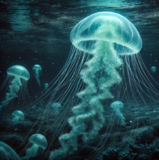 |
Atterian Sea Nettle | 1.2 meters (3 feet 11 inches) | 15 kilograms (33 pounds) | Coastal waters of Vaeringheim, Symphonara, and Delphica. | The Atterian Sea Nettle is a captivating and graceful jellyfish known for its stunning, bioluminescent appearance. Residing in the depths of Lake Morovia, it possesses unique characteristics that set it apart from the region's other jellyfish.
Atterian Sea Nettles are predominantly found in the deep, dark waters of Lake Morovia, where their gentle pulsating movements and glowing tentacles create a mesmerizing spectacle. They are rarely seen in shallower waters, preferring the mysterious depths. Generally peaceful, Atterian Sea Nettles can be found drifting through the depths of the Lake, and using their bioluminescence to communicate with one another. They often form small colonies, creating stunning displays of underwater light shows. They are primarily carnivorous, hunting smaller aquatic organisms with their poisonous tentacles. In the rare instances when Atterian Sea Nettles encounter threats, they can release a cloud of toxic mucus as a defense mechanism. This mucus not only deters potential predators but also creates a temporary smokescreen to escape from danger. |
 |
Ocian Swamp Squid | 0.6 meters (2 feet) | 7 kilograms (15.4 pounds) | Marshy coastal waters of Somniumpolis, Saluria, and the surrounding wetlands. | The Ocian Swamp Squid is a mysterious and elusive squid that inhabits the dark, murky waters of swamps and wetlands of Lake Morovia. This unusual creature is known for its unassuming appearance, and its fascinating abilities.
Ocian Swamp Squid are primarily found in the shadowy depths of swampy environments of Lake Morovia. They are known to thrive in stagnant and brackish waters, using the concealment of the murky, sediment-filled surroundings to their advantage. Mostly solitary and reclusive, the Ocian Swamp Squid prefers to remain hidden within the murky waters of their swampy homes. They are expert ambush predators, using their camouflage to remain undetected until an unsuspecting prey item comes within reach. Their docile appearance can be misleading, as they become highly defensive when threatened. Ocian Swamp Squid are Known for their complex and strange courtship rituals, which often involve intricate color displays and synchronized movements. Breeding occurs in the deeper parts of their swamp habitats, and the newly hatched larvae go through several stages of development before reaching maturity. |
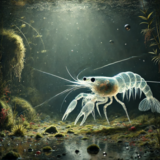 |
Odiferan Marsh Shrimp | 0.3 meters (1 foot) | 2 kilograms (4.4 pounds) | Swamps and marshes near Myrene and Symphonara. | The Odiferan Marsh Shrimp is a unique and mysterious shrimp found in the Odiferan Marsh. This small, elusive creature boasts a captivating array of features and abilities that distinguish it from the region's other shrimp.
Odiferan Marsh Shrimp thrive in the murky and nutrient-rich waters of the Odiferan Marsh, a region filled with dense vegetation and unique flora. They are often found in shallow, slow-moving streams and pools within the marsh. Odiferan Marsh Shrimp are primarily nocturnal creatures, emerging from their hiding spots at night to forage for food. They use their bioluminescent lure to attract insects and small aquatic invertebrates, which they capture using their agile swimming and precision strikes. Although they are generally peaceful, these creatures can become more aggressive when competing for resources or territory in the marsh. During the breeding season, male Odiferan Marsh Shrimp engage in intricate dance-like courtship displays, showcasing their bioluminescent lures to attract potential mates. Once courtship is successful, females lay their eggs among the aquatic plants in the marsh. |
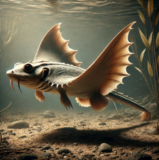 |
Hatch's Ray | 2.5 meters (8 feet 2 inches) | 200 kilograms (440 pounds) | Coastal marshes and swamps around Pyralis, Saluria, and Somniumpolis. | Hatch's Ray is an extraordinary and unusual creature known for its unique adaptation to swampy environments, which has evolved to thrive in the murky waters of swamps and marshes of Lake Morovia.
Hatch's Rays are predominantly found in the heart of swampy regions, where dense vegetation and shallow, brackish waters provide the ideal habitat for these extraordinary creatures. They are most commonly sighted in slow-moving streams, sloughs, and muddy ponds. Hatch's Rays are known for their solitary and reclusive nature, preferring the serenity of the swamp's quieter corners. They are expert ambush predators, often remaining partially buried in the swamp's mud and vegetation, awaiting unsuspecting prey to come within striking distance. These creatures are territorial by nature, and disputes over prime hunting grounds are not uncommon. Hatch's Rays communicate through a series of infrasound vocalizations that are imperceptible to humans, but can be heard by other Rays Mating rituals among Hatch's Rays involve elegant and synchronized swimming displays, where potential mates perform a mesmerizing dance that often culminates in courtship and, eventually, egg-laying among the reeds and aquatic plants of the swamp. |
 |
Atteran River Shark | 2.5 meters (8 feet 2 inches) | 350 kilograms (771 pounds) | Waters of the Strait of Haifa, near Aegirheim, Skýrophos, and Norsolyra. | The Atteran River Shark is a formidable, large shark, aptly named for its imposing presence and its preference for the turbulent waters of the Strait of Haifa. This apex predator is a master of its domain.
Atteran River Sharks are primarily found in the fast-flowing and murky waters of the Strait of Haifa, especially in the waters surrounding the Abeisan Archipelago. They are often sighted in the deeper, churning sections of the region's waterways. Atteran River Sharks are solitary predators, with each individual claiming its own territory along a stretch of the Atteran River. This shark is highly territorial and fiercely defend their hunting grounds from other predators. While formidable in battle, they tend to be patient hunters, lying in wait for fish and aquatic creatures to venture into their domain. During the breeding season, male Atteran River Sharks engage in fierce territorial battles to establish dominance. Once a territory is secured, the winning male performs an intricate courtship display to attract a female. The female lays her eggs in a secluded area of the river, and the male guards them diligently. |
 |
Haifan Armored Lake Dolphin | 1.8 meters (5 feet 11 inches) | 120 kilograms (264.5 pounds) | Shallow waters of Lake Morovia, particularly near Vaeringheim, Luminaria, and Delphica. | The Haifan Armored Lake Dolphin is a remarkable and unique creature, which resides in the murky waters of the Haifan region, it is known for its elegant beauty and formidable defensive capabilities.
Haifan Armored Lake Dolphins are most commonly found in the calm shallow waters of Lake Morovia. These tranquil environments provide the perfect sanctuary for these graceful creatures, where they can flourish and thrive. Haifan Armored Lake Dolphins are sociable creatures, often found swimming in small family groups or pods. They communicate using their sonic pulses, creating a harmonious symphony of sound that resonates throughout the waters of the Haifan region. While generally peaceful, they become fiercely protective when their habitat is threatened. These dolphins are expert hunters, using their echolocation abilities to locate prey with remarkable precision. They feed on fish, aquatic invertebrates, and occasionally aquatic plants, making them vital components of their ecosystem. During the breeding season, Haifan Armored Lake Dolphins engage in mesmerizing underwater displays, showcasing their agility and grace. Mating pairs often engage in synchronized swimming. |
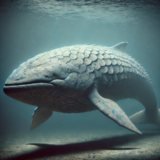 |
Vaering's Armored Whale | 6 meters (19 feet 8 inches) | 1,200 kilograms (2,646 pounds) | Open waters of Lake Morovia, with frequent sightings between Symphonara and Vaeringheim. | Vaering's Armored Whale is an awe-inspiring, massive whale, celebrated for its majestic presence and known for its formidable strength and unwavering endurance, this colossal creature roams the vast waters of Lake Morovia and the central Strait of Haifa.
Vaering's Armored Whales are most commonly found in the open oceans of Lake Morovia, where they navigate the depths and expanse of the lake with ease. They often undertake long migrations across the lake, following elusive currents. Leading a a relatively solitary life, these whales occasionally forming small, temporary pods when encountering other individuals. They communicate through a series of deep, resonant calls, often echoing through the vast lake. Their songs are considered one of the wonders of the natural world, captivating all who hear them. These whales are expert foragers, utilizing their hydrokinetic powers to corral schools of fish and other prey. They are key figures in maintaining the ecological balance of the oceans, as they often feed on overpopulated species to prevent depletion of marine resources. During the breeding season, Vaering's Armored Whales engage in elaborate courtship displays, which involve synchronized swimming, breathtaking breaches, and intricate sonic rituals. After mating, the female typically gives birth to a single calf, which she cares for and protects diligently. |
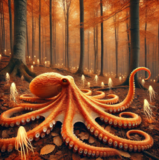 |
Orange Forest Land Octopus | 1 meter (3 feet 3 inches) | 10 kilograms (22 pounds) | Coastal forests and swamp regions of Norsolyra and surrounding areas. | The Orange Forest Land Octopus is an extraordinary and enigmatic terrestrial octopus, which inhabits the Gloom Forest of Perpetual Autumn, this creature has evolved to thrive in the eerie and mystical environment of the forest, where it feeds on the parasitic will-o-wisps that illuminate the dark woods.
The Orange Forest Land Octopus calls the mysterious Gloom Forest its home, a place shrouded in legends and mystery. This haunted forest is known for its luminous will-o-wisps, which serve as both the primary food source and an integral part of the Octopus's ecosystem. A solitary creature, the Land Octopus is often seen prowling the dark depths of the Orange Forest in search of will-o-wisps. It moves stealthily through the underbrush, its ghostly camouflage concealing it from potential predators and prey. The Orange Forest Land Octopus is seldom observed by humans, as it is a master of remaining hidden within the mystical forest. Its presence in the Orange Forest has contributed to the numerous legends and tales that surround this eerie woodland. |
 |
Abeisan Walrus | 2.5 meters (8 feet 2 inches) | 1,000 kilograms (2,204 pounds) | Coastal marshes around the Abeisan Archipelago, extending to Somniumpolis. | The Abeisan Walrus is a remarkable and resilient creature, celebrated for its commanding presence and unique adaptation to the swampy coastal regions of the Abeisan Archipelago.
Abeisan Walruses are primarily found in the Abeisan Archipelago, where they inhabit the brackish waters, coastal marshes, and frigid beaches. They are known to rest on ice floes during colder months and venture into the coastal swamps when the weather is warmer. Abeisan Walruses are sociable creatures, often congregating in small herds along the frigid coastlines of the Abeisan Archipelago. They are expert foragers, diving deep into the cold waters to hunt for fish, crustaceans, and other aquatic prey. These Walruses are known for their distinctive, eerie calls, which can be heard echoing across the coast. Their vocalizations serve as a means of communication within their herds and, during the breeding season, as courtship songs. During breeding season, male Abeisan Walruses engage in powerful, tusk-clashing displays to establish dominance and attract potential mates. Females typically give birth to a single calf, which they protect and nurture in the safety of their swampy coastal habitats. |
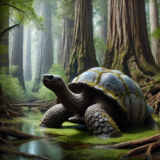 |
Greater Morovian Giant Turtle | 2.2 meters (7 feet 2 inches) | 1,125 kilograms (2,480 pounds) | Coastal waters and hidden bays around Delphica and Luminaria. | The Greater Morovian Giant Turtle is a majestic and venerable beast, renowned for its colossal size and serene presence. Inhabiting the waters of the Morovian region, this ancient creature is a symbol of wisdom and endurance.
Greater Morovian Giant Turtles are most commonly found in the brackish coastal waters of Lake Morovia. They prefer secluded coves and peaceful bays, where they find refuge and sustenance. The Greater Morovian Giant Turtle is a gentle and solitary creature, often observed drifting gracefully through the the Lake's coastal waters. These ancient creatures are known to live for centuries, displaying a deep connection with the ebb and flow of the lake. Their colossal shells serve as a haven for smaller aquatic species, including algae, and fish. This symbiotic relationship benefits both the Greater Morovian Giant Turtle and the species that take refuge on its back, creating a thriving ecosystem. During the breeding season, male Greater Morovian Giant Turtles engage in elaborate courtship rituals, involving synchronized swimming and the generation of seismic vibrations to attract potential mates. Once a pair is established, the female lays her eggs on the sandy shores of the Morovian coastline. |
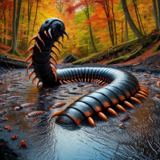 |
Tar Worm | 2 meters (6 feet 7 inches) | 200 kilograms (440 pounds) | Tar-pits and geothermal regions surrounding Erythros and its neighboring settlements. | The Tar Worm is a formidable and highly unusual creature, known for its tenacious existence in the treacherous tar-pits of its native region. This creature, has evolved to thrive in the hazardous and unforgiving environment of the tar-pits of the Gloom Forest of Perpetual Autumn.
Tar Worms are primarily found in the vast, gloomy tar-pits of their native region, where they navigate the viscous, oil-like substance with surprising ease. They can also be encountered in the surrounding areas, which often feature geothermal activity. Tar Worms are solitary and relentless hunters, making the tar-pits their home and feeding on smaller creatures that become trapped in the tar. Their venomous bites and powerful strikes are essential for subduing prey, and they are known for their patience in waiting for an opportunity to strike. Tar Worms are also infamous for feeding on human remains deposited in the tar-pits as part of Alperkin funerary customs. Despite their formidable appearance and territorial nature, Tar Worms play a vital role in the ecosystem of their native region. Their presence helps control the population of smaller creatures and maintains the balance within the tar-pits' delicate environment. The Tar Worms' adaptation to the harsh tar-pits has made them an central part of local folklore and legend, often symbolizing resilience and determination in the face of adversity. |
 |
Rift Valley Crocodile | 4 meters (13 feet) | 500 kilograms (1,102 pounds) | Swamps and river valleys around Lake Morovia and the central Strait of Haifa. | The Rift Valley Crocodile is a formidable creature, known for its powerful presence in the vast waters of the Haifan Rift Valley. This ancient creature, is known for its resilience and survival instincts in its unique habitat.
Rift Valley Crocodiles primarily inhabit the expansive Haifan Rift Valley, where they make their homes in the numerous lakes and rivers found within this geographic wonder. They are frequently encountered along the muddy banks and calm, freshwater bodies of the central Strait of Haifa and its tributaries. Rift Valley Crocodiles are solitary and territorial creatures, often seen basking in the sun along riverbanks or floating stealthily in the calm waters of the Strait of Haifa and Lake Morovia. They are patient hunters, relying on their camouflage to ambush unsuspecting prey that ventures too close. Their nests are hidden within the riverbanks, where females lay their eggs and protect them diligently. Once hatched, the young crocodiles are highly vulnerable and require their mother's care and protection until they are old enough to fend for themselves. The large presence of Rift Valley Crocodiles in the Strait has led to their inclusion in local mythology and tales, symbolizing both the danger and the enduring beauty of the region. |
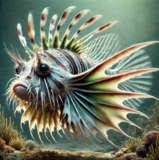 |
Atterian Armored Pufferfish | 0.5 meters (1 foot 7 inches) | 5 kilograms (11 pounds) | Coastal reefs and sandy seabeds around Lake Morovia and the northern Strait of Haifa. | The Atterian Armored Pufferfish is a unique and extraordinary fish which inhabits the coastal waters of Lake Morovia. This resilient creature is known for its intricate armored plating and its formidable defenses.
Atterian Armored Pufferfish are most commonly found among Lake Morovia's coral reefs and shallow, sandy seabeds where they can find both protection and sustenance. Atterian Armored Pufferfish are known for their gentle disposition and their preference for a peaceful coexistence with other organisms in the reef ecosystem. They are skilled hunters, using their water manipulation abilities to corral small fish and invertebrates into the confines of the coral reefs. When confronted by threats, they employ their unique defensive strategy of inflating their steel-plated bodies, rendering them nearly impervious to attack. This behavior is often sufficient to deter predators, and they generally prefer to avoid confrontations whenever possible. Mating rituals among Atterian Armored Pufferfish involve intricate displays of coordinated swimming and water manipulation. Once a mating pair is established, the female will lay her eggs in a secluded crevice within the reef, and both parents will diligently guard the nest. |
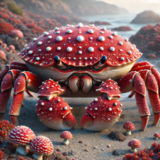 |
Amina Crab | .85 meters (2 foot 9 inches | 30 kilograms (66 pounds) | Rocky coastlines and clear, temperate waters around Lake Morovia, especially near Symphonara and Myrene. | The Amina Crab is a massive and formidable crab which inhabits the coastal waters of the Lake Morovia.
Amina Crabs are most commonly found along the rocky coastlines and in the clear, temperate waters of Lake Morovia. They favor areas with abundant underwater caves and crevices, where they seek shelter and protection. Amina Crabs are solitary and territorial creatures, often found lurking in underwater caves or patrolling the rocky Lake bed. They are expert hunters, capturing fish, crustaceans, and other marine life with their mighty claws. Their territorial nature often leads to disputes with other Amina Crabs over prime hunting grounds. These battles are fierce and can result in significant changes in territory ownership. During the breeding season, male Amina Crabs engage in elaborate displays of strength and agility to impress potential mates. After mating, the female lays her eggs in a secluded underwater crevice, where she guards them diligently. |
 |
Low Valley Swamp Roach | 0.6 meters (2 feet) | 20 kilograms (44 pounds) | Swamps and marshes around the lower valleys near the Morovian Lake region. | The Low Valley Swamp Roach is a formidable trilobite, known for its distinctive appearance and predatory nature, which inhabits the murky waters of the Morovian swamps.
Low Valley Swamp Roaches are primarily found in the dark, swampy waters of the Lake Morovia region. They make their homes in the muck and sediment, where they prowl for prey among the aquatic plants and detritus. Low Valley Swamp Roaches are solitary and territorial, often claiming specific hunting grounds within the swamp. They are patient and stealthy hunters, relying on their camouflage and ambush tactics to capture small aquatic creatures and insects. These creatures are known for their mysterious behavior, often lurking in the darkness of the swamp for hours before striking at their prey. They are also known to scavenge on decaying matter and plant material, serving as integral components of the swamp's ecosystem. They are also known to pose a danger to humans, and have been observed hunting people. Mating rituals among Low Valley Swamp Roaches involve intricate displays of underwater acrobatics, with males competing to impress potential mates. After mating, the female lays her eggs among the submerged vegetation, and both parents diligently guard the nest. |
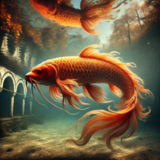 |
Fái's Koi | 1.5 meters (4 feet 11 inches) | 25 kilograms (55 pounds) | Sacred lakes and ponds near Erythros and throughout the Gloom Forest. | Fái's Koi is a mystical and revered fish, which embodies the ancient tales of the skies and seas. This extraordinary creature appears as a majestic, ancient koi fish adorned with shimmering scales that catch the light like stardust. Fái's Koi possesses a unique ability to traverse both the depths of the region's waterways and the vast expanse of the heavens.
Fái's Koi is said to dwell in the waters surrounding Erythros, where the boundaries between the earthly and the ethereal blur. Legends speak of its presence in tranquil lakes and sacred ponds, where it rises to the surface to bask in the light of Tarsica before taking flight into the starlit sky. Fái's Koi is a symbol of tranquility and enlightenment, revered by the people of the Erythros as a guardian of harmony and wisdom. It is said to possess ancient knowledge of the cosmos, which it expresses through a haunting song which can be heard echoing through the forests of Erythros as it flies through the night sky, and those who encounter it are said to be blessed with insight and clarity. The fish is often depicted in artwork and folklore, its celestial form inspiring poets, artists, and seekers of truth. Legends tell of pilgrimages made to sacred lakes in search of Fái's Koi, where devotees hope to catch a glimpse of its celestial flight and receive its divine blessings. |
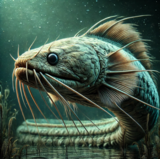 |
Morovian Saucer-Eyed Giant Eel | 3 meters (9 feet 10 inches) | 90 kilograms (198 pounds) | Deep waters of the Gloom Forest of Perpetual Autumn, near Erythros and surrounding marshes. | The Morovian Saucer-Eyed Giant Eel is a fearsome and ancient predator, known for its distinctive saucer-like eyes and formidable presence in the waters of the Gloom Forest of Perpetual Autumn. This eel, with its elongated body and dark, camouflaged skin, is a master of stealth and ambush, making it one of the most feared inhabitants of its murky domain.
Morovian Saucer-Eyed Giant Eels inhabit the deep, shadowy waters of the Gloom Forest's lakes and rivers. The perpetual autumn foliage that falls into the water provides perfect cover for these eels, allowing them to blend seamlessly with their surroundings and strike with lethal precision. Morovian Saucer-Eyed Giant Eels are solitary and highly territorial creatures. They are apex predators in their domain, preying on a variety of smaller aquatic animals and even other predators that venture too close. Despite their fearsome reputation, these eels play a crucial role in maintaining the balance of the aquatic ecosystem by controlling the populations of their prey. Their elusive nature and the remote, dark waters they inhabit make encounters with the Morovian Saucer-Eyed Giant Eel rare and often unnerving. Local legends and folklore often depict these eels as guardians of the deep, their glowing eyes a haunting presence in the murky depths. |
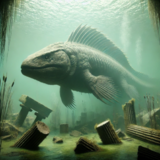 |
Glinos Leviathan | 8 meters (26 feet 3 inches) | 1,500 kilograms (3,307 pounds) | Frigid depths of Lake Morovia, with occasional sightings near Vaeringheim. | The Glinos Leviathan is a massive and fearsome predator, revered and feared in equal measure. Named after the god of ice and winter, this imposing creature rules the cold depths of its aquatic realm with unmatched ferocity and power. With its ice-blue scales and piercing eyes, the Glinos Leviathan embodies the harsh and unyielding nature of the depths of Lake Morovia.
Glinos Leviathans are found in the frigid, depths of Lake Morovia. They thrive in the deepest, coldest parts of these waters. These leviathans are also known to migrate to icy rivers during the winter months. Glinos Leviathans are solitary and highly territorial creatures, known for their aggressive nature and dominance over their territories. They are apex predators, preying on a wide range of aquatic life, including other large predators. Despite their fearsome reputation, they are also revered in local folklore as the embodiment of the lake's power and the guardians of the Strait. These leviathans are rarely seen by humans due to their preference for deep, cold waters, but when they do surface, their presence is both awe-inspiring and terrifying. Legends tell of their immense strength and the chilling roar that can be heard for miles when they breach the surface. |
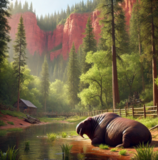 |
Bulhanu's Sea Cow | 4 meters (13 feet 1 inch) | 2,000 kilograms (4,409 pounds) | Coastal waters of Somniumpolis and surrounding nutrient-rich areas. | The Bulhanu's Sea Cow is a massive and docile aquatic bovine, highly valued in the coastal city of Somniumpolis for its tender beef and gentle nature. With its large, robust body adapted for life in both shallow and deep waters, this creature is a cornerstone of the region's agricultural economy.
Bulhanu's Sea Cows are predominantly found in the calm, nutrient-rich waters surrounding Somniumpolis. They thrive in both freshwater and marine environments, often seen grazing on underwater vegetation in coastal lagoons, rivers, and estuaries. Bulhanu's Sea Cows are social animals, often found in large herds that graze together in the lush underwater meadows. They communicate through low-frequency sounds that can travel long distances underwater, keeping the herd coordinated and safe. These sea cows are highly valued for their meat, which is known for its rich flavor and tender texture. The people of Somniumpolis have developed sustainable farming practices to ensure the well-being of these creatures, balancing the needs of the local ecosystem with agricultural demands. |
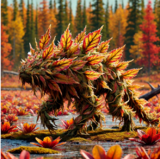 |
Gloom Forest Moss Hog | 1.2 meters (3 feet 11 inches) | 35 kg (77 lbs) | Swamps and wetlands along the shores of the Gloom Forest of Perpetual Autumn. | The Moss Hog is a remarkable creature native to the northern latitudes of Micras, where it thrives in the swampy regions amidst autumnal foliage. This semi-aquatic reptile has evolved extraordinary camouflage abilities, allowing it to blend seamlessly with its environment. Its body is covered in leaf-like appendages that mimic the vibrant orange, yellow, and red colors of the Gloom Forest.
The Moss Hog is most commonly found along the shores of swamps and wetlands of the Gloom Forest of Perpetual Autumn. It prefers areas with abundant vegetation where it can use its camouflage to its advantage. It is a peaceful creature that spends much of its time foraging for aquatic plants and small insects. It is known to be quite elusive, often hiding among the foliage to avoid detection. When threatened, it uses its Leaf-like appendages to vanish from sight, leaving its pursuers baffled.
|
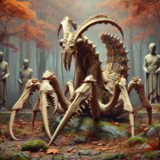 |
Minervial Mantis | 1.8 meters (5 feet 11 inches) | 60 kilograms (132 pounds) | Dense swamp regions surrounding Aurelia and Sylvapolis. | The Minervial Mantis is a unique, giant aquatic mantis which is capable of complex forms of camouflage, allowing it to blend seamlessly with the murky swamp environments around Aurelia. Despite its fearsome appearance, the Minervial Mantis is not aggressive toward humans unless provoked, especially during its territorial mating season.
Inhabiting the dense, shadowy swamps in the region surrounding Lake Morovia, the Minervial Mantis thrives in waterlogged environments that support its diet and provide ample cover. These habitats are crucial during its mating season when the Minervial Mantis becomes particularly territorial. The Minervial Mantis leads a mostly solitary life, becoming highly territorial and visibly aggressive towards other males during the mating season as it competes for mates. It communicates through low-frequency vibrations in the water, which are also used to deter rivals and attract females. Outside of mating season, it is a patient and efficient predator, using its camouflage to ambush prey. While the Minervial Mantis may appear daunting, its focus on maintaining ecological balance in its habitat and its complex behaviors during mating season make it a fascinating subject for study. Observers are advised to respect its space during the breeding season to avoid triggering its territorial instincts. |
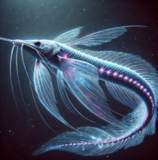 |
Vaalshrin Deep-Stalker | 2 meters (6 feet 7 inches) | 12 kilograms (26 pounds) | Abyssal depths of Lake Morovia, near Somniumpolis and Vaeringheim | The Vaalshrin Deep-Stalker is a blind, eel-like predator named after Vaalshrin, the mythical guardian of the Abyssal Gateways in Reformed Stripping Path lore. With no eyes, it navigates using a network of highly sensitive lateral lines that detect minute vibrations in the water. The Deep-Stalker’s body is covered in iridescent scales that shimmer faintly, creating an eerie, ghost-like silhouette in the dark. It preys on crustaceans and deep-dwelling creatures, using a retractable proboscis to strike prey at lightning speeds. Breeding occurs around volcanic vents, with synchronized bioluminescent displays to attract mates. |
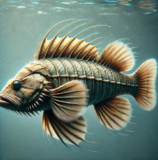 |
Atosi Hellfire Bass | 1 meter (3 feet 3 inches) | 22 kilograms (48 pounds) | Thermal vents of the Strait of Haifa, near Aegirheim and Skýrophos | The Atosi Hellfire Bass is a fierce, territorial fish that uses extreme heat to ward off intruders. Its scales glow with fiery intensity, reflecting its connection to Atos, the Bassaridian divine figure of volcanic wrath. The Hellfire Bass preys on thermal-dwelling invertebrates, using its powerful jaws to crush shells. During mating, males construct nests in the hottest parts of the vents, and the resulting glowing nests become a beacon for females. The Hellfire Bass is feared and respected for its ferocity and its ability to thrive in extreme conditions. |
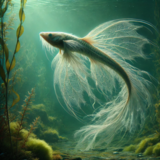 |
Ahzraal Wyrdling | 0.8 meters (2 feet 7 inches) | 5 kilograms (11 pounds) | Kelp forests of Lake Morovia, around the coasts of Vaeringheim and Symphonara | The Ahzraal Wyrdling is a small, semi-transparent fish found in the dense kelp forests of Lake Morovia. Its body is covered in intricate tendrils that resemble delicate woven cloth, allowing it to blend seamlessly into its surroundings. The Wyrdling uses these tendrils to trap plankton and small fish, secreting a mild toxin to paralyze its prey. During mating season, Wyrdlings weave large communal nests from kelp strands, which resemble the woven tapestries dedicated to Ahzraal in local shrines. These nests pulse and undulate like a living tapestry, creating an enchanting spectacle. |
 |
Tarsican Cantor | 2.5 meters (8 feet 2 inches) | 30 kilograms (66 pounds) | Deep trenches of the Strait of Haifa, near Skýrophos | The Tarsican Cantor is a large, ethereal cephalopod known for its haunting, resonant calls, which echo through the underwater canyons of Skýrophos. This species is named after Tarsica, the Lady Divine of Illumination, and is believed to sing hymns in the depths to honor her presence. The Cantor’s body is adorned with glowing patterns that it uses to communicate and lure prey. Mating among Cantors involves elaborate duets, with males and females harmonizing their calls. The female releases thousands of glowing eggs that illuminate the trench waters, creating a breathtaking display. |
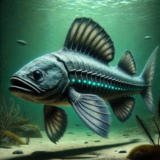 |
Norsolyrian Razorfin | 0.7 meters (2 feet 4 inches) | 4 kilograms (8.8 pounds) | Shallow bays along the coast of Norsolyra | The Norsolyrian Razorfin is a sleek, fast-moving fish known for its distinctive sharp dorsal fin and streamlined body. Found primarily in the shallow coastal bays around Norsolyra, this fish uses its razor-like fins to defend against predators and slice through underwater vegetation. The Razorfin’s scales are a shimmering silver-blue, making it difficult to spot in the sunlight. During the breeding season, Razorfin males engage in underwater dances, using their sharp fins to carve intricate patterns in the sand to attract mates. Once paired, the female lays her eggs in hidden nests, guarded fiercely by the male. |
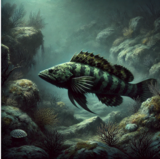 |
Vaeringheim Shadowfin | 1.5 meters (4 feet 11 inches) | 10 kilograms (22 pounds) | Shallow reefs near the coast of Vaeringheim | The Vaeringheim Shadowfin is an elusive, dark-scaled fish that camouflages itself among the rocky outcroppings and coral reefs near the coast of Vaeringheim. With its mottled black and green coloration, it blends almost perfectly with underwater shadows, making it nearly invisible to both predators and prey. Shadowfins are highly territorial and often found patrolling the waters around sunken ruins and shipwrecks, which they fiercely defend. They feed on small fish and crustaceans, using their powerful tails to dart out of hiding and snatch up prey. During breeding, Shadowfins gather under the full moon, displaying bioluminescent markings to attract mates. |
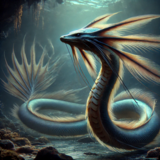 |
Skýrophian Serpent Eel | 1.5 meters (4 feet 11 inches) | 15 kilograms (33 pounds) | Canyons and underwater cliffs near Skýrophos | A long, sinuous eel known for its powerful bite and distinctive, glowing yellow eyes. The Serpent Eel is highly aggressive and lurks in crevices along the cliffs near Skýrophos, where it ambushes its prey. It is considered one of the most dangerous predators in the area and is respected and feared by local fishermen. Mating involves intense territorial battles between males, with the victor securing the best crevices to attract a mate. |
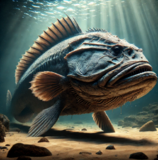 |
Aegirheim Tidal Goliath | 5 meters (16 feet 5 inches) | 1,000 kilograms (2,205 pounds) | Coastal waters near Aegirheim | The Aegirheim Tidal Goliath is a massive, slow-moving fish that roams the deep waters off Aegirheim’s coast. Known for its immense size, it creates strong currents as it moves, which can disrupt smaller boats. The Tidal Goliath is a filter feeder, consuming large quantities of plankton and small fish. It is considered a keystone species in its environment, as its feeding patterns help regulate plankton populations and maintain the health of the coastal ecosystem. |
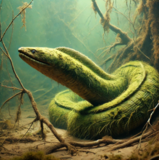 |
Somnian Mossback Eel | 2 meters (6 feet 7 inches) | 25 kilograms (55 pounds) | Marshy coastal waters near Somniumpolis | The Somnian Mossback Eel is a thick-skinned eel covered in moss-like growths, blending perfectly with the swampy terrain of Somniumpolis. It can survive both in and out of water, using its powerful tail to navigate the muck of the coastal marshes. The Mossback Eel is known to ambush prey from its mud-lined burrows, relying on its camouflage to remain hidden until the last moment. During mating season, Mossback Eels congregate in the darkest parts of the marsh, where males compete in wrestling matches to secure territory and attract mates. |
 |
Delphican Harpooner | 1.3 meters (4 feet 3 inches) | 20 kilograms (44 pounds) | Rocky coastal areas of Delphica | The Delphican Harpooner is a sharp-beaked fish known for its powerful jaws, which it uses to crack open shellfish and even small crabs. It is highly aggressive, and its sharp beak is capable of puncturing the shells of larger predators. Found primarily in rocky coastal areas, it often challenges even larger predators for territory. During the breeding season, Harpooners gather in large schools, where males engage in fierce duels to establish dominance. |
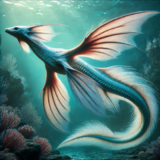 |
Bjornian Tidehowler | 4 meters (13 feet 1 inch) | 500 kilograms (1,102 pounds) | Deep coastal waters near Bjornopolis | The Bjornian Tidehowler is a large, whale-like creature that sings haunting, resonant songs. The Tidehowler’s songs are believed to predict changes in the tides and weather, and its presence is considered an omen by local sailors. The Tidehowler’s deep, rhythmic calls can be heard for miles underwater, and are used to communicate with others of its kind during mating season. Mating rituals are marked by coordinated song duets that resonate through the deep waters of Bjornopolis. |
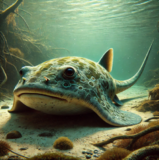 |
Bulhanu Brooding Ray | 3 meters (9 feet 10 inches) | 200 kilograms (440 pounds) | Coastal swamps and marshes near Somniumpolis | The Bulhanu Brooding Ray is a large, flat-bodied fish found in the coastal swamps and marshes of Somniumpolis. It is known for its unique brooding behavior, in which the female carries her eggs in specialized pouches along her underside until they hatch. The Brooding Ray is highly protective of its young, fending off predators with powerful tail slaps. During the mating season, males perform complex displays by using their fins to create waves in the shallow waters, attracting females to their territories. |
 |
Symphonaran Crystal Minnow | 0.1 meters (4 inches) | 0.1 kilograms (0.2 pounds) | Coral reefs around Symphonara | The Symphonaran Crystal Minnow is a tiny, translucent fish that glows with a soft, rainbow-colored light. Found in the vibrant coral reefs of Symphonara, its shimmering body serves to attract mates and ward off predators. Highly sought for ornamental purposes, the Crystal Minnow is a symbol of beauty and grace in local lore. Its presence is believed to bring tranquility to the reefs, making it a popular choice for decorative ponds. |
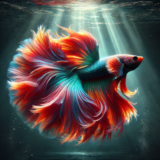 |
Delphic Sea Phoenix | 1.5 meters (4 feet 11 inches) | 15 kilograms (33 pounds) | Open waters off the coast of Delphica | The Delphic Sea Phoenix is a vibrant fish with long, flowing fins that resemble flames. It is said to appear only once every few years, making sightings extremely rare and auspicious. Locals believe that encountering the Sea Phoenix brings good luck and is a sign of forthcoming prosperity. The Sea Phoenix's fiery colors and elegant movements have made it a symbol of beauty and resilience, often appearing in Delphican folklore as a guardian of the deep. |
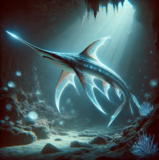 |
Myrene Dreamshark | 1.8 meters (5 feet 11 inches) | 60 kilograms (132 pounds) | Coastal caves of Myrene | The Myrene Dreamshark is a majestic, nocturnal predator known for its shimmering, opalescent scales that glow softly in the dark. Found along the coastal caves near Myrene, the Dreamshark is often associated with dreams and mysticism in local folklore, and its ghostly glow is said to guide the souls of the lost back to the surface. With its long, slender body and graceful movements, it glides silently through the water, striking fear into its prey. Mating rituals involve complex light displays that resemble the movement of stars, believed to bring good fortune to those who witness them. |
 |
Luminarian Sky Salmon | 1 meter (3 feet 3 inches) | 18 kilograms (40 pounds) | Coastal skies and shores of Luminaria | The Luminaria Sky Salmon is a unique aerial fish that spends much of its life gliding through the air above the coastal waters of Luminaria. With its elongated, wing-like fins and lightweight body, it can launch itself from the water and soar for several meters. Sky Salmon feed on both aquatic plants and airborne insects, making them a symbol of harmony between land, air, and sea. During breeding season, large schools gather along the cliffs, performing aerial displays to attract mates. |
 |
Atosian Voidscale | 1.6 meters (5 feet 3 inches) | 45 kilograms (99 pounds) | Rocky coastal waters near Aegirheim | The Atosian Voidscale is a swift and aggressive predator, characterized by its dark, iridescent scales that reflect light in an almost void-like pattern. Found in the rocky coastal waters around Aegirheim, this fish is feared by local fishermen for its powerful, razor-sharp teeth and unpredictable nature. Atosian Voidscales are solitary hunters, using their speed to ambush prey hiding among rocks and crevices. During mating season, males become highly territorial, chasing away any intruders with violent lunges and displays of their impressive teeth. |
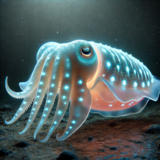 |
Haifan Glimmer Cuttle | 0.5 meters (1 foot 7 inches) | 8 kilograms (17.6 pounds) | Marshes and swamps near Somniumpolis | The Haifan Glimmer Cuttle is a small, vibrant cuttlefish known for its unique ability to emit dazzling light patterns when threatened. Found in the murky waters of the marshes near Somniumpolis, the Glimmer Cuttle uses its glowing displays to confuse predators. Its bioluminescence is also used during mating rituals, where males compete to create the most elaborate and hypnotic displays to attract females. The cuttlefish's venomous tentacles make it dangerous to handle, and locals often avoid its hunting grounds during the breeding season. |
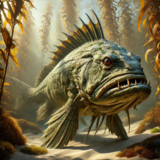 |
Thalassian Kelpweaver | 1.2 meters (3 feet 11 inches) | 20 kilograms (44 pounds) | Kelp forests around Symphonara and Vaeringheim | The Thalassian Kelpweaver is a large, slow-moving fish with a body covered in fronds resembling kelp, allowing it to camouflage perfectly within its environment. Found in the dense kelp forests near Symphonara and Vaeringheim, this fish is an expert ambush predator, waiting motionless for unsuspecting prey to pass by. Its unique camouflage makes it almost invisible among the underwater vegetation. During mating season, Thalassian Kelpweavers gather in small groups, swaying in rhythm with the kelp fronds to communicate through subtle movements. |
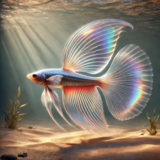 |
Amari Glasswing | 0.7 meters (2 feet 4 inches) | 12 kilograms (26 pounds) | Shallow coastal waters near Symphonara | The Amari Glasswing is a delicate and brightly colored fish known for its translucent fins that shimmer like glass when caught in the sunlight. Found in the shallow coastal waters near Symphonara, it uses its beautiful but fragile fins to attract mates and confuse predators. Amari Glasswings are known to gather in large shoals during the breeding season, creating stunning underwater displays. However, the fragility of its fins makes it vulnerable to sudden changes in the environment and requires a stable habitat to thrive. |
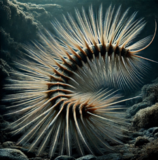 |
Haifan Spineweaver | 0.6 meters (2 feet) | 8 kilograms (17.6 pounds) | Deep waters of Lake Morovia and the Strait of Haifa, near Vaeringheim and Delphica | The Haifan Spineweaver is an alien-like creature with a body structure that combines features of both a sea urchin and a fish, making it one of the most bizarre and unearthly inhabitants of Lake Morovia and the Strait of Haifa. Its central body is covered in long, translucent spines that resemble anemone tendrils, each tipped with tiny bioluminescent bulbs that glow in eerie, shifting patterns.
The creature's iridescent, gelatinous body pulses faintly as it glides through the water using delicate, fin-like appendages hidden among its spines. These fins, along with its subtle undulating movements, allow it to hover silently in the dark depths, giving it an almost ethereal presence. Despite its gentle appearance, the Haifan Spineweaver is a highly specialized ambush predator. When prey ventures too close, it uses its flexible spines to quickly ensnare and immobilize them, injecting a paralyzing toxin through its needle-like tips. Local fishermen and divers near Vaeringheim and Delphica speak of rare sightings of the Haifan Spineweaver, describing its ghostly light as a haunting beacon in the deep, dark waters. Many believe that the creature’s presence is a bad omen, tied to mysterious disappearances in the region. Scientists continue to study this enigmatic species, fascinated by its strange biology and the potential applications of its unique bioluminescent and toxic properties. |
Terrestrial Fauna
| Picture | Species Name | Height/Length | Weight | Range | Description |
|---|---|---|---|---|---|
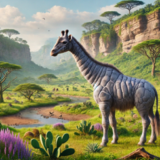 |
Naked Lowland Giraffe | 3.5 meters (11 feet 6 inches) | 700 kilograms (1,543 pounds) | Found in the damp lowland swamp forests of Somniumpolis and surrounding marshes of Luminaria and Bjornopolis | The Naked Lowland Giraffe is a peculiar and rare creature, characterized by its unique appearance. Unlike its furry relatives, this subspecies of Giraffe has evolved to adapt to the damp lowland swamp forests of Lake Morovia. It is known for its distinct lack of fur, giving it a sleek, naked appearance. Instead, its skin is equipped with specialized pores that secrete a protective layer of mucus, helping it to regulate body temperature and to keep it free of parasites.
Naked Lowland Giraffes are typically found in the wet lowland forests of Lake Morovia. They are known to roam in small herds, peacefully grazing on the abundant vegetation the forest provides The Naked Lowland Giraffe's neck is exceptionally long, allowing it to reach high into the treetops to feed on leaves and vegetation. It has a prehensile tongue, which can extend up to 6 feet, making it a masterful forager. This creature is also known for its graceful and agile movements, enabling it to navigate the open savannas with ease. While generally peaceful and herbivorous, the Naked Lowland Giraffe possesses powerful, whip-like tails that it can use to defend itself against predators. Its calm demeanor and serene gaze have made it a symbol of patience and tranquility in many local cultures. It is said that those who encounter a Naked Lowland Giraffe in the wild are truly fortunate, as it represents a harmonious balance between nature and adaptation. |
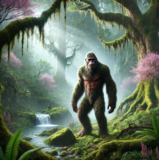 |
Morovian Sasquatch | 2.5 meters (8 feet 2 inches) | 350 kilograms (772 pounds) | Found in the deep, ancient forests near Ephyra, Symphonara, and Catonis Atrium.. | The Morovian Sasquatch, a legendary and elusive creature, is renowned for its towering presence within the deep, ancient forests of the Lake Morovia. This gentle giant possesses an exceptional ability to thrive in the harshest of environments.
The Morovian Sasquatch is exclusively found within the deepest and most ancient of the region's forests, where it maintains the delicate ecological balance of its lush, mystical surroundings. Covered in a thick coat of moss and lichen, the Morovian Sasquatch is a master of camouflage, allowing it to blend seamlessly into the lush undergrowth of the forest. Its large, sturdy feet, adapted for snowy terrain, enable it to traverse the wintry landscapes of the Morovian wilderness with ease. Despite its imposing appearance, the Morovian Sasquatch is a docile and reclusive creature. It is known to be a guardian of the forest, protecting the delicate balance of its habitat and the creatures that reside within it. Sightings of the Morovian Sasquatch are exceedingly rare, often regarded as a sign of great fortune. In local folklore, it is said that those who encounter this mystical creature will find themselves blessed with the ability to communicate with the spirits of the forest. |
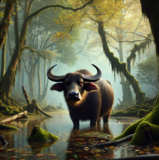 |
Morovian Water Buffalo | 1.8 meters (5 feet 11 inches) | 900 kilograms (1,984 pounds) | Wetlands, marshes, and riverbanks of Vaeringheim, Symphonara, and the surrounding lowland areas of Lake Morovia. | The Morovian Water Buffalo is a remarkable and gentle giant of the aquatic world, renowned for its adaptability and harmonious presence in the wetlands of Lake Morovia.
Morovian Water Buffaloes are commonly found in the wetlands, marshes, and riverbanks of Lake Morovia, where they thrive in the rich and diverse aquatic ecosystem. With its imposing size and powerful build, the Morovian Water Buffalo is an impressive sight. Its sleek, water-resistant coat helps it navigate through swampy marshes and riverbanks with ease. This creature's broad, flattened hooves allow it to traverse muddy terrain without getting stuck. Its horns, while large, are used primarily for breaking through thick aquatic vegetation and are not generally used as weapons. Morovian Water Buffaloes are known for their strong sense of community and cooperation. They often move in herds, working together to forage for aquatic plants and graze on the rich vegetation along riverbanks. Their presence is a vital part of the Morovian wetlands' ecosystem, as they help control plant growth and maintain the health of their aquatic environment. In local culture, the Water Buffalo is a symbol of resilience and the importance of maintaining the balance of nature. Local folklore speaks of their ability to bring life and prosperity to the lands they inhabit. |
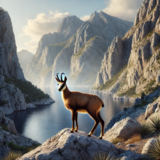 |
Alp Chamois | 0.9 meters (2 feet 11 inches) | 30 kilograms (66 pounds) | Steep, rocky, and mountainous terrain in the Alperkin regions surrounding Luminaria, Bjornopolis, and the highlands of Skyrophos. | The Alp Chamois is a remarkable and nimble creature native to the rugged mountainous regions of the region surrounding Lake Morovia.
Alp Chamois inhabit the steep, rocky, and mountainous terrain of the Alperkin region. They are often found in altitudes that challenge most other species. With its sleek and agile physique, the Alp Chamois is an expert climber and jumper. Its powerful legs, designed for scaling steep cliffs and bounding across rocky landscapes, grant it the ability to move with grace and precision at high altitudes. Its distinctive curved horns are not just for show; they assist with balance and are used for agile maneuvers and defending against predators. Alp Chamois are known for their spirited and independent nature. They tend to live in small herds and are constantly on the move in search of fresh vegetation. Their uncanny ability to navigate the treacherous mountain terrain and locate patches of nourishing flora is a testament to their adaptability. The Alp Chamois is famously one of the region's only species which is entirely immune to the toxic effects of Noctic-Rabrev. In the Alperkin region's folklore, the Alp Chamois is revered as a symbol of determination and tenacity. It is said that encountering one of these elusive creatures is a sign of impending success and a reminder to persevere in the face of challenges. |
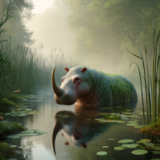 |
Morovian Horned Hippo | 1.8 meters (5 feet 11 inches) | 1,200 kilograms (2,645 pounds) | Riverbanks and waterways around Symphonara, Vaeringheim, and Lake Morovia. | The Morovian Horned Hippo is a majestic and imposing presence along the riverbanks and waterways of the region surrounding Lake Morovia.
Morovian Horned Hippos are commonly found near the riverbanks, lakes, and other water bodies of the Morovian region, where they are integral to the aquatic ecosystems. With its hulking, barrel-shaped body and sturdy legs, the Morovian Horned Hippo is a true embodiment of strength and resilience. Its imposing presence is only matched by the pair of long, curved horns that sprout from its forehead, which are used for both defense and territorial displays. Its tough, water-resistant hide acts as armor against the rigors of its environment. These remarkable creatures are often found in groups along riverbanks, where they graze on aquatic vegetation and bask in the sun. Despite their formidable appearance, they are known for their calm and communal nature. They play a vital role in maintaining the health of the Morovian waterways, helping to control vegetation growth and shaping the landscape with their movements. In Morovian culture, the Horned Hippo is seen as a symbol of protection and stability. Folklore tells of their ability to guard the waterways and bless those who live near them with prosperity and abundance. |
 |
South Haifan Camel | 2.0 meters (6 feet 7 inches) | 700 kilograms (1,543 pounds) | Open, marshy wetlands around Lake Morovia, particularly near Somniumpolis, Skyrophos, and the plains surrounding Symphonara. | The South Haifan Camel is a resilient and indispensable creature of the Haifan wetlands.
South Haifan Camels are typically found in the open, marshy wetlands of Lake Morovia and the Strait of Haifa, where they play a vital role in assisting swamp-dwelling communities. With its distinctive humpbacked silhouette and long, sturdy legs, the South Haifan Camel is perfectly adapted for traversing vast stretches of marshy wetlands Known for their strong sense of direction and survival instincts, South Haifan Camels are often relied upon by swamp nomads and travelers as trusted companions. These creatures are renowned for their ability to cover great distances without tiring, and their resistance to extreme temperatures. In the culture of the South Haifan region, the Camel is a symbol of endurance and reliability. Local stories suggest that encountering a South Haifan Camel in the swamp is a sign of hope and guidance, leading travelers to safety and sustenance. |
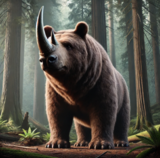 |
Morovian Highland Horned Bear | 3.5 meters (11 feet 6 inches) | 600 kilograms (1,322 pounds) | Found in the rugged mountainous regions of the Upper Morovian Highlands surrounding Bjornopolis, Luminaria, and Norsolyra. | The Morovian Highland Horned Bear is a majestic and awe-inspiring creature, native to the rugged mountainous regions of the Upper Morovian Highlands.
Morovian Highland Horned Bears inhabit the lofty mountainous regions and highland terrains of the Upper Morovian Highlands, where their adaptability to high altitudes is unmatched. With its formidable size and powerful build, the Morovian Highland Horned Bear is a true mountain monarch. Its shaggy fur, colored in shades of brown and gray, acts as insulation against the frigid highland temperatures. However, what truly sets this bear apart are the impressive curved horns that adorn its head, serving both as weapons and symbols of its dominance. These bears are known for their solitary and territorial nature, often establishing their domains at high altitudes where few other species dare to venture. They are experts in traversing the steep, rocky slopes and surviving in the harshest of conditions. Despite their imposing presence, they are not aggressive unless provoked, and are often seen as guardians of the highlands. In local culture, the Highland Horned Bear is revered as a symbol of strength and resilience. Folklore tells of their ability to guide lost travelers through the treacherous mountain paths and protect the highlands from threats. |
 |
Upper Haifan Woolly Lion | 2.3 meters (7 feet 7 inches) | 250 kilograms (551 pounds) | Mountainous regions to the north of Vaeringheim, extending into the highlands surrounding Skyrophos and Norsolyra. | The Upper Haifan Woolly Lion is a regal and imposing creature, native to the highland landscapes of regions north of Lake Morovia.
Upper Haifan Woolly Lions are primarily found in the mountainous regions to the north of Lake Morovia, where they reign as the dominant predator. With its majestic mane of thick, woolly fur and powerful physique, the Upper Haifan Woolly Lion is the undisputed monarch of the mountains. Its thick fur not only provides insulation against the mountainous cold but also acts as a striking display of its beauty and authority. This creature's piercing blue eyes are both captivating and chilling, a reflection of the wilderness in which it dwells. Woolly Lions are known for their solitary and majestic nature, often roaming the vast, rocky expanses in search of prey. They are experts in navigating the mountainous terrain and are incredibly stealthy hunters, despite their size. These creatures are often seen as symbols of the raw power of nature and are revered by those who call the mountains their home. In Upper Haifan folklore, the Woolly Lion is believed to be a guardian of the mountains and a harbinger of impending storms. Encounters with this magnificent creature are seen as both a blessing and a reminder of the awe-inspiring power of the Upper Morovian Highlands. |
 |
Wetland Ground Sloth | 2.5 meters (8 feet 2 inches) | 700 kilograms (1,543 pounds) | Marshy wetlands and boggy landscapes near Vaeringheim, Somniumpolis, and the lowland areas of Symphonara. | The Wetland Ground Sloth is a unique and fascinating creature, native to the marshy wetlands and boggy landscapes of the region.
Wetland Ground Sloths are primarily found in the marshy wetlands and boggy regions of Lake Morovia, where they navigate the muddy waters and aquatic vegetation with ease. With its impressive size powerful limbs, the Wetland Ground Sloth is a distinctive presence in the marshes. Its shaggy fur is designed to repel water and mud, ensuring that it remains dry and comfortable in its boggy environment. This sloth's sharp, curved claws are well-suited for digging and foraging for submerged vegetation and prey. These sloths are known for their calm and solitary nature, often residing in the dense, murky swamps, where they are seldom seen by humans. Despite their slow, deliberate movements, they are remarkably efficient hunters and foragers, capturing fish and aquatic plants with stealth and precision. In regional folklore, the Wetland Ground Sloth is seen as a symbol of patience and adaptation to challenging environments. Encounters with this elusive creature are considered a stroke of luck and a reminder of the quiet but resolute strength of nature. |
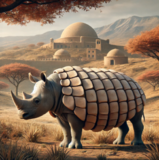 |
Oceanic Shelled Rhino | 3.5 meters (11 feet 6 inches) | 1,800 kilograms (3,968 pounds) | Coastal areas and rocky shores around Lake Morovia, as well as select inland locations around Pyralis and Luminaria. | The Oceanic Shelled Rhino is a remarkable and imposing creature known for its unparalleled defensive capabilities.
Oceanic Shelled Rhinos can be found in a variety of habitats around Lake Morovia, but they are often called upon to protect valuable locations, resources, and areas that require a guardian's watchful eye. With its massive frame and solid, armored-plated shell, the Oceanic Shelled Rhino is an imposing sight. Its horn is not only a formidable weapon but also a symbol of its resilience. Oceanic Shelled Rhinos are known for their solitary and steadfast nature, often seen patrolling their territories with unwavering determination. Despite their imposing presence, they are not aggressive unless provoked. Their remarkable defensive capabilities make them nearly impervious to harm, and they are often called upon to protect precious locations and rare resources. In folklore and local legend, the Oceanic Shelled Rhino is revered as a symbol of unyielding strength and protection. Encounters with these mighty creatures are seen as a sign of safeguarding against adversity and a reminder of the power of unwavering resolve. |
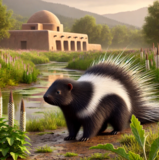 |
Bassaria's Porcupine | 0.6 meters (2 feet) | 10 kilograms (22 pounds) | Dense, ancient forests of the Lake Morovia region, especially near the lush woodlands of Saluria and Catonis Atrium. | Bassaria's Porcupine is a unique and fascinating creature, native to the lush forests of the region surrounding Lake Morovia.
Bassaria's Porcupines are primarily found in the dense and ancient forests of the Lake Morovia region, where they thrive in the rich and diverse woodland ecosystems. With its small yet distinctive form, the Bassaria's Porcupine is covered in a coat of sharp, needle-like quills, which provide excellent protection against potential threats. Its large, round eyes and keen sense of smell allow it to navigate through the dense undergrowth of the forest with ease. This animal's quills serve both as a means of defense and as a deterrent to predators. Porcupines are known for their solitary and independent nature, often dwelling in the treetops of the ancient Morovian forests. Despite their prickly exterior, they are gentle creatures, living in harmony with the other creatures of the forest. In Bassarian folklore, the Porcupine is revered as a symbol of protection and respect for the natural world. Encounters with these intriguing creatures are seen as a sign of the forest's benevolence and a reminder of the importance of coexistence with the environment. |
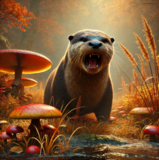 |
Harpy's Giant Land Otter | 1.5 meters (4 feet 11 inches) | 30 kilograms (66 pounds) | Wetlands, riverbanks, and marshy areas of the Lake Morovia region, found in the lush aquatic zones around Somniumpolis and Erythros. | The Harpy's Giant Land Otter is a unique and captivating creature native to the wetlands and riverbanks of the region surrounding Lake Morovia.
The Harpy's Giant Land Otter is primarily found in the lush wetlands, riverbanks, and marshy areas of the region, where it plays a vital role in maintaining the health of the aquatic ecosystems. With its sleek, semi-aquatic form, the Harpy's Giant Land Otter is an enchanting presence along riverbanks and marshes. Its webbed paws make it an agile swimmer. This creature's keen eyesight and sense of smell help it catch fish and other aquatic prey with incredible precision. These otters are known for their communal nature, often forming tight-knit family groups that work together to hunt and protect their territory. Despite their imposing appearance, they are gentle and intelligent creatures, known for their vocal communication and intricate social behaviors. In the Harpy region's folklore, the Giant Land Otter is revered as a symbol of harmony and cooperation. Encounters with these remarkable creatures are seen as a sign of unity and a reminder of the value of working together to protect their delicate wetland homes. |
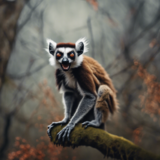 |
Alpert's Lemur | 0.4 meters (1 foot 4 inches) | 0.3 kilograms (0.7 pounds) | Dark forests and dense canopies of the Alperkin region, frequently seen in the moonlit forests of the Alperkin range. | The Alpert's Lemur is a mysterious and unique creature native to the dense, moonlit forests of the Alperkin region.
Vampiric Alpert's Lemurs primarily inhabit the dark forests and forest canopies of the Alperkin region, where they maintain the balance of the nocturnal ecosystem. With its small, nimble form and large, expressive eyes, the Alpert's Lemur is an enigmatic presence in the moonlit forest canopies. Its wing-like membranes stretch between elongated fingers, allowing it to glide through the night with eerie grace. This creatures's distinctive fangs are used for piercing its prey's skin, drawing sustenance from their life force. These nocturnal creatures are known for their solitary and secretive nature, often dwelling high in the treetops of the Alperkin region's forests. They are masterful hunters and have an uncanny ability to disappear into the shadows. Despite their ominous reputation, they are essential for controlling the population of nocturnal pests in the region. In Alperkin folklore, the Alpert's Lemur is revered as a symbol of balance in the forest, as it keeps the nocturnal ecosystem in check. Encounters with these mysterious creatures are seen as a sign of protection against the dangers of the night and a reminder of the intricate web of life in the forest. |
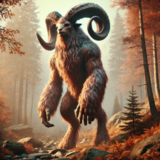 |
Garganram | 8 meters (26 feet 3 inches) | 12,000 kilograms (26,455 pounds) | Remote and rugged landscapes around the northern reaches of Lake Morovia, especially in isolated mountain valleys near the Upper Morovian Highlands. | The Garganram is a colossal and awe-inspiring creature, known for its incredible size and unparalleled strength.
Garganram are typically found in the most remote and rugged landscapes, where their colossal forms shape and define the environment. With its immense form and solid rock-like body, the Garganram is a sight to behold. Its tough, fur-covered exterior is adorned with ancient, weathered carvings, giving it a sense of grandeur and history. This creature's massive, stone-like limbs are capable of causing earthquakes with each step it takes. Garganram are known for their solitary and elusive nature, often residing deep within the most remote and rugged landscapes. They are believed to be ancient protectors of the land, with the power to shape and reshape the very earth itself. Encounters with these colossal creatures are extremely rare and considered a testament to the vastness and power of the natural world. In local legends and folklore, the Garganram is revered as a symbol of Micras' might and endurance. Their presence is believed to be a sign of the land's resilience and the lasting legacy of nature's strength. |
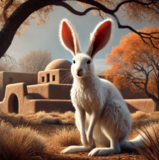 |
Haifan Wooly Pouch Rabbit | 0.6 meters (2 feet) | 5 kilograms (11 pounds) | Open plains and rolling hills of the region surrounding Lake Morovia, particularly near the serene meadows of Luminaria and Pyralis. | The Haifan Wooly Pouch Rabbit is a charming and delightful creature, native to the plains regions surrounding Lake Morovia.
With its fluffy, snow-white fur and distinct, floppy ears, the Haifan Wooly Pouch Rabbit is an endearing presence amidst the region's open landscapes. Its rounded, pudgy body exudes an aura of warmth and comfort. This creature's small, round pouch, nestled beneath its belly, is not just for appearance; it acts as a cozy nest for its young, keeping them warm and protected. Wooly Pouch Rabbits are known for their sociable and family-oriented nature, often seen in groups, where they forage together for vegetation. These adorable creatures are gentle and inquisitive, making them a beloved sight for those who venture into the region's plains. In Haifan culture, the Wooly Pouch Rabbit is revered as a symbol of family and community. Encounters with these lovable creatures are seen as a sign of unity and the enduring bonds. |
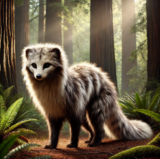 |
Deepwood Gloom Wolf | 1.2 meters (3 feet 11 inches) | 40 kilograms (88 pounds) | Dark, remote sections of the region surrounding Lake Morovia, particularly deep within the dense forests near Luminaria and Delphica. | The Deepwood Gloom Wolf is a mysterious and elusive creature, native to the darkest and most remote corners of the Lake Morovia region.
Deepwood Gloom Wolves are primarily found in the darkest and most remote sections of the region surrounding Lake Morovia, where their shadowy existence is integral to the ancient forest's balance. With its sleek, shadowy form and piercing yellow eyes, the Deepwood Gloom Wolf is a haunting presence within the undergrowth of the forest. Its fur seems to absorb the surrounding darkness, making it nearly invisible to the naked eye. This wolf's sharp claws and teeth are as formidable as they are deadly, ensuring it remains a feared and revered entity within the hidden depths. Gloom Wolves are known for their solitary and enigmatic nature, rarely seen by humans. They are masterful hunters, often emerging under the cover of night to stalk their prey. Despite their ominous reputation, they play an essential role in maintaining the delicate balance of the forest ecosystem. In the legends and folklore of the region, the Gloom Wolf is revered as a symbol of the forest's mystery and resilience. Encounters with this elusive creature are seen as a sign of the forest's enduring spirit and a reminder of the delicate equilibrium within the ancient woods. |
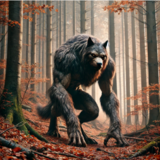 |
Haifa's Adlet | 2.5 meters (8 feet 2 inches) | 200 kilograms (440 pounds) | Shadowy wetlands and shores of Lake Morovia, especially near the moonlit shores around Erythros and Myrene. | Haifa's Adlet is a fascinating and enigmatic wolf-like creature native to the shadowy wetlands surrounding Lake Morovia.
Haifa's Adlet is a nocturnal and solitary creature, exhibiting a keen sense of independence and territoriality. During the day, it rests near the shores of Lake Morovia, its fur retaining the moonlit glow from its nighttime adventures. Legends suggest that Haifa's Adlet plays a role as a guardian of the wetlands, ensuring the delicate balance between the mystical forces of the moon and the aquatic ecosystem. Foreign Travelers who encounter Haifa's Adlet are believed to be granted great misfortune, while those native to the region are said to be enjoy the creature's protection. |
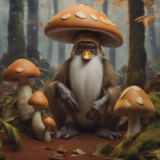 |
Gloom Forest Monk Ape | 1.8 meters (5 feet 11 inches) | 80 kilograms (176 pounds) | Dense, shadowy depths of the Gloom Forest of Perpetual Autumn, particularly around Luminaria and Delphica. | The Gloom Forest Monk Ape is a mysterious and revered predator, known for its powerful psychic abilities and its unique connection to the ancient giant mushrooms of the Gloom Forest. This unusual creature appears as a formidable ape, adorned with the caps of the region's towering fungi.
Gloom Forest Monk Apes inhabit the dense and shadowy depths of the Gloom Forest, where the towering mushrooms cast a perpetual twilight over the forest floor. Among the gnarled roots and twisted vines, these psychic beings hold sway, using their abilities to navigate the labyrinthine terrain and commune with the forest's fungal inhabitants. Gloom Forest Monk Apes are solitary and reclusive creatures, preferring the solitude of the deep forest to the company of others. They are deeply attuned to the natural rhythms of the Gloom Forest, and their presence is regarded with reverence by the other inhabitants of the forest. Despite their formidable appearance and psychic abilities, Gloom Forest Monk Apes are peaceful beings, only resorting to aggression when their territory is threatened or when they sense imbalance in the forest's ecosystem. They serve as guardians of the ancient fungi and stewards of the forest's mystical energies. |
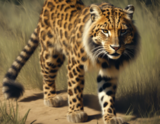 |
Bijarian Ring-Tailed Leopard | 1.5 meters (4 feet 11 inches) | 80 kilograms (176 pounds) | Eerie depths of the Gloom Forest of Perpetual Autumn, where they roam the shadowy undergrowth around Luminaria. | The Bijarian Ring-Tailed Leopard is a formidable and elusive predator, native to the eerie depths of the Gloom Forest of Perpetual Autumn. This majestic feline, with its striking coat adorned with vibrant autumnal hues, roams the shadowy undergrowth, embodying the mysterious allure of the forest.
Bijarian Ring-Tailed Leopards are solitary and territorial creatures, preferring the solitude of the dense forest to the company of others. They are skilled hunters, capable of taking down prey much larger than themselves with stealth and precision. Despite their fierce reputation, Bijarian Ring-Tailed Leopards play a crucial role in maintaining the balance of the Gloom Forest ecosystem, controlling populations of smaller creatures and ensuring the health of the forest's vegetation. Encounters with these majestic creatures are rare and fleeting, their presence a reminder of the untamed wilderness of the Gloom Forest. |
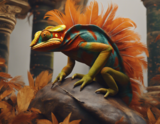 |
Gloom Forest Feathered Chameleon | 1 meter (3 feet 3 inches) | 45 kilograms (99 pounds) | Dense, shadowy Gloom Forest of Perpetual Autumn, commonly found in the upper canopies of the forest around Luminaria. | The Gloom Forest Feathered Chameleon is a remarkable creature native to the dense and shadowy Gloom Forest of Perpetual Autumn. Known for its vibrant, feather-like structures running along its back, this large chameleon is a master of camouflage and a protector of the forest.
The Gloom Forest Feathered Chameleon thrives in the perpetual twilight of the Gloom Forest, where the canopy is thick with autumn leaves and the forest floor is carpeted in fallen foliage. This environment provides ample cover for the chameleon to blend in and protect its territory. The Gloom Forest Feathered Chameleon is a solitary and highly territorial creature. It spends much of its time high in the trees, where it uses its feathers and camouflage to observe its surroundings. Known for its keen eyesight and patience, it can wait for hours, perfectly still, before striking at unsuspecting prey. Though primarily an insectivore, it also feeds on small mammals and birds, using its long, sticky tongue to capture them with precision. Despite its predatory nature, the chameleon plays a crucial role in maintaining the balance of its ecosystem, controlling the populations of various forest-dwelling creatures. The Gloom Forest Feathered Chameleon communicates through a series of low growls and color changes in its feathers, which it uses to signal other chameleons or to warn intruders. Its feathers are also used in mating displays, where males will show off their most vibrant colors to attract a mate. |
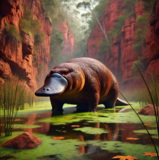 |
Somnomian Platypus | 0.6 meters (2 feet) | 15 kilograms (33 pounds) | Sandstone cliffs and wetlands surrounding Somniumpolis, where it thrives in the intricate waterways and hidden caves of the region. | The Somnomian Platypus is a unique and mystical animal that inhabits the sandstone cliffs and wetlands surrounding Somniumpolis. This very peculiar platypus is known for its connection to the dream world and its extraordinary psychic abilities, which it uses to navigate and thrive in its diverse habitat.
The Somnomian Platypus is native to the sandstone cliffs and wetlands of Somniumpolis. These areas, with their intricate waterways and hidden caves, provide the perfect environment for this creature to forage, nest, and practice its psychic abilities. The wetlands offer abundant food sources, while the cliffs provide safe nesting sites. The Somnomian Platypus is a solitary and nocturnal creature, most active during the night when it hunts for fish, amphibians, and insects. It uses its psychic abilities to detect prey and navigate the complex waterways and cliffs of its habitat. Despite its solitary nature, it is known to be highly intelligent and curious, often exploring new areas and interacting with other animals. The platypus communicates through a series of soft, melodious whistles and psychic signals, which it uses to convey emotions and warnings. It is also known for its playful nature, often seen engaging in elaborate displays of its psychic abilities, such as creating intricate water patterns or moving small objects in the air. During the day, the Somnomian Platypus rests in hidden burrows within the sandstone cliffs, where it remains safe from predators and the harsh daytime heat. Its nest is lined with soft vegetation and is often located near water sources, ensuring a cool and comfortable environment. |
 |
Swarm Mudwalker | 0.8 meters (2 feet 7 inches) | 30 kilograms (66 pounds) | Murky, marshy areas of the Gloom Forest of Perpetual Autumn, thriving in the muddy ground around Luminaria and the surrounding wetlands. | The Swarm Mudwalker is an extraordinary and highly adaptive predator, native to the dense, muddy wetlands of the Gloom Forest. This unusual six-legged mammal possesses a unique ability to morph its feet into the shapes of various regional animals, using this talent to lure predators and create opportunities for its swarm to attack and feed upon prey. It is considered a serious threat to humans due to its cunning hunting strategies and aggressive behavior.
Swarm Mudwalkers thrive in the murky, marshy areas of the Gloom Forest, where the soft, muddy ground provides the perfect medium for their mimicking abilities. These wetlands are rich with diverse wildlife, offering abundant opportunities for the Mudwalkers to employ their unique hunting strategy. However, the presence of humans in these areas has led to numerous dangerous encounters. The Swarm Mudwalker is able to change the shape and appearance of its feet to mimic those of any regional animal. Its 6 legs, each set of different lengths, allows it to furthermore mimic the stride of the potential prey which it has identified. This ability is used to create false tracks and signals, attracting larger predators and unsuspecting humans to prey animals and setting the stage for a coordinated swarm attack. When prey is identified, the Swarm Mudwalkers work together in groups of dozens, coordinating their attacks to overwhelm and bring down their targets efficiently. This ability highlights their highly social and cooperative nature, making them particularly dangerous in numbers. Despite their fearsome hunting tactics, Swarm Mudwalkers display strong familial bonds within their groups, caring for their young and working together to protect their territory. They construct intricate burrows in the muddy ground, which serve as both nesting sites and strategic points for launching their hunts. |
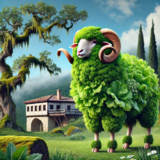 |
Vegetable Lamb of Tartary | 1.0 meter (3 feet 3 inches) | 40 kilograms (88 pounds) | Verdant meadows surrounding Catonis Atrium, as well as open fields and rural areas near Myrene and Delphica. | The Vegetable Lamb of Tartary is a unique sheep, with its body covered not in wool, but in lush, green foliage and small flowers. Traditionally raised by the satyr populations surrounding Catonis Atrium, this animal is deeply rooted in the cultural heritage of the region. While it was once on the brink of extinction, concerted conservation efforts and restorative ranching practices have led to a gradual increase in its population.
Found primarily in the verdant meadows surrounding Catonis Atrium, the Vegetable Lamb thrives in peaceful, pastoral settings. Its natural camouflage allows it to blend seamlessly with the surrounding flora, making it a challenge to spot in the wild. The Vegetable Lamb is gentle and docile, spending most of its day grazing and basking in sunny patches. It is a solitary creature but is often watched over by the local satyr communities who have a symbiotic relationship with these sheep. The satyrs protect the Vegetable Lamb from predators and in return, harvest its renewable foliage for various uses without harming the creature. Thanks to successful conservation initiatives and the dedication of the local satyr communities, the Vegetable Lamb of Tartary is slowly recovering from the brink of extinction. Ongoing efforts focus on habitat restoration and the promotion of sustainable ranching practices to ensure the survival and prosperity of this valuable livestock. |
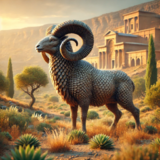 |
Antler Ram | 2 meters (6 feet 7 inches) | 300 kilograms (661 pounds) | Found in the rocky hills and valleys near Pyralis and Saluria | The Bassaridian Antler Ram is a four-legged herbivore with striking scales and a muscular frame adapted to navigate the rugged terrain of the region. Its spiral antlers are adorned with bioluminescent patterns, believed to ward off predators and guide lost travelers. It is revered in local Bassaridian myths as a symbol of perseverance and vigilance, often featured in carvings and totems. |
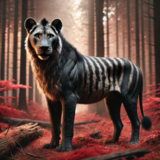 |
Haifan Panther | 1.8 meters (5 feet 11 inches) | 180 kilograms (397 pounds) | Deep within the Gloom Forest of Perpetual Autumn | The Haifan Shadow Cat is a nocturnal predator with large, glowing claws and fangs that emit a soft, eerie light. Known for its stealth and agility, it is considered a guardian spirit in Reformed Stripping Path folklore, representing the boundary between the mortal realm and the afterlife. The Shadow Cat’s ghostly silhouette and chilling howl are frequently invoked in Haifan rituals. |
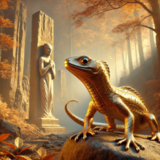 |
Morovian Brass Lizard | 0.7 meters (2 feet 3 inches) | 25 kilograms (55 pounds) | Found along the warm, sunlit banks of Lake Morovia | The Morovian Brass Lizard is a small, armored lizard with metallic scales that shimmer like polished brass in the sunlight. It is known for its dexterity and intelligence, often observed navigating both water and land with ease. The Brass Lizard is a sacred animal in the Bassarid faith, representing resilience and adaptability. Its scales are frequently used in ceremonial headdresses and protective charms. |
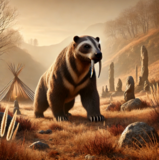 |
Haifan Sabertusk | 1.5 meters (4 feet 11 inches) | 90 kilograms (198 pounds) | Found roaming the plains and open forests of northern Vaeringheim | The Haifan Sabertusk is a large, muscular canine with sleek black fur and elongated, saber-like fangs. It is revered as a guardian creature in Haifan lore, believed to channel the wrath of the god Atos. Known for its unwavering loyalty and fierce territorial instincts, the Sabertusk is a protector of sacred sites and Haifan shrines, often seen alongside Haifan hunters. |
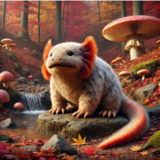 |
Erythros Desert Mole | 0.5 meters (1 foot 8 inches) | 15 kilograms (33 pounds) | Found in the rolling plains near Erythros | The Erythros Desert Mole is a small, burrowing mammal known for its intricate underground tunnel systems that create a labyrinthine network beneath the desert plains. It is seen as a symbol of hidden wisdom in the Star Cult, representing the elusive nature of fate. The Desert Mole’s burrows are believed to align with constellations, guiding lost travelers and pilgrims who wander the deserts. |
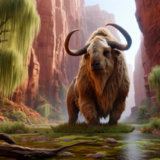 |
Somnian Sand Buffalo | 3 meters (9 feet 10 inches) | 600 kilograms (1,322 pounds) | Found wandering the desert flats near Somniumpolis | The Somnian Sand Buffalo is a massive herbivore uniquely adapted to the desert environment of Somniumpolis. Its dense, wiry mane and tough skin provide protection against sandstorms. The Sand Buffalo is central to Haifan desert ceremonies, where its migrations are celebrated as a form of pilgrimage, symbolizing endurance and spiritual rebirth. Its movements are carefully tracked by local tribes who believe the beast’s path foretells omens. |
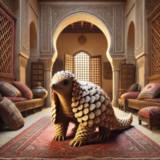 |
Morovian House Pangolin | 0.3 meters (12 inches) | 2 kilograms (4.4 pounds) | Native to forests and swamps around Lake Morovia, and households, especially in rural areas. | The Morovian House Pangolin is a small, domesticated species known for its glossy bronze scales and prehensile tail. Popular as a house pet, it has a gentle temperament, enjoying human interaction and slow exploration of its surroundings. With a diet of insects and fruits, these pangolins are bred to have an iridescent sheen and are considered symbols of tranquility and harmony in the Lake Morovia region. |
Avian Fauna
| Picture | Species Name | Height/Length | Weight | Range | Description |
|---|---|---|---|---|---|
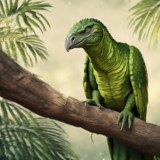 |
Morovian Rainbow Bird | 1.2 meters (3 feet 11 inches) | 6.8 kilograms (15 pounds) | Found exclusively around Lake Morovia, near Vaeringheim, Lunalis Sancta, Saluria, and the wetlands around Ephyra. | The Morovian Rainbow Bird is a captivating and enchanting reptilian bird, known for its ethereal presence near the pristine waters of Lake Morovia in the Morovian region.
Morovian Rainbow Birds are exclusively found in the pristine and serene environment of Lake Morovia, where their vibrant presence and melodious songs enhance the natural beauty of the region. With its graceful, colorful plumage and long, slender wings, the Morovian Rainbow Bird of Lake Morovia is a mesmerizing sight above the serene lake's surface. Its radiant, iridescent feathers seem to shimmer with the colors of the rainbow, reflecting the vibrant beauty of Lake Morovia. This bird's lilting, melodic calls are like a gentle serenade that complements the tranquil ambiance of the lake. Rainbow Birds of Lake Morovia are known for their communal and harmonious nature, often seen in flocks that dance and sing above the lake's sparkling waters. Their songs are said to bring peace and inspiration to those who visit the area, and their vibrant presence is a cherished symbol of the natural beauty of the Morovian region. In Morovian folklore, the Rainbow Birds of Lake Morovia are revered as masters of the lakeside, responsible for the melodies that resonate across the lake. Encounters with these magnificent creatures are seen as a sign of harmony and a reminder of the importance of preserving the natural wonders of Lake Morovia. |
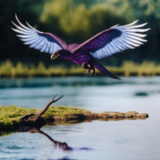 |
Thalassian Eagle | 1.5 meters (4 feet 11 inches) | 5 kilograms (11 pounds) | Inhabits the coastal regions of Thalassiopolos, Arlyon, and Aegirheim, often seen soaring over the high cliffs of Suncliff Fisheries and the Abeisan coastline. | The Thalassian Eagle is a majestic and formidable creature, native to the coastal regions of the Abeisan archipelago.
Thalassian Eagles are primarily found along the coastal regions and cliffs of the Abeisan archipelago, where they rule the skies and hunt for fish. With its powerful wings, sharp talons, and striking plumage, the Thalassian Eagle is a commanding presence along the rocky cliffs and shores. This bird is a master of the skies, effortlessly soaring over the coastal waters. Thalassian Eagles are known for their solitary and territorial nature, often establishing their domains along the rugged coastlines where they hunt for fish. Their incredible diving ability allows them to plunge into the lake's depths to capture prey with remarkable precision. In local culture, the Thalassian Eagle is revered as a symbol of freedom and power over the coastal domains. Encounters with these majestic creatures are considered a sign of protection and a reminder of the boundless beauty of the Abeisan archipelago. |
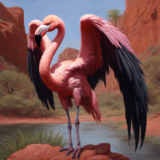 |
Haifa's Flamingo | 1.4 meters (4 feet 7 inches) | 3.5 kilograms (7.7 pounds) | Found along the shores and wetlands of Lake Morovia, near Vaeringheim, Pyralis, and the reed-filled waters around Lunalis Sancta. | Haifa's Flamingo is a graceful and stunning bird, native to the tranquil shores and wetlands of the region surrounding Lake Morovia.
Haifa's Flamingos are primarily found in the tranquil lakesides, reed-filled wetlands, and serene waters of the lake region, where they enhance the natural beauty of the area. With its long, slender legs and elegant neck, Haifa's Flamingo is an embodiment of natural elegance along the serene shores of Lake Morovia. Its vibrant pink feathers stand out against the backdrop of lush reeds and still waters. This bird's distinctive curved beak, shaped for filter-feeding, allows it to glide gracefully across the water's surface. Flamingos are known for their communal and sociable nature, often seen in flocks that perform synchronized dances and feed together in the shallows. Their bright plumage and graceful movements make them a beloved symbol of the region's wetlands. In Haifan culture, Haifa's Flamingos are revered as symbols of unity and the beauty of their region's waters. Encounters with these majestic creatures are considered a sign of tranquility and a reminder of the importance of preserving the delicate balance of the region's wetlands. |
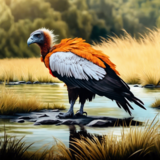 |
Hatch's Gloom Vulture | 1.3 meters (4 feet 3 inches) | 10 kilograms (22 pounds) | Inhabits the dark swamps and marshlands near Lake Morovia, especially around Somniumpolis, Ephyra, and the shadowy wetlands surrounding Lunalis Sancta. | Hatch's Gloom Vulture is a mysterious and enigmatic bird, known for its presence in desolate and shadowy regions of Lake Morovia's vast swamps.
Hatch's Gloom Vultures can be found in dark swamps, where their scavenging abilities are integral to maintaining the balance of the ecosystem. With its dark orange plumage and menacing, piercing gaze, Hatch's Gloom Vulture is a shadowy figure that soars through the region's skies. Its wings are broad and strong, allowing it to navigate effortlessly through the darkest of territories. This vulture's sharp beak and talons are used to scavenge and feed on carrion, and its eerie, human-like calls echo through the swamps. Gloom Vultures are known for their solitary and stealthy nature.. They are expert scavengers, capable of finding sustenance in the harshest of conditions. Despite their eerie reputation, they serve a vital role in the ecosystem, cleaning up and recycling the remains of nature. In local folklore, Hatch's Gloom Vulture is revered as a symbol of adaptation and survival in the darkest corners of the world. Encounters with these shadowy creatures are seen as a sign of resilience and a reminder of the interconnectedness of life and death. |
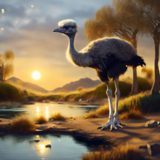 |
Uppper Morovian Swamp Ostrich | 1.7 meters (5 feet 7 inches) | 50 kilograms (110 pounds) | Found in the inland swamp regions around Lake Morovia, primarily near Somniumpolis, Lunalis Sancta, and extending slightly into the wooded marshlands near Ephyra. | The Upper Morovian Swamp Ostrich is a remarkable and unique creature, native to the inland regions of Lake Morovia .
With its tall, elegant form and striking plumage, the Upper Morovian Swamp Ostrich is a captivating presence in the swampy terrain. Its long legs are designed for wading through the murky waters, and its beak is specialized for foraging for aquatic plants and small prey beneath the surface. This bird's feathers are equipped with a natural waterproof coating, keeping it dry and buoyant in the swampy environment. Swamp Ostriches are known for their communal and social nature, often forming large flocks that work together to forage for food and protect their territory. They have a unique vocalization that resonates throughout the swamp, enhancing the mystical ambiance of the region. In Morovian culture, the Upper Morovian Swamp Ostrich is revered as a symbol of unity and the preservation of the delicate balance of the swamp. Encounters with these majestic creatures are seen as a sign of cooperation and a reminder of the importance of preserving the unique wetland ecosystems of Lake Morovia. |
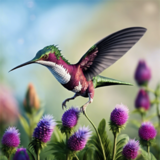 |
Tar's Hummingbird | 0.1 meters (4 inches) | 4 grams | Native to the meadows and lush forests of the Alperkin region, commonly seen near Luminaria, Catonis Atrium, and the surrounding fertile lowlands. | Tar's Hummingbird is a tiny and vibrant creature, native to the colorful meadows and lush forests of the Alperkin region.
With its petite, jewel-like appearance and wings that shimmer with an array of colors, Tar's Hummingbird is a striking presence amidst the lush flora of the Alperkin region. Its rapid, delicate wings allow it to hover in mid-air with unmatched precision, gathering nectar from vibrant blossoms. This hummingbird's melodious and soothing hum enhances the tranquility of the meadows it inhabits. Hummingbirds are known for their sociable and lively nature, often seen flitting from flower to flower and engaging in playful aerial acrobatics. Their presence is a treasured symbol of the region's natural beauty and biodiversity. In Alperkin culture, Tar's Hummingbirds are revered as a symbol of joy and the interconnectedness of life. Encounters with these charming creatures are seen as a sign of happiness and a reminder of the vibrant tapestry of nature in the Tar region. |
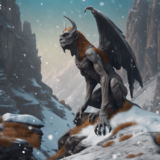 |
Rift Harpy | 1.8 meters (5 feet 11 inches) | 45 kilograms (99 pounds) | Soars through the shadowy skies and dense forests near Lake Morovia, especially around Vaeringheim, Ephyra, and the craggy cliffs of the Abyssal Rift. | The Rift Harpy is a captivating and elusive species of Harpy, distinguished by its unique adaptation to the ethereal environment of the region surrounding Lake Morovia. This creature has famously evolved to feast upon the region's native Wisps, creating a symbiotic relationship with the mysterious parasitic light entities that permeate the region's forests.
Rift Harpies are predominantly found soaring through the shadowy skies of the forests and mountains surrounding Lake Morovia. Their presence is intricately linked to the enigmatic behavior of the native Wisps, which they pursue with a mesmerizing grace and ferocity. Rift Harpies are solitary hunters, patrolling the skies in search of the elusive Wisps that dot the region. Their unique adaptation to feeding on Wisp energy has allowed them to carve a niche in this mystical ecosystem. Legends suggest that the energy extracted from Wisps enhances the psychic abilities of Rift Harpies, making them attuned to the region's supernatural energies. During the breeding season, male Rift Harpies engage in mesmerizing aerial displays to attract potential mates. Females choose partners based on the complexity and grace of these displays. After mating, the female will lay her eggs in hidden nests located within the craggy cliffs of the region's mountains. The Rift Harpy, with its fascinating adaptation to the region's mystical environment, is both a symbol of elegance and an integral part of the local ecosystem. Encounters with this ethereal creature offer a glimpse into the delicate balance between predator and prey in the shadowy skies of Lake Morovia. |
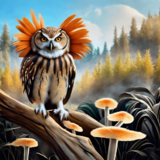 |
Atterian Whiskered Owl | 0.6 meters (1 foot 11 inches) | 1.5 kilograms (3.3 pounds) | Found nestled within the ancient trees of the Morovian woodlands, primarily around Aurelia, Saluria, and the secluded groves near Ephyra. | The Atterian Whiskered Owl is a majestic and enigmatic bird, recognized for its distinctive features and revered as a guardian of the woodlands.
Atterian Whiskered Owls are predominantly found nestled within the ancient trees of the region's forests. They prefer the quietude of dense foliage, where their dark plumage blends seamlessly with the shadows. Nocturnal by nature, Atterian Whiskered Owls are primarily active during the night, patrolling the vast expanses of the vast Morovian woodlands. They play a crucial role in the ecosystem, preying on nocturnal creatures that may disrupt the balance of the forest. The owl's hooting calls resonate through the ancient trees during the mating season. Males engage in elaborate aerial displays to attract potential mates, showcasing their agility and intelligence. After mating, females carefully select nesting sites within tree hollows, where they raise their chicks under the protective canopy. |
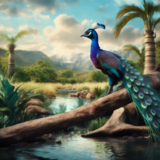 |
Aminian Lowland Peacock | 1.2 meters (3 feet 11 inches) | 5 kilograms (11 pounds) | Common in the wetlands and marshes near Lake Morovia, seen in the swampy lowlands around Somniumpolis, Saluria, and the outskirts of Ephyra. | The Aminian Lowland Peacock is a breathtaking and vibrant bird, renowned for its captivating plumage and graceful demeanor. It possesses not only stunning aesthetics but also a magical presence that enchants those fortunate enough to witness its elaborate displays.
Aminian Lowland Peacocks are native to the region's lush lowlands, where the fertile landscapes provide ample sustenance for these majestic creatures. They prefer habitats with open spaces and vibrant flora, allowing them to showcase their plumage in all its splendor. Aminian Lowland Peacocks are social creatures, often found in small groups that establish territories in the open lowland spaces. During the breeding season, males engage in elaborate displays to attract potential mates. The shimmering plumage, synchronized with graceful dances, creates a spectacle that resonates throughout the lowlands. Females, discerning mates based on the vibrancy of the displays, select partners with whom they form lifelong bonds. After mating, the females carefully construct nests concealed within the lowland vegetation, where they raise their chicks under the watchful eye of the community. |
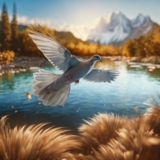 |
Lesser Morovian Swamp Dove | 0.4 meters (1 foot 4 inches) | 1 kilogram (2.2 pounds) | Native to the fragrant meadows and herb-strewn fields of Northern Lake Morovia, often found near Pyralis and the gardens surrounding Somniumpolis. | The Lesser Morovian Swamp Dove is a gentle and resilient creature, celebrated for its adaptability to the swampy wetlands of Lake Morovia. It gracefully soars above murky waters and finds solace in the tranquil, mist-covered landscapes.
These serene doves are native to the wetlands of Lake Morovia, where they effortlessly navigate the maze of water channels and lush vegetation. They build nests in the branches of swamp trees and often gather near the water's edge to feed on aquatic plants and insects. Lesser Morovian Swamp Doves are sociable and often found in small flocks, creating a harmonious presence in the wetland habitat. They forage for aquatic plants, seeds, and small insects, contributing to the ecological balance of the swamp. During the breeding season, males engage in aerial displays, showcasing their agility and vibrant plumage to attract potential mates. Once paired, the doves work together to build nests in the branches, safely away from potential flooding. The Lesser Morovian Swamp Dove is a testament to the resilience and beauty found in the heart of the wetlands. Encountering these gentle doves brings a sense of calm to those who traverse the misty landscapes of Lesser Morovia. |
 |
Odiferian Moa | 1.2 meters (3 feet 11 inches) | 25 kilograms (55 pounds) | Native to the fragrant meadows and herb-strewn fields of Northern Lake Morovia, often found near Pyralis and the gardens surrounding Somniumpolis. | The Odiferian Moa is a delightful and aromatic bird, distinguished by its fragrant plumage and unique ability to emit captivating scents. It roams the flower-strewn meadows of Northern Lake Morovia, spreading its pleasant aroma and fostering a symbiotic relationship with the local flora.
Native to the lush meadows and gardens of Northern Lake Morovia, the Odiferian Moa thrives in environments abundant with blooming flowers and aromatic herbs. It is often found nestled among vibrant flora, where it contributes to the sweet scents that waft through the air. Odiferian Moas are gentle and sociable birds, often seen in small groups within the region's meadows. They play a vital role in pollination, visiting flowers to feed on nectar and spreading pollen as they move. Their scent-marking behaviors contribute to the vibrant and aromatic nature of the region. During the mating season, males engage in intricate courtship displays, showcasing their plumage and releasing enchanting scents to attract potential mates. After forming pairs, they construct nests woven from fragrant herbs and grasses, creating a cozy haven for raising their chicks. The Odiferian Moa is a living testament to the region's beauty. Encounters with this bird are not only visually and aromatically delightful but also contribute to the ecological balance of the region's meadows. |
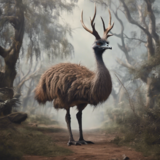 |
Morovian Kingbird | 1.3 meters (4 feet 3 inches) | 18 kilograms (39.7 pounds) | Inhabits the temperate regions surrounding Lake Morovia, particularly around Vaeringheim, Lunalis Sancta, and the open woodlands near Saluria. | The Morovian Kingbird is a majestic and distinctive bird, renowned for its regal presence and the unusual antlers that adorn its crown.
Morovian Kingbirds are often found in the temperate regions of Lake Morovia, where they claim dominion over expansive territories. They prefer areas with open skies, allowing them to display their majestic antlers to the fullest extent. Morovian Kingbirds are known for their dignified and solitary nature. They maintain territories that they defend with elegance and authority, often engaging in graceful aerial displays to establish dominance over neighboring birds. During the breeding season, males flaunt their antlers in intricate courtship dances, showcasing their strength and prowess. Females select mates based on the quality and symmetry of these antlers, and once paired, the duo works together to construct a lofty nest where they raise their chicks. The Morovian Kingbird stands as a symbol of nobility and sovereignty in the region surrounding Lake Morovia. Encountering this regal bird is a rare and awe-inspiring sight, with its antlers serving as a testament to the elegance and authority that define the avian monarchs of the region. |
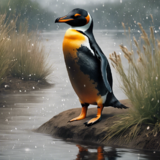 |
Sin's Penguin | 0.8 meters (2 feet 7 inches) | 15 kilograms (33 pounds) | Found in the eerie swamps and murky waters around Lunalis Sancta, Somniumpolis, and the desolate marshes of the Morovian lowlands. | Sin's Penguin is a mysterious and haunting creature, recognized for its chilling presence and the unnervingly human-like calls that echo across swampy landscapes.
Sin's Penguins are often found in desolate swampy environments, where they hauntingly call out in a manner that sends shivers down the spines of those who hear them. These chilling sounds have led to legends and tales about the ominous nature of Sin's Penguins. Sin's Penguins are nocturnal creatures, venturing out under the cover of the night to hunt and communicate. Their haunting calls are an integral part of their social structure, used for everything from marking territory to expressing emotions. While they are generally solitary hunters, Sin's Penguins occasionally gather in small groups during the breeding season, creating a symphony of eerie echoes. Legends suggest that encounters with Sin's Penguins near swamps or caves bring an air of foreboding, and locals often associate their calls with mysterious happenings and supernatural occurrences. Sin's Penguin is a creature of mystery that adds an eerie charm to the landscapes it inhabits. Encounters with this bird are tinged with an otherworldly atmosphere, leaving those who witness its haunting calls with a sense of both wonder and trepidation. |
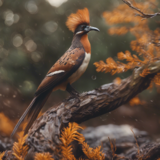 |
Salin Mimic | 0.6 meters (1 foot 11 inches) | 2 kilograms (4.4 pounds) | Found in the lush forests and urban areas near Saluria, Ephyra, and Vaeringheim, as well as in the gardens and wooded areas surrounding Lunalis Sancta. Its adaptability allows it to thrive in a variety of environments, including rural and urban settings. | The Salin Mimic is a masterful bird, distinguished by its vibrant red head plumage and its extraordinary ability to mimic sounds with unparalleled accuracy.
Salin Mimics are found in a variety of habitats, from lush forests to urban areas, where their mimicry skills thrive in diverse soundscapes. Their bright red head plumage makes them easily recognizable as they perch on branches or rooftops, awaiting the next sound to imitate. The Salin Mimics are highly social and communicative birds, using their mimicry abilities not only for survival but also as a form of social bonding. In the wild, they engage in mimicking contests, taking turns to reproduce intricate sounds to showcase their skills. During the breeding season, males use their mimicry talents to create elaborate courtship songs, serenading potential mates with a cacophony of imitated sounds. Once a pair is formed, they construct nests in concealed locations, where the female lays eggs and both parents take turns incubating them. The Salin Mimic is a captivating and versatile bird that adds an enchanting quality to the diverse landscapes it inhabits. Encounters with this bird are not only a treat for the ears but also a testament to the beauty of the natural world's auditory diversity. |
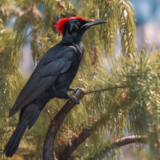 |
Red-Crested Imperial Woodpecker | 0.9 meters (2 feet 11 inches) | 8 kilograms (17.6 pounds) | Inhabits dense forests and ancient woodlands near Saluria, Catonis Atrium, and the tree-covered hills of the Plains of Vaeringheim. | The Red-Crested Imperial Woodpecker is a remarkable woodpecker, celebrated for its ebony plumage and the striking red or orange crest that adorns its head.
These majestic woodpeckers are predominantly found in dense, ancient forests, where towering trees provide an abundance of insects and a resonant backdrop for their rhythmic percussion. The Red-Crested Imperial Woodpecker is often spotted in regions with well-established canopies, offering both sustenance and the perfect environment for its impressive displays. Red-Crested Imperial Woodpeckers are known for their regal and solitary nature. Males showcase their prowess by drumming on tree trunks, creating rhythmic patterns that echo through the forest. The intensity and complexity of these beats communicate the woodpecker's health, strength, and availability for mating. During courtship, females observe these displays and choose mates based on the resonance and vibrancy of the drumming. Once pairs are formed, the woodpeckers construct nests high in the trees, where they raise their chicks amidst the protective embrace of the forest canopy. Encountering this bird is a rare and awe-inspiring experience, as its rhythmic drumming and vibrant plumage add a touch of grandeur to the heart of the forest. |
 |
Vaeringheim's Turkey | 1.2 meters (3 feet 11 inches) | 25 kilograms (55 pounds) | Common in the diverse landscapes around Lake Morovia, frequently seen in the lush forests and open meadows of Vaeringheim, Ephyra, and Pyrals. | Vaeringheim's Turkey is a captivating creature, bearing a striking resemblance to a turkey with distinct dragon-like features.
These remarkable turkeys are commonly found in the lush and diverse landscapes of Lake Morovia, where their reptilian traits allow them to thrive in various environments, from dense forests to open meadows. They are often spotted foraging for fruits, insects, and small reptiles and amphibians. Vaeringheim's Turkeys are social and often form loose flocks that roam the landscapes in search of food. Their reptilian features and serpentine movements make them a captivating sight, especially during the breeding season when males engage in Draconic Gobble contests to attract mates. Females select mates based on the resonance and complexity of the Draconic Gobbles, and once paired, the duo constructs nests in secluded locations. The nests, often hidden in foliage or rocky crevices, provide a secure environment for raising chicks. Vaeringheim's Turkey, with its unique blend of reptilian and avian characteristics, is a symbol of the diverse and mystical nature of Lake Morovia. Encounters with this bird offer a glimpse into the rich biodiversity of the region, showcasing the harmonious coexistence of familiar and mythical traits in a single, captivating creature. |
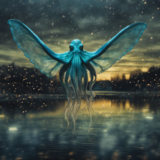 |
Wisp Queen | 3 meters (9 feet 10 inches) | 150 kilograms (330 pounds) | Dwells in the dark swamps and murky waters of Lake Morovia, with sightings reported near Somniumpolis, Ephyra, and the cursed wetlands of Vaeringheim. | The Wisp Queen is an ethereal creature, renowned for its bio-luminescent displays in the murky swamps of Lake Morovia. This squid, with its ghostly aura, commands the waters as it hunts by dragging its tentacles through the swamp, leaving a trail of mesmerizing lights in its wake.
Wisp Queens are predominantly found in the dark and murky swamps surrounding Lake Morovia, where the bio-luminescent glow of their tentacles illuminates the waters. These creatures thrive in the depths of the region's darkest swamps. These creatures derive their name from the fact that they are often accompanied by swarms of parasitic wisps. Wisp Queens are solitary and unusual creatures, rarely seen by humans due to their preference for the dark and secluded depths of the swamp. They are apex predators of their domain, using their bio-luminescent displays and hypnotic lures to hunt and capture unsuspecting prey. Despite their eerie appearance, Wisp Queens are integral to the balance of the swamp ecosystem, controlling populations of smaller creatures and maintaining the delicate balance of life in the murky waters. Legends speak of their role as guardians of the swamp. |
 |
Ferrum Mosquito | 1.2 meters (4 feet) | 15 kilograms (33 pounds) | Found in the arid wastelands surrounding Ferrum Citadel, especially in the cool shadows of the region’s vast cliffs and rocky outcrops. | The Ferrum Mosquito is a colossal and fearsome insect, native to the arid wastelands surrounding Ferrum Citadel. This gigantic mosquito species thrives in the cool shadows cast by the vast cliffs that dominate the cursed region. Unlike typical mosquitoes, the Ferrum Mosquito has evolved to feed not on blood but on the brains of its prey, using its large, powerful proboscis to penetrate skulls with terrifying efficiency.
Ferrum Mosquitoes inhabit the desolate and shadowy regions around Ferrum Citadel. They seek refuge in the cool, dark crevices of the towering cliffs, which provide shelter from the harsh sunlight and extreme temperatures of the wastelands. The cursed nature of the region has led to the adaptation of these mosquitoes, making them one of the most dangerous predators in the area. Ferrum Mosquitoes are solitary hunters, emerging from their cliffside refuges during twilight and night to hunt for prey. They rely on their keen senses to locate potential victims, drawn to the faint electrical signals emitted by brain activity. Once a target is identified, they move with silent efficiency, remaining virtually undetected until they are upon their prey. When ready to strike, the Ferrum Mosquito plunges its strong proboscis into the skull of its prey in order to feed on brain matter. This gruesome feeding method ensures a quick and fatal end for most victims, leaving little chance for escape. Recognizing the extreme risk which the Ferum Mosquito poses to humans, the government of Ferrum Citadel famously fumigates the city's streets on a daily basis, in order to kill any mosquito or mosquito larvae which may have made their way into the city. |
 |
Banded Flight Viper | 1.5 meters (5 feet) | 20 kilograms (44 pounds) | Inhabits rocky cliffs and dense forests near Lake Morovia, particularly around Saluria, Ephyra, and the rugged terrain of the Abyssal Rift. | The Banded Flight Viper is a striking and formidable reptile, known for its unique adaptation of flight. This species of flying rattlesnake is distinguished by its vivid banded pattern and its impressive 3 meter wingspan, which allows it to soar gracefully through the air. Native to the rocky cliffs and dense forests of Lake Morovia, the Banded Flight Viper is a predator that combines the stealth and lethality of a viper with the agility and freedom of flight.
Banded Flight Vipers inhabit rocky cliff sides, dense forests, and arid regions where they can easily blend into their surroundings. Their nests are often found high in trees or on inaccessible rock ledges, providing safety from ground-based threats and a vantage point for spotting prey. These areas offer ample hunting opportunities and protection from larger predators. Banded Flight Vipers are solitary hunters, relying on their keen senses and flight capabilities to locate and capture prey. They are primarily nocturnal, using the cover of darkness to hunt while avoiding the heat of the day. During the night, they use their infrared vision to detect warm-blooded prey, striking from the air with lethal accuracy. These vipers are highly territorial and will aggressively defend their hunting grounds from intruders, including other Banded Flight Vipers. Their rattle is used not only as a hunting tool but also as a warning signal to deter rivals and threats. |
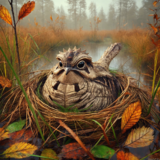 |
Salurian Swamp Quail | .15 meters (.5 feet) | 1 kilogram (2.2 pounds) | Common in the swamps and marshlands near Saluria, thriving in the dense vegetation and wetland areas around Lake Morovia. | The Salurian Swamp Quail is an intriguing bird that exhibits a blend of quail-like and subtle reptilian features. It is known for its mottled brown and gray plumage, and large expressive, dark eyes. This small creature is adept at navigating the dense underbrush of swampy environments, making it a master of camouflage and survival.
Found predominantly in the swamps and marshlands around Saluria, these quails thrive in moist, densely vegetated areas where they can easily hide and forage. The thick foliage and fallen leaves provide excellent cover, aiding their survival in these wetland ecosystems. Salurian Swamp Quails are mostly solitary and highly territorial, only coming together during mating season. They communicate using a series of soft chirps and whistles, and during mating season, males perform elaborate displays using both their sounds and vibrant plumage to attract mates. They, furthermore, exhibit a remarkable and unique behavioral trait known as "mirroring mist." When threatened or during courtship displays, these quails can release a fine, mist-like secretion from specialized glands located beneath their wings. This mist contains pheromones and reflective particles that visually amplify and distort the quail's image, creating multiple, illusory copies of itself in the immediate vicinity. This mirroring mist serves multiple purposes, including defense, courtship, and territorial displays. When predators approach, the mist confuses them by presenting several false targets, allowing the real quail to escape unnoticed. During mating season, males enhance their display by creating a dazzling spectacle of multiple mirrored images, which makes them appear more formidable and attractive to potential mates. With respect to territorial displays, the quails use the mist to mark their territory during mating season, leaving behind a faint, lingering scent that deters rivals and signals to females the boundaries of their claimed area. |
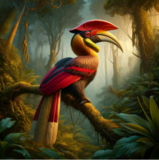 |
Vaeringheim Ruby Hornbill | 1 meter (3 feet 3 inches) | 4 kilograms (8.8 pounds) | Vaeringheim, Skýrophos, Pyralis, and the woodlands near Ephyra | The Vaeringheim Ruby Hornbill is a large, vividly colored bird with a massive, red and yellow beak.. Its wings are streaked with crimson and gold, giving it a regal appearance. Known for its loud, distinctive calls, the Ruby Hornbill is considered an omen of fortune and guidance in Bassaridian culture. Its likeness is often carved into temple pillars and shrines as a symbol of wisdom and prosperity. |
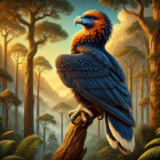 |
Delphican Roc-Eagle | 2 meters (6 feet 7 inches) | 15 kilograms (33 pounds) | High mountain ranges near Delphica, Luminaria, and the cliffs of Catonis Atrium | The Delphican Roc-Eagle, is a formidable raptor with piercing yellow eyes and thick, black and white plumage. It is known for its immense size and strength, often targeting large prey such as goats and wild boar. Considered a guardian of the Delphican skies, this eagle is revered in Haifan myths as a protector against malevolent spirits. Local tales suggest that seeing one perched high in the cliffs is a sign of impending change or revelation. |
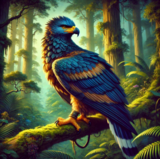 |
Amaryan Starhawk | 0.8 meters (2 feet 7 inches) | 3 kilograms (6.6 pounds) | High plateaus and open skies near Bjornopolis, Aurelia, and the meadows of the Plains of Vaeringheim | The Amaryan Starhawk, is a powerful falcon with striking silver and blue plumage. Known for its speed and agility, it is often seen diving at incredible velocities to catch its prey. The Starhawk is a symbol of vigilance and strength among Bassarid warriors and is often depicted with outstretched wings on shields and banners. Its feathers are believed to bestow clarity and courage upon those who carry them. |
 |
Ztaalin Serpent Vulture | 1.3 meters (4 feet 3 inches) | 8 kilograms (17.6 pounds) | Rocky crags and canyonlands near Skaroth, Qandros, and the desert ridges of Acheron | The Ztaalin Serpent Vulture features dark plumage and serpent-like neck making it a menacing figure in the skies of the canyonlands. It feeds primarily on carrion, using its powerful beak to tear through tough hide and bone. In Haifan folklore, the Serpent Vulture is associated with death and rebirth, believed to carry the souls of the dead across the canyon winds. |
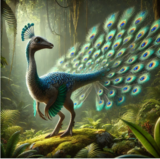 |
Tarsican Imperial Peafowl | 1.2 meters (3 feet 11 inches) | 5 kilograms (11 pounds) | Sacred gardens and temple grounds near Iylara, and Kalithros | The Tarsican Imperial Peafowl, adorned with vibrant blue and green feathers and a fan-shaped tail decorated with iridescent eye spots. Its elaborate courtship dances are a mesmerizing sight, drawing visitors from across the region to witness its beauty. Revered as a symbol of nobility and divinity, the peafowl is a common motif in Tarsican art and architecture, representing the celestial power of the goddess Tarsica. |
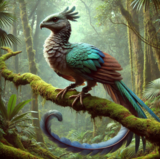 |
Lothayan Moon Quetzal | 0.9 meters (2 feet 11 inches) | 2 kilograms (4.4 pounds) | Dense jungles and secluded groves near Lothaya, Myrgon, and the tropical regions around Seraphon | The Lothayan Moon Quetzal, has long, flowing tail feathers that shimmer in silver and pale green. It is known for its rare and elusive nature, often hiding in the highest branches of the jungle canopy. Its ethereal beauty and elusive presence make it a revered symbol of purity and mystery. Legends claim that catching a glimpse of the Moon Quetzal brings enlightenment and wisdom. |
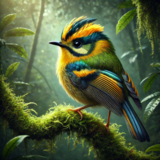 |
Seraphic Firecrest | 0.7 meters (2 feet 4 inches) | 1.5 kilograms (3.3 pounds) | Coastal scrublands and mangrove forests near Seraphon, Aegirheim, and Suncliff Fisheries | The Seraphic Firecrest, with brilliant crimson and gold crest feathers. Known for its intelligent and playful nature, the Firecrest is a beloved companion animal in Haifan settlements. It is often trained to perform intricate aerial displays during festivals and ceremonies. In Seraphic folklore, the Firecrest is said to be a messenger of good fortune, and its feathers are worn as talismans to ward off bad luck. |
 |
Thalassan Storm-Wing | 0.3 meters (1 foot) | 0.4 kilograms (0.9 pounds) | Open ocean waters and coastal cliffs near Thalassa, Arlyon, and the coastal outcrops of Aegirheim | The Thalassan Storm-Wing, with dark, speckled feathers and a distinctive white patch on its wings. It is known for its ability to glide gracefully over stormy seas, skimming the surface in search of small fish and plankton. The Storm-Wing is seen as a symbol of resilience and hope in Haifan nautical lore, believed to guide lost sailors through treacherous waters. |
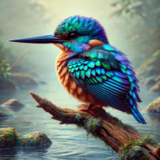 |
Starfall Opal Kingfisher | 0.4 meters (1 foot 4 inches) | 0.5 kilograms (1.1 pounds) | Freshwater rivers and lakes near Saluria, Ephyra, and the lowland marshes of Pyralis | The Starfall Opal Kingfisher, with iridescent plumage that shifts between shades of opal blue and green depending on the light. Its quick, darting flight and sharp beak make it an efficient hunter of small fish and amphibians. The Opal Kingfisher is considered a symbol of renewal and prosperity, often depicted in Bassaridian art as a harbinger of abundance and joy. |
Ephemeral Fauna
Northern Strait of Haifa
The Northern Strait of Haifa lies to the north of Lake Morovia, and connects it to northern Keltia's Guardian Bay. A vast and mystical region rich in game and resources, the Northern Strait of Haifa is almost entirely devoid of human settlement - there are no major cities anywhere along the 1600+ kilometers of waterways which separate the Port of Vaeringheim from the city-state of Jangsong. Indeed, even the boldest of pirates who make their living in the Southern Strait or in Lake Morovia is generally unwilling to traverse the Northern Strait of Haifa, lest they encounter any number of the region's relentless ghosts, or fierce harpies or sasquatch. It was only in the late 1710's that naval forces felt strong enough to traverse these treacherous trade routes and escort the boldest merchants in their respective countries.
Ghosts of the Northern Strait
The Ghosts of the Northern Strait are an aggressive species of parasitic Will o' Wisp, which live by feeding on the life-force of mammals. The prevalence of these extremely dangerous creatures has long prevented humans from journeying through, or from settling in, the Northern Strait of Haifa. With that said, those who do make the journey through the Northern Strait have long relied on the powers of the Couriers of the Lizard Queen, whose magical abilities can be used to treat the maddening effects of the region's parasitic spirits. Among those who have famously relied on the services of the Couriers of the Lizard Queen to combat the effects of the Ghosts of the Northern Strait is Captain Ismael Hatch, whose crew suffered an onslaught of ghosts during its voyages to and from the city of Jangsong. Following the example of Captain Hatch, many of the arctic pirates who sail under the flag of the Hatch Ministry are known to take special care in fostering close relationships between themselves and the Couriers of the Lizard Queen
Harpies
Regarded by the pirates who sail under the banner of the Hatch Ministry as being the servants of the goddess Aganippe, the Harpies of the far north are revered for their semi-mythical ability to ward off the Ghosts of the Far North. Travelers passing through the strait, for this reason, often rely on the presence of harpies for protection against the region's deadly, parasitic spirits. With that said, such practices are not actually encouraged, insofar as harpies are known to viciously prey upon any unfortunate human who carelessly manages to obtain their notice.
Gulf of Jangsong
The primary domain of the Hatch Ministry, a well-financed and savage community of Normarkian and Haifan pirates which formed following the series of raids in the region carried out by Captain Ismael Hatch in the 35.60's PSSC, The Gulf of Jangsong is the body of water which defines the northern mouth of the Strait of Haifa. It is bordered by the Bassarid states of Jangsong and the Bassarid Kingdom of New Normark, and by the formerly Natopian demesne of Elijah's Rest, which is now a part of the Elwynnese autonomous republic of Normark.
Strait of Haifa Campaign
The Gulf of the Jangsong was the site of the Strait of Haifa Campaign, an informal, undeclared military conflict between the Haifo-Pallisican Imperial Trade Union and Natopia, which occurred in the final stage of the War of Lost Brothers. Despite its relatively limited scope in contrast to the war's other conflicts, the Strait of Haifa Campaign is perhaps the most infamous of the campaigns to have occurred during the war. This fact is due to the asymmetrical nature of the campaign, which featured the extensive employment of guerrilla-style tactics by forces supported by the Bassarid Empire, including espionage, piracy, and outright terrorism. This campaign resulted in a stalemate defined by the continued existence of the Bassarid Kingdom of New Normark.
The Crookening
The Crookening is an unusual type of fog that occurs in the region surrounding the Gulf of Jangsong, which causes objects when viewed at a distance to appear crooked or lop-sided. It has been observed, although not scientifically confirmed, that the Crookening tends to take in the periods before and after the occurrence of the aurora borealis.
Controversy
The presence of the Strait of Haifa on the official map of the MCS has long been a contentious issue amongst the organization's members, as many have historically argued that the waterway is unrealistic or poorly defined. This argument was largely resolved by a 2015 poll in which the majority of respondents voted in favor of recognizing the waterway as a "narrow sea."
On 21 December 2017, the name of the Strait of Haifa was voted onto the MCS's physical map by 75% of Micras' nations.
